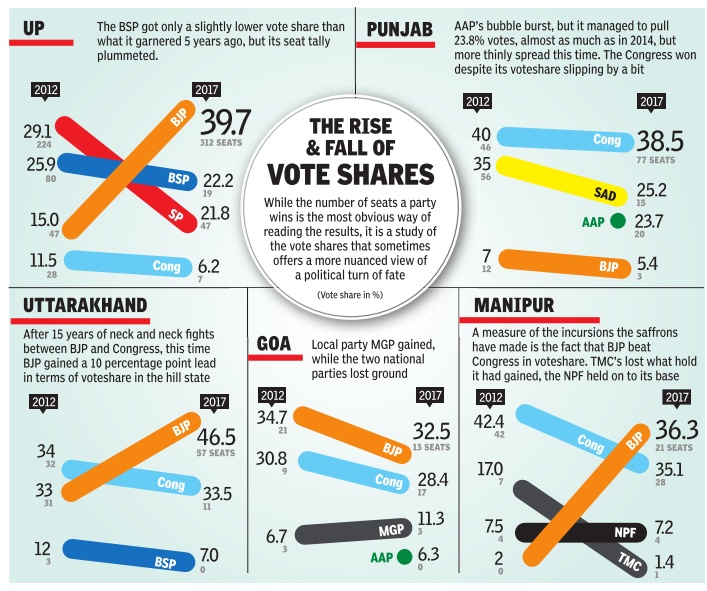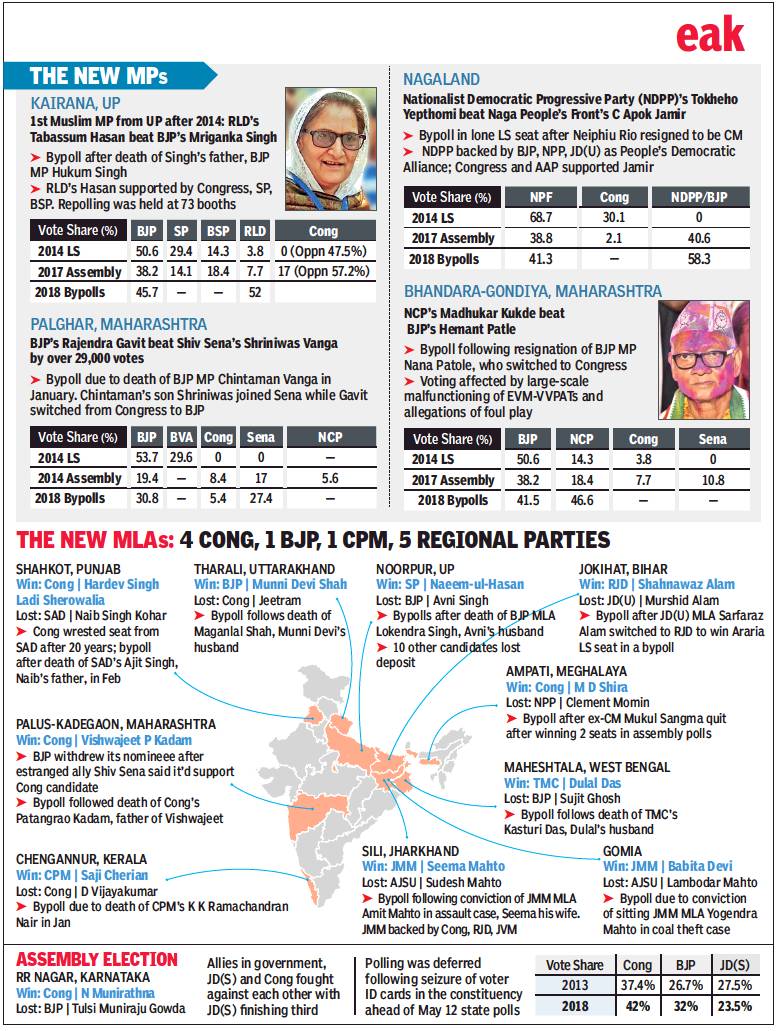India: A political history, 1947 onwards
(→1952-2014) |
(→Farmers’ agitations) |
||
| Line 1,223: | Line 1,223: | ||
What we see at the borders of Delhi are the brave frontrunners. Behind them, applauding and supporting their courage is the vast majority back in villages who have organised themselves to manage the farms and cattle of the farmers at our gate. The sincerity of the protestors, who call themselves ‘nai azaadi ke paravane’, is resonating with many people while attempts to brand them by terrorist intent or political affiliation have failed. The ruling dispensation have been well advised not to send out their anti-protest storm troopers as they are dealing with a tough lot who are not deterred by cold water cannons or dug up roads. This may well turn out to be the winter of discontent for the government. | What we see at the borders of Delhi are the brave frontrunners. Behind them, applauding and supporting their courage is the vast majority back in villages who have organised themselves to manage the farms and cattle of the farmers at our gate. The sincerity of the protestors, who call themselves ‘nai azaadi ke paravane’, is resonating with many people while attempts to brand them by terrorist intent or political affiliation have failed. The ruling dispensation have been well advised not to send out their anti-protest storm troopers as they are dealing with a tough lot who are not deterred by cold water cannons or dug up roads. This may well turn out to be the winter of discontent for the government. | ||
| − | [[Category:History|P INDIA: A POLITICAL HISTORY, 1947 ONWARDSINDIA: A POLITICAL HISTORY, 1947 | + | = Historical wounds= |
| − | + | == Somnath to Ayodhya: 1951-2019== | |
| − | [[Category:India|P INDIA: A POLITICAL HISTORY, 1947 ONWARDSINDIA: A POLITICAL HISTORY, 1947 | + | [https://epaper.timesgroup.com/Olive/ODN/TimesOfIndia/shared/ShowArticle.aspx?doc=TOIDEL%2F2019%2F11%2F10&entity=Ar01005&sk=510AEFDA&mode=text Amulya Gopalakrishnan, Nov 10, 2019: ''The Times of India''] |
| − | + | ||
| − | [[Category: | + | Before Ayodhya, there was Somnath. For many, Mahmud of Ghazni’s destruction of the Shiva temple in Saurashtra, Gujarat, in the 11th century is the foundational crime that still reverberates—the Islamic invasion that can’t be forgiven or forgotten. |
| + | |||
| + | The temple was reconstructed in newly independent India, on Sardar Patel’s initiative, and inaugurated by President Rajendra Prasad despite Prime Minister Jawaharlal Nehru’s ‘secular’ misgivings about the event. For the Hindu Right, this is a deeply moving story of trauma and belated justice. During the Ram Janmabhoomi movement of the 1990s, L K Advani’s rath yatra was from Somnath to Ayodhya. | ||
| + | |||
| + | But historical memories are not first-hand descriptions, they are a skein of stories from various sources. Historian Romila Thapar has detailed the narratives around this event with context in her book Somanatha: The Many Voices of a History. | ||
| + | Turco-Afghan chronicles embellish Mahmud’s valour and destruction, and local accounts are more subdued. Did the trauma to Hindu hearts across India silently endure for 800 years, or was it fanned by events in the 19th century? The Hindutva camp sees Hindus and Muslims as monolithic communities that have always clashed. Today’s Muslims are identified with medieval raiders and rulers, and today’s Hindus are called to avenge past humiliations. Professional historians disagree. Thapar’s counterview is that in the past, Hindus and Muslims were not all-encompassing categories. Places of worship were targeted for their wealth, and as power-play. Islam was not one entity—Mahmud fought Shias and Ismailis, and Hindu identity was not unified either. While there were clashes, cultures also seeped into each other. | ||
| + | |||
| + | Communalised historywriting began with the British, and was informed by Western stereotypes of Islam. Their division of the complex past into Hindu and Muslim periods to legitimise their own “impartial” administration, deepened the rifts between Hindu and Muslim nationalists. | ||
| + | |||
| + | Somnath became a flashpoint after1842 when Governor General Lord Ellenborough ordered a set of sandalwood gates from Ghazni to be brought back to India, saying “the insult of 800 years is at last avenged”. It caused a furore in the British House of Commons for its communal intentions, and the gates were later found to be fake. | ||
| + | |||
| + | While Thapar is reviled by Hindutva historians, they have not made an alternative case. But as with the Babri Masjid, cold facts don’t seem to matter, because the Somnath Temple acquired huge emotional significance for Hindutva politics in the last century and a half. In 1927, the traditionalist Congress leader from Gujarat, K M Munshi wrote a historical romance called Jaya Somanatha. | ||
| + | |||
| + | Once this story was set in stone, rebuilding the temple was only a matter of time. In 1947, when Junagadh was integrated with India, Patel moved for the reconstruction of Somnath. The newborn Indian state opening old wounds, equating itself with Hindus and casting Muslims as antagonists was a sensitive issue. | ||
| + | |||
| + | There was also a strong sentiment for renovation, for righting an old wrong. Mahatma Gandhi supported the temple reconstruction, but with private funds rather than at state expense — a position that acknowledged the deep feelings around Somnath, but did not associate the Government of India with it. After Patel’s death, with the support of K M Munshi and N V Gadgil, who were ministers in Nehru’s cabinet, a grand new Somnath Temple rose again. | ||
| + | |||
| + | Nehru clarified in a letter to chief ministers that the government had nothing to do with it: “We must not do anything that comes in the way of our state being secular. This is the basis of the Constitution and governments, therefore, should refrain from associating themselves with anything that tends to affect the secular character of our State.” | ||
| + | |||
| + | Munshi countered with a letter to Nehru that he quoted in his book Pilgrimage to Freedom: “Yesterday you referred to Hindu revivalism. You pointedly referred to me in the Cabinet as connected with Somnath… I can assure you that the ‘Collective Subconscious’ of India today is happier with the scheme of reconstruction of Somnath… than with many other things that we have done and are doing.” This confrontation of ideas carried on. Later, Advani approvingly quoted Munshi, blaming Nehru. Advani described the rebuilding of Somnath as the first step in a journey to preserve “the old symbols of unity, communal amity, and cultural oneness”. | ||
| + | |||
| + | Today, with the Ayodhya judgment, the essence of Indian nationhood is being redefined. After all, the destruction of the Babri Masjid by kar sewaks in 1992 is not lost in the mists of time, or a matter of differing accounts — it was recorded by TV cameras. If Somnath was a matter of faith and redress to a religious community, then what of Babri Masjid’s destruction in the modern republic of India? | ||
| + | |||
| + | Clearly, from medieval to contemporary India, power alone seems to be the name of the game. | ||
| + | |||
| + | [[Category:History|P INDIA: A POLITICAL HISTORY, 1947 ONWARDSINDIA: A POLITICAL HISTORY, 1947 ONWARDSINDIA: A POLITICAL HISTORY, 1947 ONWARDSINDIA: A POLITICAL HISTORY, 1947 ONWARDSINDIA: A POLITICAL HISTORY, 1947 ONWARDSINDIA: A POLITICAL HISTORY, | ||
| + | ]] | ||
| + | [[Category:India|P INDIA: A POLITICAL HISTORY, 1947 ONWARDSINDIA: A POLITICAL HISTORY, 1947 ONWARDSINDIA: A POLITICAL HISTORY, 1947 ONWARDSINDIA: A POLITICAL HISTORY, 1947 ONWARDSINDIA: A POLITICAL HISTORY, 1947 ONWARDSINDIA: A POLITICAL HISTORY, | ||
| + | ]] | ||
| + | [[Category:Pages with broken file links|INDIA: A POLITICAL HISTORY, 1947 ONWARDSINDIA: A POLITICAL HISTORY, 1947 ONWARDS | ||
INDIA: A POLITICAL HISTORY, 1947 ONWARDS]] | INDIA: A POLITICAL HISTORY, 1947 ONWARDS]] | ||
| + | [[Category:Politics|P INDIA: A POLITICAL HISTORY, 1947 ONWARDSINDIA: A POLITICAL HISTORY, 1947 ONWARDSINDIA: A POLITICAL HISTORY, 1947 ONWARDSINDIA: A POLITICAL HISTORY, 1947 ONWARDSINDIA: A POLITICAL HISTORY, 1947 ONWARDSINDIA: A POLITICAL HISTORY, | ||
| + | ]] | ||
=Ideological changes= | =Ideological changes= | ||
Revision as of 12:58, 26 June 2021
This is a collection of articles archived for the excellence of their content. |
Age of top leadership
2019/ Congress leaders are older than BJP’s
Kumar Shakti Shekhar, July 25, 2019: The Times of India
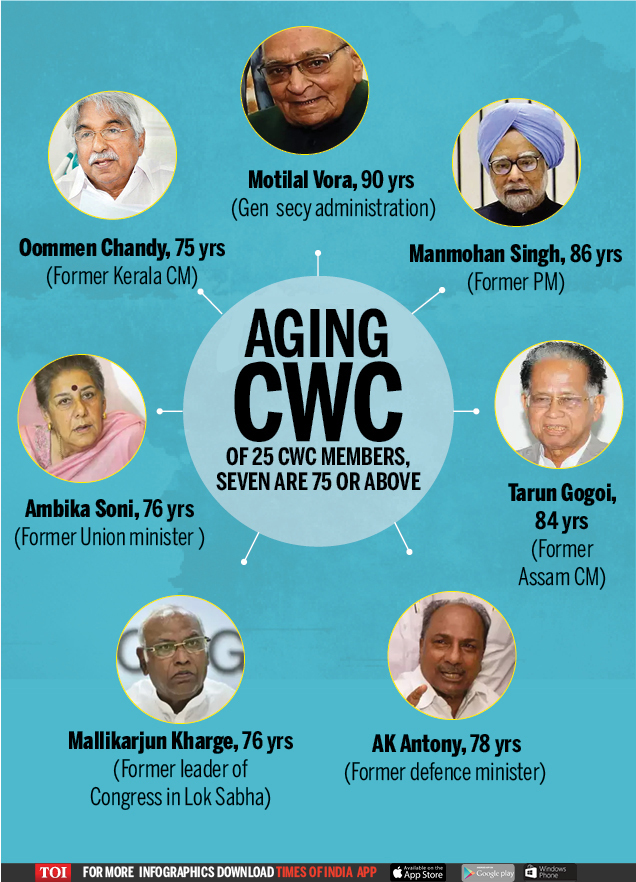
From: Kumar Shakti Shekhar, July 25, 2019: The Times of India
How Congress leadership fares vis-a-vis BJP in terms of age
NEW DELHI: The Congress party is in a state of disarray after the crushing defeat in the 2019 Lok Sabha elections. The chaos has worsened following resignation of Rahul Gandhi as Congress president. Dynasty leadership and dominance of the old guard differentiate it from the ruling BJP.
A major change in the BJP which was effected after Narendra Modi became the prime minister and Amit Shah took over as party president in 2014 was the age bar. In an unwritten or unspoken rule, the leaders who touched 75 years of age were not assigned any role in the government or the party. Some of the aged leaders who have been edged out from ministerial and party posts have been accommodated as governors or in the BJP’s Margdarshak Mandal.
To start with, instead of giving them any ministerial berths in the Modi government in 2014, BJP founding leaders LK Advani, 91, and Murli Manohar Joshi, 85, were made members of the Margdarshak Mandal. The two leaders were 86 and 80 in 2014.
Advani and Joshi had won the 2014 Lok Sabha elections from Gandhinagar and Kanpur respectively. Former prime minister Atal Bihari Vajpayee, who was 89 in 2014 and was not in good health, was also a member of this group till his death on August 16 last year.
Slowly and gradually, other leaders such as Najma Heptulla and Kalraj Mishra were dropped from the Modi cabinet in 2016 and 2017 respectively on attaining 75 years of age. While Heptulla was the minorities affairs minister, Mishra was the minister for micro, small and medium enterprises.
Heptulla, a Rajya Sabha member then, was made the Manipur governor while Mishra, a Lok Sabha MP from Deoria in Uttar Pradesh, was made the chairman of standing committee on defence and office of profit committee. On July 15, he was appointed as the Himachal Pradesh governor.
These leaders, such as LK Advani, Murli Manohar Joshi and Kalraj Mishra did not contest the 2019 Lok Sabha elections. They were replaced with younger candidates such as Amit Shah who contested from Advani’s Gandhinagar seat.
As matters stand now, there is not a single leader above the age of 75 in either Modi cabinet or in the BJP’s highest decision-making body - the Parliamentary Board.
BJP’s Parliamentary Board comprises nine members. There were 10 members till party general secretary (organisation) Ramlal, 66, was sent back to the party’s parent organisation R S S on July 13.
Of the remaining nine members in the Parliamentary Board, Amit Shah is 54, Narendra Modi 68, BJP’s working president JP Nadda 58, defence minister Rajnath Singh 68, former finance minister Arun Jaitley 66, former external affairs minister Sushma Swaraj 67, road transport and highways minister Nitin Gadkari 62, social justice minister Thawar Chand Gehlot 71, former Madhya Pradesh chief minister Shivraj Singh Chouhan 60.
While the Modi government and the BJP have become younger in 2019 as compared with pre-2014 period, the Congress is constantly aging with little infusion of young blood.
As against the usual 10 members in the BJP Parliamentary Board, the Congress’s highest decision-making body Congress Working Committee (CWC) consists of 25 members.
They are Rahul Gandhi (49), UPA chairperson Sonia Gandhi (72), former prime minister Manmohan Singh (86), party treasurer Ahmed Patel (69), former defence minister AK Antony (78), former Union minister Ambika Soni (76), leader of opposition in the Rajya Sabha Ghulam Nabi Azad (70), general secretary (administration) Motilal Vora (90), former MP Mallikarjun Kharge (76), general secretary (organisation) KC Venugopal (56), general secretary Avinash Pande (61), general secretary Dipak Babaria (68), deputy leader of opposition in the Rajya Sabha Anand Sharma (66), former Kerala chief minister Oommen Chandy (75), former Assam chief minister Tarun Gogoi (84), former Uttarakhand CM Harish Rawat (71), former Karnataka CM Siddaramaiah (70), former Union minister Kumari Selja (56), general secretary Mukul Wasnik (59), Rajasthan Congress vice-president Raghuveer Singh Meena (60), former Manipur deputy chief minister Gaikhangam (68), Chhattisgarh home minister Tamradhwaj Sahu (69), general secretary Priyanka Gandhi Vadra (47), general secretary Jyotiraditya Scindia (48) and former Goa chief minister Luizinho Falerio (67).
Of these 25 leaders, seven are 75 or above. This constitutes 28 per cent or more than one-fourth of the total number of CWC members. On the other hand, the BJP Parliamentary Board does not have a single leader who is 75.
The seven CWC leaders above 75 are Manmohan Singh, AK Antony, Ambika Soni, Motilal Vora, Mallikarjun Kharge, Oommen Chandy and Tarun Gogoi. These leaders would not have held any ministerial or party post had they been in the BJP.
While the oldest CWC member (Motilal Vora) is 90, the oldest BJP Parliamentary Board member (Thawar Chand Gehlot) is 71 - a gap of 19 years.
In the CWC, one member Motilal Vora is in his 90s and two members Manmohan Singh and Tarun Gogoi are in their 80s.
Further, only Thawar Chand Gehlot in BJP Parliamentary Board is in his 70s, while there are eight leaders - Sonia Gandhi, AK Antony, Ambika Soni, Ghulam Nabi Azad, Mallikarjun Kharge, Oommen Chandy, Harish Rawat and Siddaramaiah - in this age group.
While the average age of BJP Parliamentary Board is 63.7 years, that of CWC is higher at 67.6 years.
No wonder the CWC is perceived to be dominated by the old guard. After the Congress’s humiliating defeat in the recent Lok Sabha elections, the CWC meeting was held on May 25, two days after the results were announced. Rahul Gandhi announced resignation as Congress president in the meeting.
Rahul Gandhi reiterated his decision to quit in the Congress Parliamentary Party (CPP) meeting held on June 26 and he formally resigned on July 3.
The CWC has not met to decide Rahul Gandhi’s successor despite the lapse of two months after its first meeting, almost a month after the CPP meeting and 22 days after his formal announcement to resign.
However, there are three redeeming factors in the CWC. While the youngest member (Amit Shah) of BJP Parliamentary Board is 54, the youngest CWC member (Priyanka Gandhi Vadra) is 47.
Secondly, while there are three CWC members in their 40s (Rahul Gandhi, Priyanka Gandhi Vadra and Jyotiraditya Scindia) while there are none in the BJP.
Third and last, while three CWC members - KC Venugopal, Kumari Selja and Mukul Wasnik - are in their 50s, two BJP Parliamentary Board members (Amit Shah and JP Nadda) are in this age group.
As the CWC readies itself to choose a new party president, it remains to be seen whether it also copies the BJP and drops the members who have crossed 75 years of age.
‘Assembly’ elections (Legislative Assemblies of States)
Population and geography ruled by political parties, 1961-2021

The Times of India, Feb 2, 2017

The Times of India, Feb 2, 2017
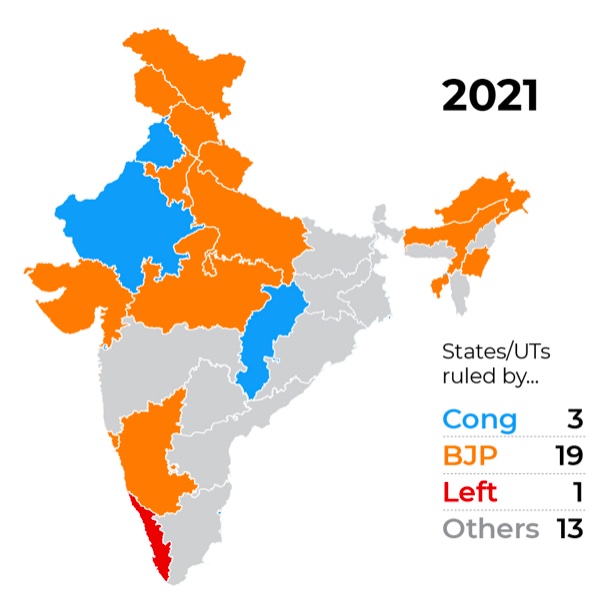
From: The Times of India
See graphics
Population ruled by political parties, 1961-2016
Geography ruled by political parties
States ruled by Congress, BJP, Left and others, 2021
1961: Blues on song
Indian National Congress ruled the vast majority of the country, with 95% of its population under chief ministers from the grand old party
1971: Emergency effect
Congress’s popular support began to wane in the mid-1970s. The Emergency declared by PM Indira Gandhi in 1975 ended with the Congress losing its grip on power at the Centre for the first time after the 1977 Lok Sabha elections
1981: Status quo
After a brief interlude, Congress was back and remained the party to beat in the dramatic decade that saw the birth of BJP at its beginning and ended with Mandal protests as the 90s took off
1991: Rise of the regional power
From having 80% of India’s population under its chief ministers, Congress was reduced to 26%. Meanwhile, regional parties went national and their rising appeal saw the population under their governments jump from 8% to 49% in a decade. BJP took two big states: Rajasthan and Madhya Pradesh.
2001: Lotus bloom
The count of states under BJP rule shot up from 4 to 11. Share of population in BJP-ruled states almost doubled, from 13% to 25%
2011: One-man show
The decade began with Congress in power in 18 states and UTs, but soon everything changed. Riding on Narendra Modi’s popularity, BJP notched landslide victories across North, East and West India
2021
States like Rajasthan and Chhattisgarh that had gone to BJP returned to the Congress camp and the party also joined the ruling alliance in Maharashtra. But all the North-Eastern states are now saffron. And with alliances, BJP rules in 24 out of 36 states/UTs, that is, two-thirds of the country.
Highest, lowest victory margins
1980-2017: in five states


2008, 2013
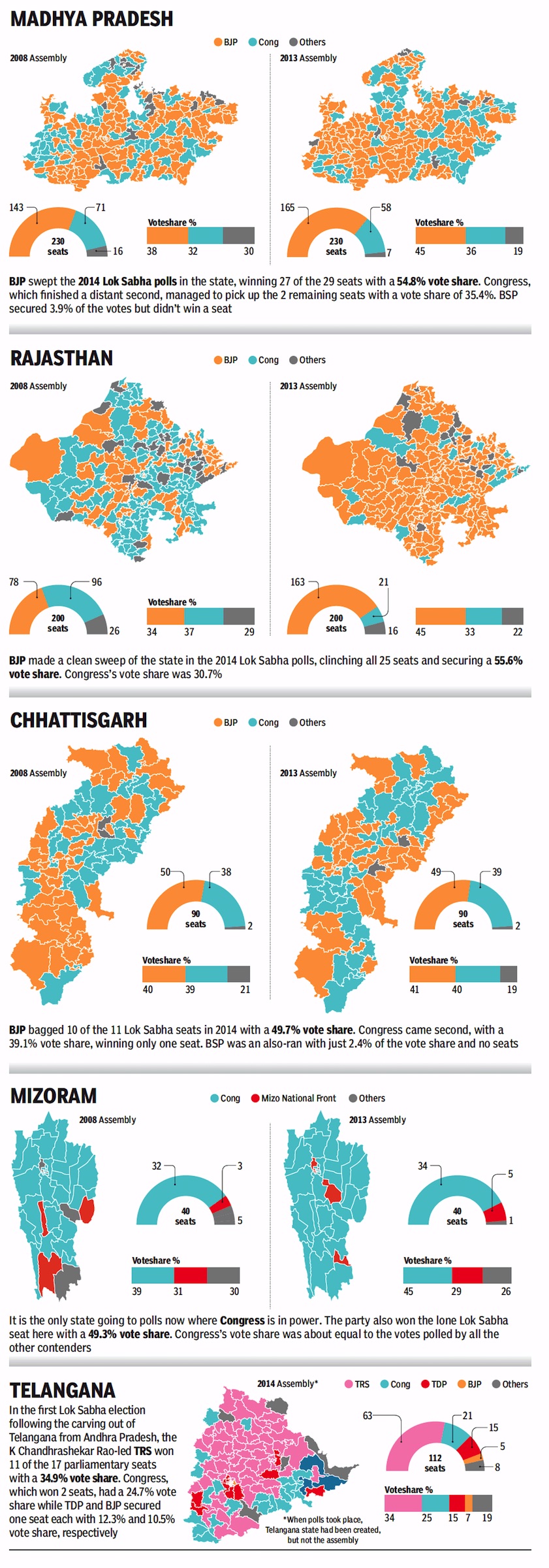
Chhattisgarh
Madhya Pradesh
Mizoram
Rajasthan, and
Telangana
From: October 7, 2018: The Times of India
See graphic:
2008, 2013: How the people voted in the legislative assembly elections in
Chhattisgarh
Madhya Pradesh
Mizoram
Rajasthan, and
Telangana
2011-2016: changing political landscape


See graphics:
The changing political landscape in Indian states, 2011-16
Assam, Kerala, Tamil Nadu and West Bengal: how the various political parties fared in reserved seats, in seats with a significant Muslim vote and in the tea plantations, in the 2011 and 2016 elections to the state legislative assemblies
2012-16: `Others' got more seats than BJP + Cong in 30 polls
The Times of India, May 21 2016
That BJP has gradually replaced Congress as the dominant party in Indian politics and that recent assembly polls have accelerated that trend is obvious, but the reality is that between them, the two national parties have won less than half the seats and votes polled in the latest assembly polls in 28 states (excluding Telangana, which was part of Andhra Pradesh when the last elections were held there) and two union territories, Delhi and Puducherry . In these 30 elections dating from 2012 and including the fi ve just concluded, a total of 4,117 seats were up for grabs.BJP has secured a decisive lead over Congress by winning 1,051 of them against the latter's 871. That makes a combi ned total of 1,922 seats. But all other parties put together have won 2,195 seats, or more than half the total. Seat tallies can be a mis leading indicator of po litical dominance. This is not only because a party can get a lot of votes but hardly any seats in the first past the post system, but also because an MLA in, say, Sikkim, represents a much smaller population than one in Uttar Pradesh but both count as one in the tally.
A better indicator, therefore, is how many votes each party has won. Here again, BJP's combined tally of 12.6 crore votes from the 30 polls beats the Congress' 11.8 crore, even if the gap seems crore, even if the gap seems much smaller than in the seats. Again, though, the rest with 33.5 crore votes comfortably beat the combined tally of the two big national parties. BJP and Congress put together have won 42% of the votes polled, 58% going to the rest.
Some of this 58% has, of course, gone to allies of BJP or Congress, like Shiv Sena or Akalis in the case of BJP, or DMK and RJD in the case of Congress. Nevertheless, these are not votes won by the two national parties on their own.
More importantly , the bulk of the 33.5 crore votes polled by the rest has gone to parties like Samajwadi Party, Bahujan Samaj Party, Trinamool Congress, Biju Janata Dal, All India Anna Dravida Munnetra Kazhagam (AIADMK) and the Left in Kerala or Tripura which are not aligned with either of the two national parties.
2012-17: State assembly elections


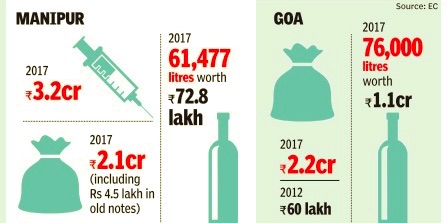
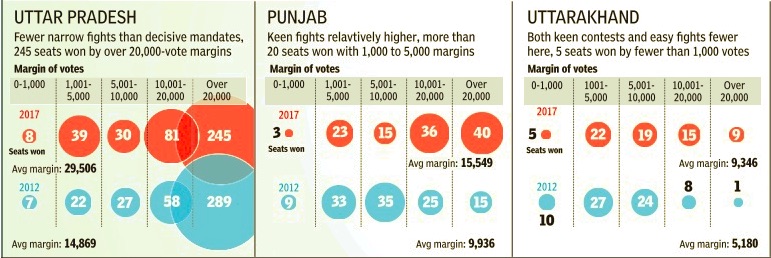

See graphics:
States ruled by the BJP and Congress, 2012-17
Seizures of money and liquor by the Election Commission in the run-up to the assembly elections of 2012 and 2017, UP, Punjab and Uttarakhand
Seizures of money and liquor by the Election Commission in the run-up to the assembly elections of 2012 and 2017, states, Manipur and Goa
Victory margins in the state assembly elections of 2017, Uttar Pradesh, Punjab and Uttarakhand
Victory margins in the state assembly elections of 2017, Goa and Manipur
The political map of India, 2012, 2017, 2018
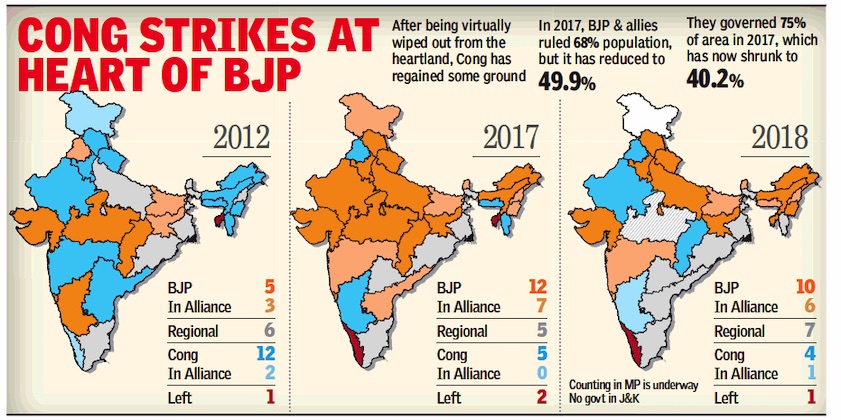
From: December 12, 2018: The Times of India
See graphic:
The standing of the BJP, Congress and other major parties in the Indian states in 2012, 2017 and 2018
2014- 2020
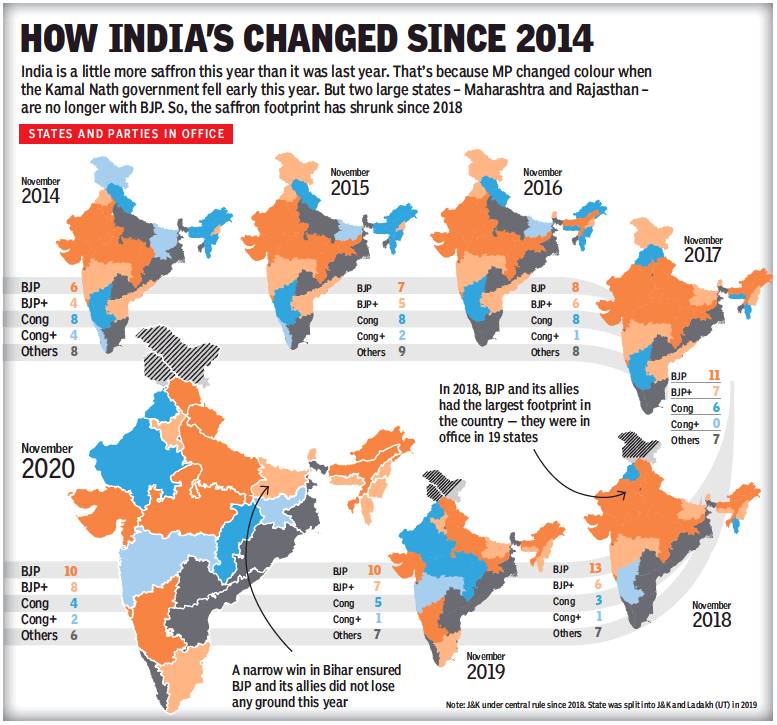
From: November 12, 2020: The Times of India
See graphic:
The standing of the BJP, Congress and other major parties in the Indian states, 2014- 2020
2014-19: BJP won most MLA seats, Cong not far behind

From: Mach 11, 2019: The Times of India
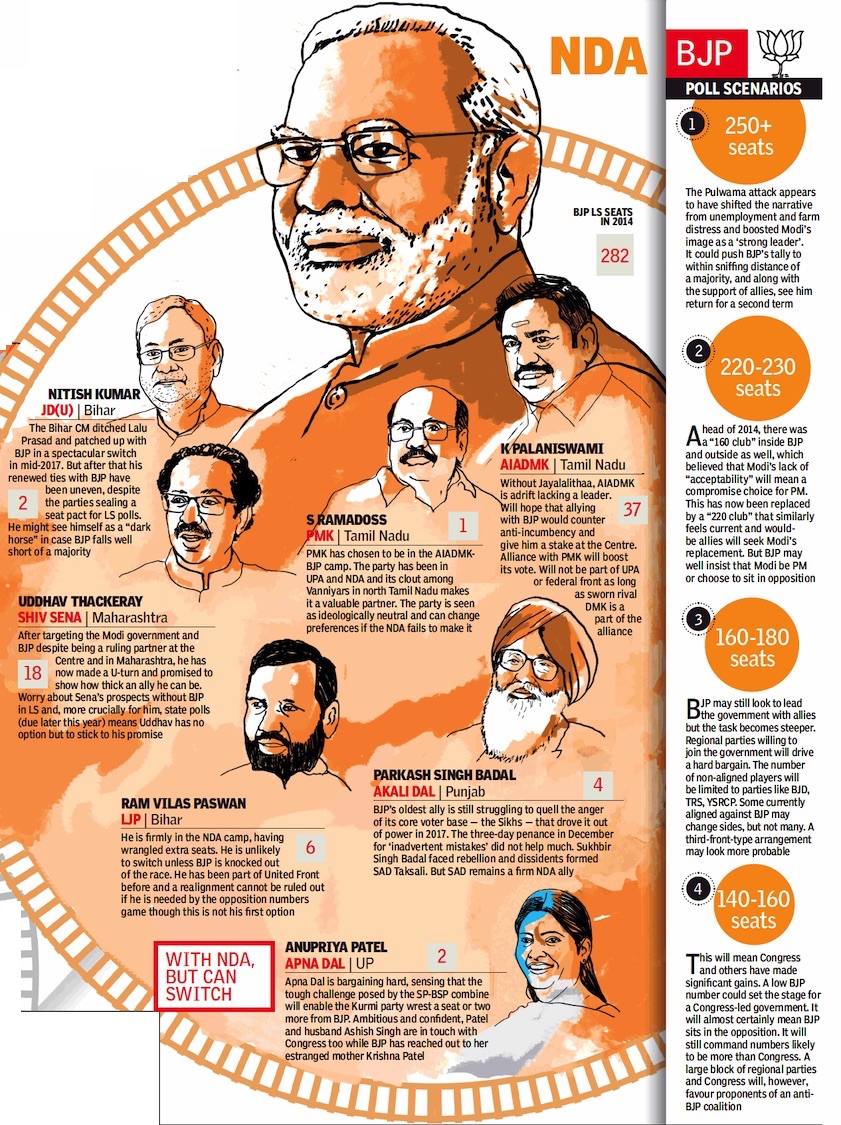
From: Mach 11, 2019: The Times of India

From: Mach 11, 2019: The Times of India
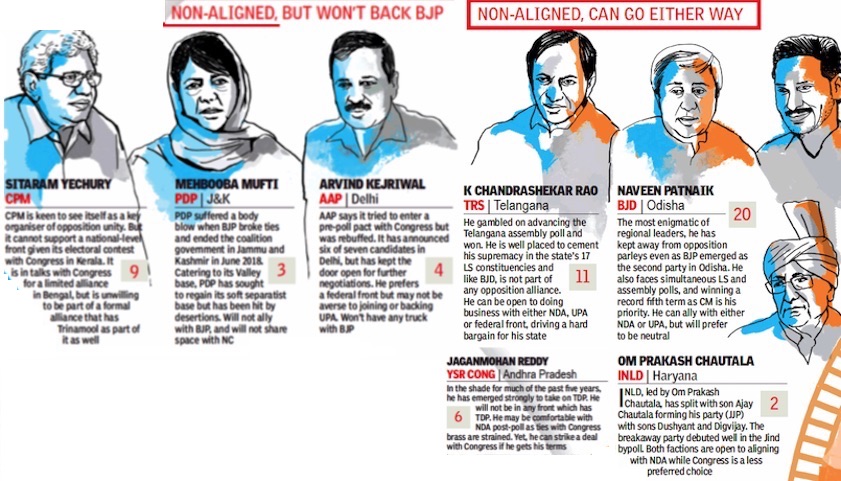
From: Mach 11, 2019: The Times of India
See graphics:
Seats won by Congress in 2014
Seats won by BJP in 2014
Seats won by Federal Front in 2014
Seats won by- Non aligned but won't back BJP; Non aligned and can go either way, in 2014
2018-19: Which party ruled how many states
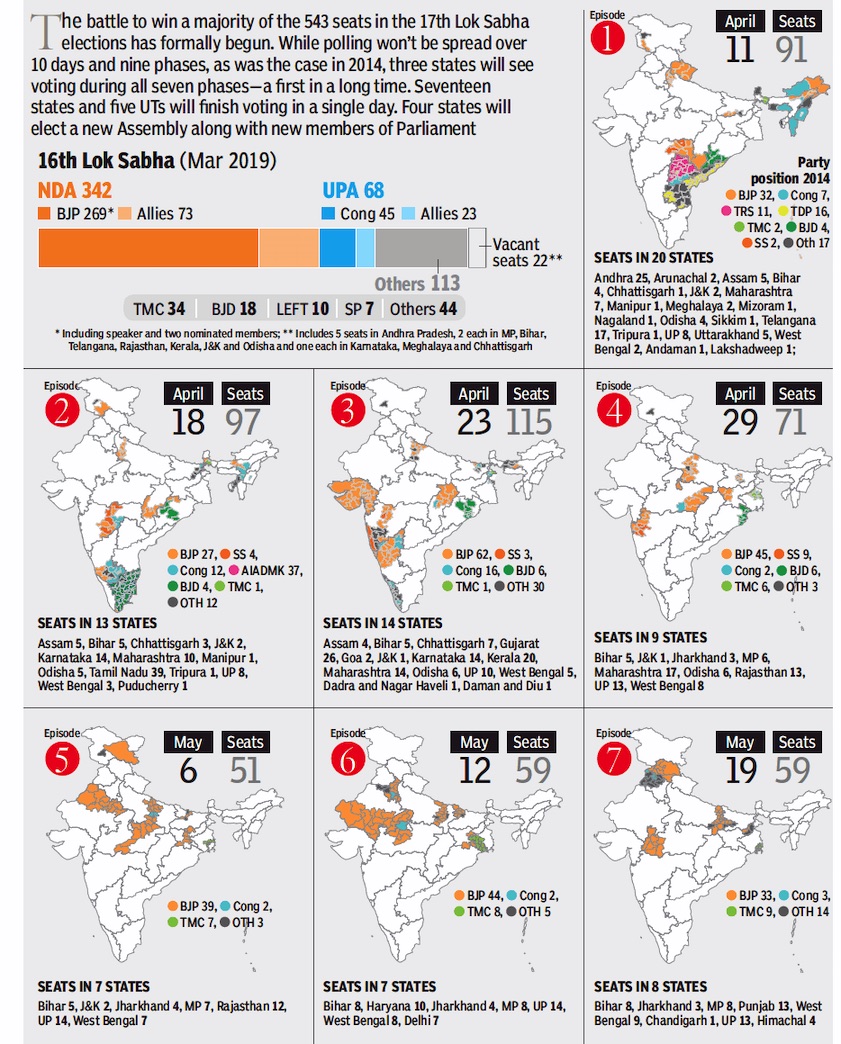
The timeline for voting for 17th Lok Sabha elections: April 11, 2019 till May 19, 2019.
From: March 11, 2019: The Times of India
See graphic:
Seats won by major political parties in 2014;
The timeline for voting for 17th Lok Sabha elections: April 11, 2019 till May 19, 2019.
2017
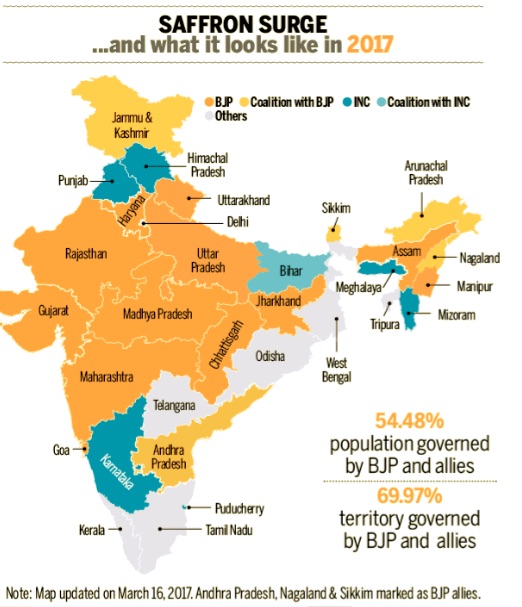
State assembly election results analysed
The Times of India, Mar 12 2017
BJP Vote Share In UP Rises 25% From '12, Cong's Down In 5 States
Impressive as the BJP's showing was in terms of seats in Uttar Pradesh, Uttarakhand and Manipur, a look at how vote shares have shifted compared to five years ago makes the performance even more creditable.
In UP, the party upped its share by a jaw-dropping 25 percentage points since 2012 almost equaling its 2014 share. Considering that was in a Lok Sabha poll in which national parties typically perform better than in state elections, it is quite an achievement to have nearly held on to what it got at the peak of the Modi wave.
In Uttarakhand, the party saw its share climb from 33% in 2012 to 46.5% this time. In a state that has always witnessed close contests in the assembly polls since its formation in 2001, this allowed the BJP to sweep the state with a 13 percentage point lead over the rival Congress.The BJP added to its share essentially by eating into the shares of all others.
In Manipur, the saffron party has become the single largest in terms of vote share with 36.3% helped in some measure by a sharp seven percentage point decline in the Congress' share. In comparison to these sharp climbs, the drop in vote share in Punjab and Goa looks trivial.
In contrast, the Congress lost vote share in every one of the five states, the sharpest falls coming in Manipur and Uttar Pradesh, though the latter was partly due to the party contesting much fewer seats.
Akali Dal was another big loser in vote share, shedding close to 10 percentage points compared to the 2012 elections. However, this was just a little lower than its 2014 vote share which suggests that expectations of a complete meltdown of its base were grossly exaggerated. For AAP, a 23.7% vote share in its first foray in assembly polls in Punjab may seem like a promising beginning, but the party would be disappointed that it couldn't better its 2014 performance, when it won 24.4%. With the same share spread thinner this time, it could win just 20 seats while it had led in 33 in the Lok Sabha polls.
Perceived behaviour of castes, communities
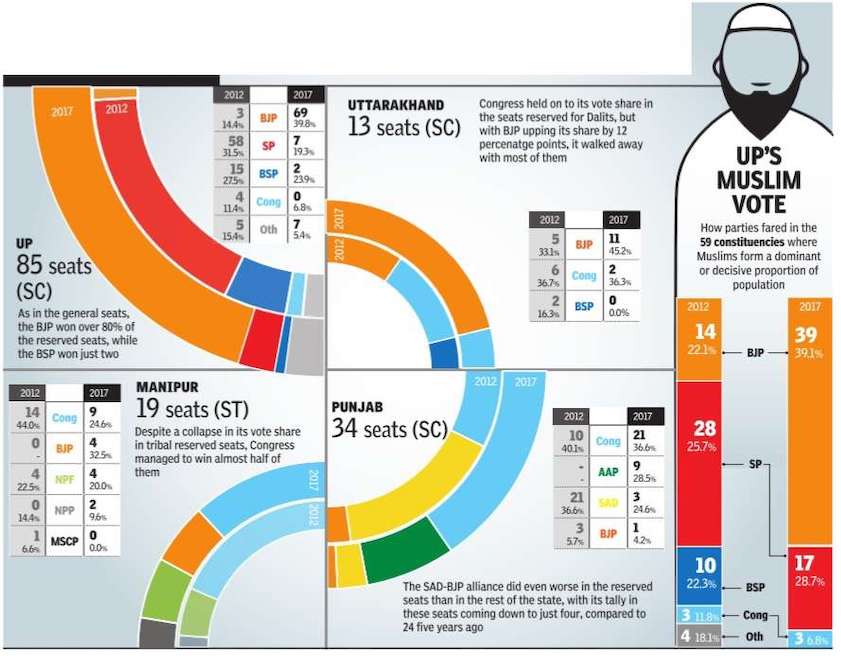
See graphic:
Voting behaviour, community and caste-wise, 2017
2018
Assembly elections in 5 states: BJP loses
State-wise results

From: December 12, 2018: The Times of India

From: December 12, 2018: The Times of India
See graphics:
The results of the state assembly elections of Dec. 2018- Seats won by the major parties in Madhya Pradesh, Rajasthan, Chhattisgarh
The results of the state assembly elections of Dec. 2018- Mizoram, Telangana
Aam Aadmi Party’s performance
Alok K N Mishra, ...But losses in 4 states a dampener, December 12, 2018: The Times of India
The results of assembly elections were a dampener for AAP, which had put its political aspirations to test in Rajasthan, Madhya Pradesh, Telangana and Chattisgarh. It contested on 482 seats across the four states and lost all of them.
While the party has no base in these states, it maintained that it has only gained strength by contesting there, regardless of the result. The decision to contest, apparently, came after volunteers from these states urged the party to contest there to keep the volunteers motivated.
AAP contested 208 of 230 seats in MP. It announced a CM candidate and also released a manifesto, promising Delhi-like health and education services. AAP leaders extensively campaigned in the state, including the party’s MP in-charge Gopal Rai and Rajya Sabha MP Sanjay Singh. Majority of the candidates lost their deposits while the CM candidate, Alok Agrawal, who also heads the MP unit of AAP, finished fourth on the Bhopal South West seat.
The party had big hopes in Rajasthan where its state unit switched to poll mode months before elections were announced. In April, senior leader Deepak Bajpai was appointed the incharge for Rajasthan. Bajpai replaced disgruntled AAP leader Kumar Vishwas who, AAP had said, was unable to devote time for the state.
Bajpai camped in the state to pick candidates and claimed that the party was certain of making a huge debut this time. AAP hardsold its Delhi model of governance through its manifesto and deployed a battery of leaders from Delhi to campaign in the state. Arvind Kejriwal also held one election rally in Jaipur.
AAP originally planned to contest all 200 states in Rajasthan, but eventually contested on 147 and lost on all.
The Chattisgarh results were also disappointing for the party as none of the 85 candidates could win. AAP’ chief ministerial candidate for Chhattisgarh, Komal Hupendi, remained at the third position while many of the party candidates lost their deposits. An almost similar situation was witnessed in Telangana too where the party fielded 41 candidates.
AAP’s Telangana incharge Somnath Bharti blamed the poor performance on the alleged deletion of 22 lakh voters. He also said the purpose was to defeat BJP but AAP found it difficult to beat the money and muscle power it faced.
Assets, age, gender

From: December 12, 2018: The Times of India
See graphic:
The MLAs elected in December 2018- average assets, average age and gender
BSP’s performance
Hindi belt gifts Mayawati a mixed bag, December 12, 2018: The Times of India
So it turns out that it was not Congress that got bruised by the Mayawati/Jogi alliance in Chhattisgarh. BSP vote share in fact dropped from 4.45% in 2013 to 3.9% even as, without it, Congress romped to a thumping victory.
But had Congress and BSP contested together in Rajasthan and Madhya Pradesh, they would have crossed the finishing line easily – instead of GOP being halted teasingly short of the majority mark on counting day.
BSP attracted 5% vote share in MP and 4% in Rajasthan, compared to Congress’s 40.9% and 39.3%. This should shape alliance talks for the next Lok Sabha elections. Mayawati must accept realistic seat share arrangements, now that Congress has established how strongly it can bat by itself in Chhattisgarh, Rajasthan and MP.
The lesson for that mahagathbandhan, especially in light of how mahakutami crashed and burnt in Telangana, is that pie-in-the-sky seat sharing where junior allies gobble much more than is healthy, ends in regrets not celebrations. In Uttar Pradesh, in exchange, Mayawati should be able to call the shots rather than Congress.
In other news relevant for mahagathbandhan talks in the Hindi belt, across MP, Rajasthan and Chhattisgarh, SP was beaten convincingly by NOTA.
Cong neutralised vote katuwas/ spoilers
In both Madhya Pradesh and Rajasthan, Congress’s victory margins were slim, but it was not counting on its luck alone. Here was a party showing a lot of pluck as well.
After a string of defeats since 2014, Congress also appears to have found ways to counter BJP’s strategy of saddling it with ‘vote katuwas’ or ‘spoilers’.
In Madhya Pradesh, the party actually finished with a vote share that was 0.1 percentage points less than that of BJP. Yet, it won 114 seats — just two short of majority — while BJP ended at 109. Congress managed to convert votes into seats more effectively than BJP.
In Rajasthan, Congress’ vote share was just 0.5 percentage points more than BJP. But this made a huge difference in the seat tally.
Congress argues the anti-BJP sentiment was so strong that multiple poles like Bharatiya Tribal Party, 11 of 13 independents with Congress roots, BSP and CPM got some anti-BJP votes as well. Non-Congress, non-BJP votes totalled 21.9%, with 9.5% going to independents.
Luck may or may not have played a part in helping Congress in the first-past-the-post system, but the party did show some nimble-footedness unlike in the past.
As the counting in MP turned into a protracted exercise and the clash turned into a cliff-hanger, Congress stitched up the loose ends, spending the entire day contacting likely winners in BSP, SP and independents. Sources said Congress started to win over the ‘others’ winning MLAs so early it could have formed the government even if it had won fewer seats.
State chief Kamal Nath sought the governor’s appointment on Tuesday while counting was still on, claiming Congress would emerge as the single-largest party and could form the government with others’ support.
It was a marked change from Goa and Manipur where Congress emerged the single-largest party ahead of BJP and barely short of majority, but found that BJP had already bagged the ‘others’.
A noticeable change was Congress’ ability to overcome “spoilers” who threatened to turn a direct face-off with BJP into a triangular contest.
NOTA (none of the above) reflects the public mood
MP: Nota votes dislodge 4 BJP ministers
Angry Nota votes knock out 4 BJP ministers in MP, December 13, 2018: The Times of India
The roller-coaster ride on counting day and the heart-stopping scoreline had a common factor — tens of thousands of confused and disgruntled voters. In an election supposedly fought on pro- and anti-incumbency, Nota surprisingly had fifth largest tally of votes in Madhya Pradesh.
The number of no-choice votes crossed victory margins in a whopping 22 constituencies, felling four powerful BJP ministers. While the gap between BJP and Congress vote share was only 0.1% (BJP being in the lead), Nota bagged 1.4% of votes polled — over 5.4 lakh.
BJP (41%) and Congress (40.9%) were followed by BSP with 5% vote share and Gondvana Gantantra Party (GGP) at 1.8 %. Nota, at fifth place, polled more votes than SP (1.3%) and AAP (0.7%).
Of the 22 seats, where Nota topped victory margins, there were four constituencies where ministers lost by a whisker. The lowest victory margin was 121 votes in Gwalior South, where Nota got 1,550 votes, leaving MoShome Narayan Singh Kushwaha wringing his hands in despair.
In Damoh, finance minister Jayant Malaiya lost by only 799 votes, while Nota polled 1,299 votes. In Jabalpur North, MoS, health, Sharad Jain lost by just 578 votes while Nota bagged 1,209 votes. In Burhanpur constituency, minister for women and child development, Archana Chitnis, lost by 5,120 votes and Nota’s score was around 5,700 votes.
While BJP bled more due to Nota — ending up on the losing side in 12 of these 22 seats — Congress received some battering as well. In Timarni seat, Abhijeet Shah of Congress lost to Sanjay Shah of BJP by a margin of 2,213 votes while Nota got 4,084 votes. In Nagod constituency, Congress heavyweight Yadvendra Singh lost by a thin margin of 1,234 votes, while 2,301 votes went to Nota.
Bundelkhand and Malwa drew the highest number of Nota votes that triggered upsets. Of the 22 seats where Nota trumped victory margins, nine are in Bundelkhand and eight in Malwa. In Bundelkhand, it is believed that the campaign by some upper caste organisations to vote for Nota, rather than BJP or Congress, may have been a factor. They were upset with both major parties for the SC/ST Act ordinance that bypassed Supreme Court’s directive for investigation before arrest in cases filed under the Act. In Malwa, tribal regions saw most Nota votes, apparently due to lack of awareness. It’s a common feature in tribal areas, but in such a close election, it turned out to be a tipping factor.
Nota costs BJP dearly in Rajasthan
December 13, 2018: The Times of India
It was a marginal difference in voteshares of the Congress and BJP that sealed the fate of outgoing CM Vasundhara Raje in Rajasthan.
BJP secured a voteshare of 38.8% while Congress, which with 99 seats emerged the single-largest party, took 39.3% of votes polled — a difference of a mere 0.5%. A total of 1.39 crore votes went to Congress while BJP bagged 1.37 crore votes. That works out to a difference of about 1.70 lakh votes.
Interestingly, the none-ofthe-above or Nota option accounted for 1.3% of the votes. These figures all go to show how much of a close fight it was between the two major parties in the state.
BJP, which swept the 2013 assembly polls with a voteshare of 46.05% and 163 of the 200 seats, saw a 7.25% dip in voteshare this time. Its tally in 2018 was down to 73. Congress, in 2013, secured a 33.71% voteshare and had 21 seats to show for it.
Even if it were to be believed that BJP lost 5.6% of its voteshare to Congress, the remaining 1.65% may be put down to Nota — which is conventionally seen as a vote
against the ruling party -- the more than 15 rebels who contested as Independents and smaller parties.
Coming to terms with the near miss, state BJP leaders are now claiming a moral victory for the party. “Congress has performed only slightly better than BJP. There was no Congress wave. Even the victory margins for several Congress MLAs have been quite low,” said state BJP leader Jyoti Kiran.
Rural and tribal areas; parliament and assembly seats
Why heartland could turn out to be hurtland for BJP, December 12, 2018: The Times of India
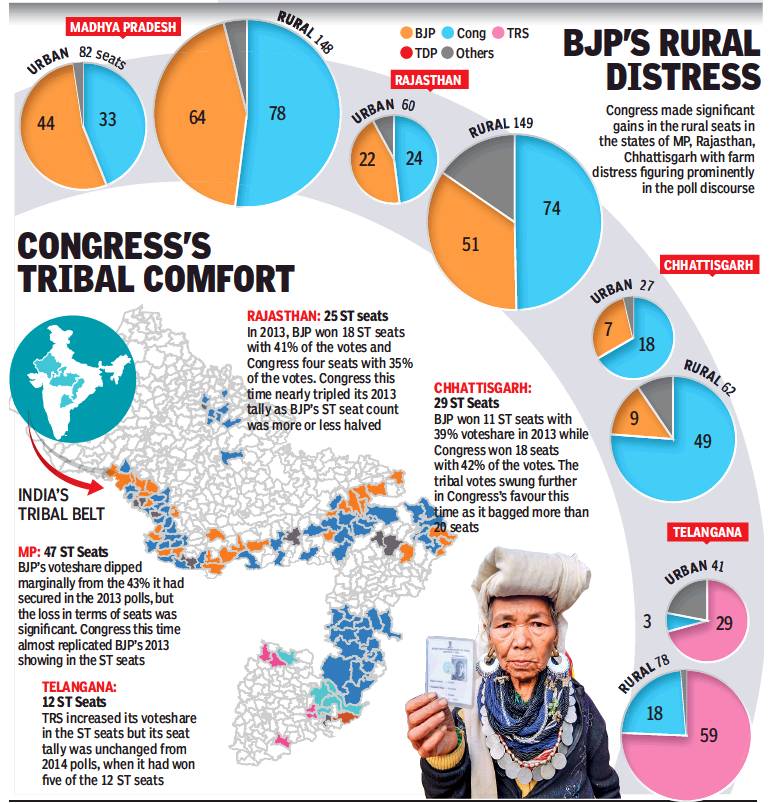
From: Why heartland could turn out to be hurtland for BJP, December 12, 2018: The Times of India
What would happen in Madhya Pradesh, Rajasthan and Chhattisgarh in the 2019 Lok Sabha polls if voters stuck to their party preferences? A mapping of the assembly segments onto the relevant parliamentary seats suggests that the BJP would still win 17 out of 29 in MP and 13 out of 25 in Rajasthan, but get almost wiped out in Chhattisgarh winning just one of the state’s 11 seats.
But does such a mapping make sense? Past experience suggests it is not a bad rough guide. These states have held assembly polls barely six months or less ahead of the Lok Sabha polls of 2004, 2009 and 2014. In each case, their verdict in the parliamentary seats has more or less mirrored the assembly outcome. The sole exception is Rajasthan in 2004, when it gave the BJP 20 of 25 Lok Sabha seats despite having defeated the party in the December 2003 assembly polls.
If the pattern holds, that could be really bad news for the BJP since it had won all 25 seats in Rajasthan, 27 of 29 seats in MP and 10 of 11 seats in Chhattisgarh in 2014. That’s a total of 62 out of 65 Lok Sabha seats. The current mapping suggests that number could come down to 31, half of the 2014 tally. Of course, the Congress tally would rise correspondingly. Given that the 2014 performance would be hard to repeat in Uttar Pradesh anyway, this is a loss the BJP can ill afford.
December 11, 2018: The Times of India
With the BJP suffering losses in three key states, its vote share has taken a sharp dip in Chattisgarh, Rajasthan and Madhya Pradesh since the last assembly elections in 2013, but all these votes do not seem to have gone to the Congress alone as other players have also reaped the gains.
The vote share loss is even bigger for the saffron party since the 2014 Lok Sabha elections, in which it had virtually swept all the three states by winning 62 out of 65 seats, as per the Election Commission data.
In Telanagana and Mizoram, it is the regional parties who have come out with flying colours, a post-2014 trend clearly visible in many states with sizeable presence of non-BJP and non-Congress parties.
Political pundits said this trend indicates that the regional satraps might play key roles in 2019 general elections for which attempts are already underway by non-BJP parties to put a united front against Prime Minister Narendra Modi's bid for a second term.
For Chattisgarh, the latest data showed the Congress getting 43.2% votes in this elections, up from 40.3% in the 2013 state polls and 38.37% in the 2014 general elections, where the party won only one out of 11 Lok Sabha seats in the state.
In comparison, the BJP's loss has been wider with its vote share dipping from 41% in 2013 to 32.9% now. In 2014 general elections, the party had got nearly 49% vote and 10 out of the 11 Lok Sabha seats.
The voting share analysis shows that some smaller parties and independents have managed to get more votes. While BSP had got 4.3% in 2013, its alliance with former chief minister Ajit Jogi's party has now got about 10.7% votes.
Independents have also improved their performance from 5.3% to 6.3%.
Similar trend was visible in Rajasthan where BJP's votes have fallen from 45.2% in 2013 to 38.8% now. It was much higher at nearly 55% in 2014, when the party won all 25 Lok Sabha seats from the state.
On the other hand, the Congress has improved its vote share from 33.1% in 2013 to 39.2% in 2018. It had managed to get nearly 30% votes despite losing on all seats in last parliamentary elections.
Independents have improved their assembly tally from 8.2% to 9.5%, while bagging larger number of seats.
The vote share situation is the most interesting in Madhya Pradesh, which saw the closest fight between the Congress and the BJP. The Congress' share has improved from 36.4% in 2013 to 41.4% in 2018 assembly polls, while that of the BJP has come down from 44.9% to 41.3%, as per the latest update.
The BSP's share here has actually fallen to 4.6%, while that of the independents has remained nearly same at over 5%. However, some other smaller parties have made gains.
In Telangana, the TRS is returning to power with a bigger mandate and a rise in its vote share from nearly 34% last time to about 47%. The Congress has also improved from 25.2% to 28.7%, though its newly-found ally TDP, which was earlier with BJP, has taken a beating.
BJP's vote share has remained almost static at about 7% since last assembly elections in 2014. However, its vote share has come down from 10.4% in 2014 Lok Sabha polls.
Mizoram is the only state where the Congress has lost its vote share and the BJP has gained. However, the winner there is a third player, the Mizo National Front, which has returned to power with a clear majority by ousting the only Congress government left in the North-East.
The Congress vote share has come down from nearly 45% in 2013 to just about 30%, while that of BJP has risen five-fold from 0.4% to 8%.
The MNF has improved from 28.8% to 37.6%, while its seat tally has risen from five to 26. The Congress seats have come down from 34 to five, while the BJP has won its maiden assembly seat in the state.
While the vote share data for 2018 polls was still being updated by the poll panel, the final figures are expected to remain around these levels.
Winners and losers
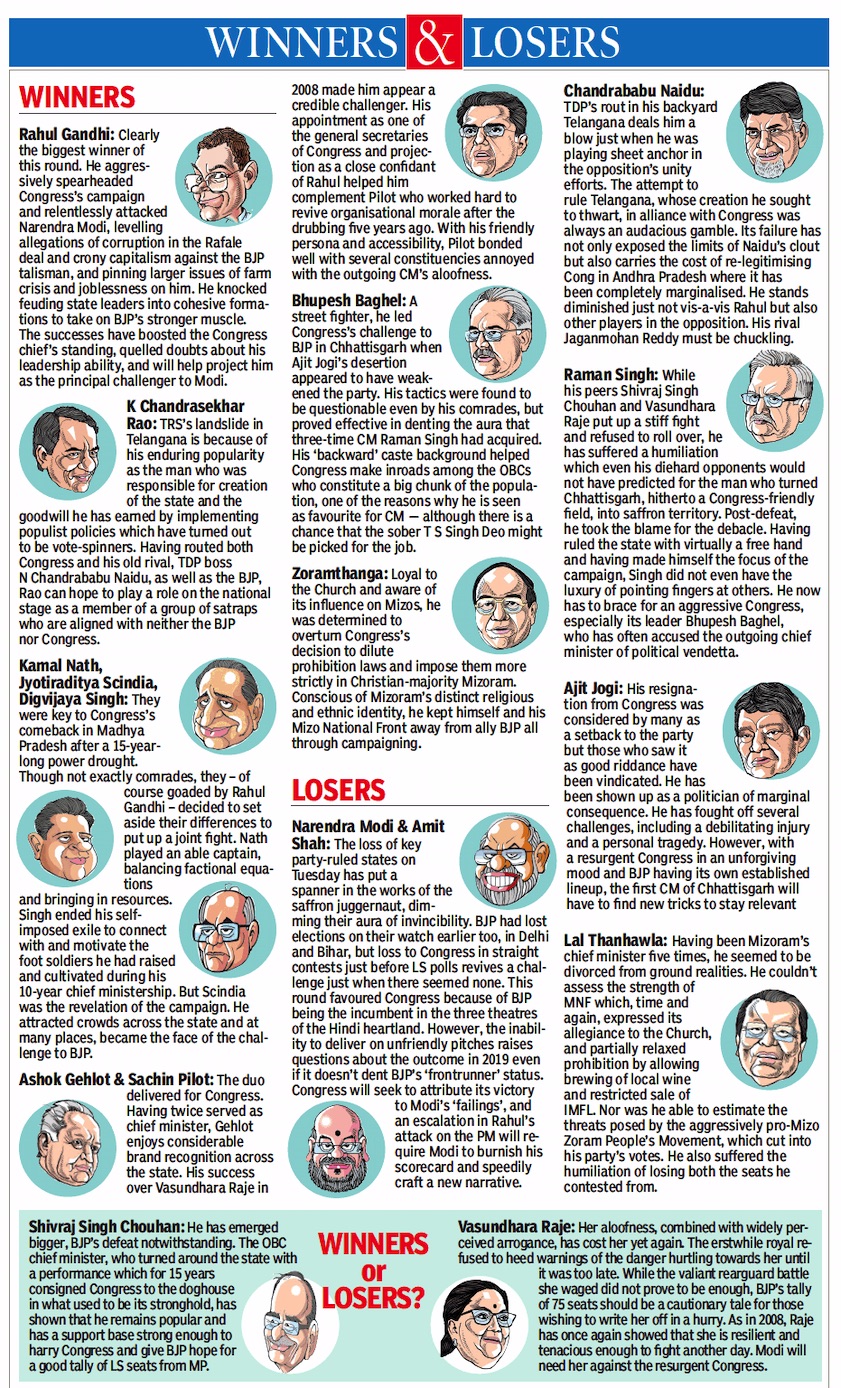
From: December 12, 2018: The Times of India
See graphic:
The winners and losers of the Assembly elections in 5 states held in December 2018
The meaning of the results
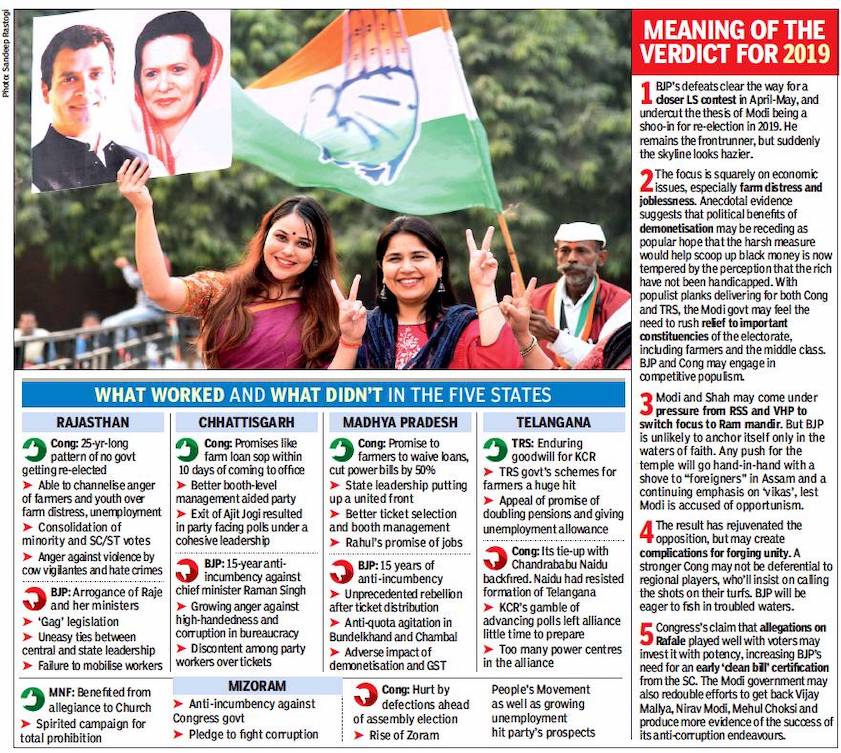
From: December 12, 2018: The Times of India
See graphic:
The meaning of the results of the state assembly elections of December 2018
2019
Haryana, Maharashtra assembly elections; by elections
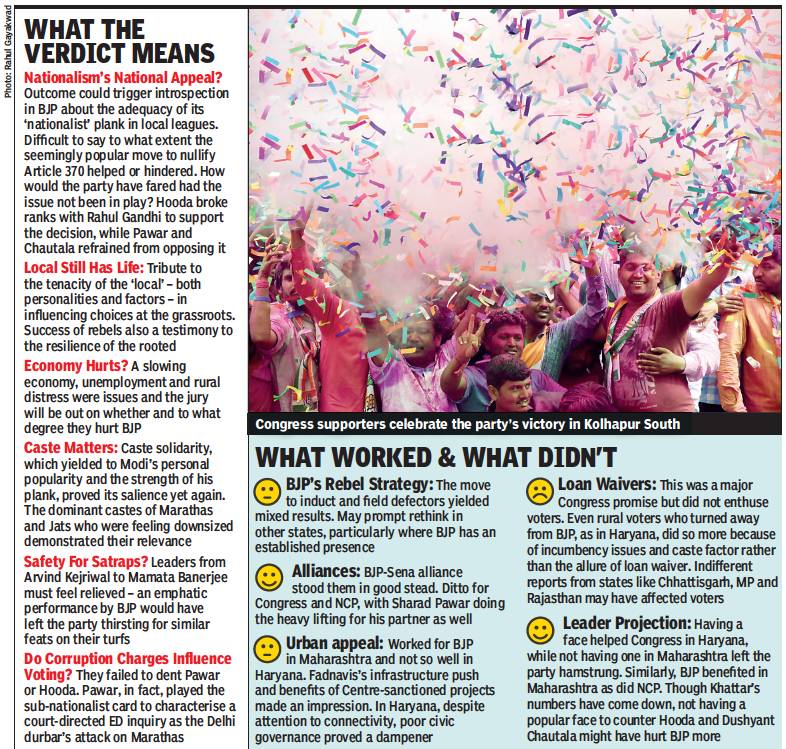
From: Ajay Sura & Manvir Saini, Oct 25, 2019: The Times of India
See graphic:
Oct 2019: The results of the Haryana and Maharashtra assembly elections
What the verdict means
Oct 25, 2019: The Times of India
This was not supposed to be a competitive round. After the big BJP wins in Maharashtra and Haryana in the Lok Sabha elections only 5 months ago and the widely perceived support for decisions on J&K, the party’s win was a given. However, voters sprang a surprise by denying BJP a majority in Haryana and restricting its mandate in Maharashtra. The outcome will disappoint BJP and could trigger introspection about the adequacy of its “nationalist” plank in local leagues, especially amid an economic slowdown. It does not undercut its political pre-eminence but sharply underscores the challenges to its bid for countrywide dominance that Congress once enjoyed.
The less-than-impressive saffron show just when it had seemed “unreachable” by a big distance is a tribute to the tenacity of the “local” — short-hand for personalities and factors that influence choices at the grassroots. They may be pushed to the background in an LS poll, yielding an overarching theme or a popular national leader like Narendra Modi, but return with vengeance in state elections. Results of by-elections and, in many cases, success of rebels are also a testimony to the resilience of the rooted. The Indian experience provides validation for former US Speaker Tip O’ Neill, who famously said all politics is local.
ECONOMIC SLOWDOWN:
A slowing economy, unemployment and rural distress were issues and the jury is out on whether and to what degree they hurt BJP. Opposition parties predictably brought them up and pointed to a sullen mood. But to what ‘extent’ remains unresolved, considering that BJP picked up over 300 seats in the LS election against what some considered a very adverse setting. Also, BJP faced incumbency in both Haryana and Maharashtra and couldn’t have returned the numbers they did if they had faced large-scale resentment. Possibly, the discontent over kitchen table themes kept BJP from fully leveraging its assets CASTE MATTERS: Caste solidarity which yielded to Modi’s personal popularity and the strength of his plank, proved its salience yet again.
The dominant castes of Marathas and Jats, who were feeling downsized, demonstrated their relevance.
The performance of Pawar and Hooda owe a lot to caste support which also boosted new regional satrap Dushyant Chautala. The staunch support from their kin allowed their leaders to forge formidable social constituencies at the local level
ARTICLE 370: Difficult to say to what extent the seemingly popular move to do away with the special status for J&K helped or hindered BJP. For, finding a reliable answer would require complete clarity on how the party would have performed if the ‘nationalist’ issue had not been in play. Also, Congress leader Bhupinder Singh Hooda broke ranks with Rahul Gandhi to back the decision, while NCP’s Sharad Pawar and JJP’s Dushyant Chautala refrained from opposing it. But the slim win in Maharashtra and failure to score an outright win in Haryana will reinforce the view that local can trump national in regional arenas. Opposition parties may feel encouraged to resist BJP’s aggressive posture on the matter
REGIONAL PLAYERS: From Arvind Kejriwal to Mamata Banerjee, regional satraps must be relieved. For, an emphatic performance by BJP would have left it thirsting for similar feats on their turfs. It could also have lent impetus to JD(U) chief Nitish Kumar’s scarcely concealed plan to keep BJP as his junior partner in Bihar for the coming state elections had he not fared so poorly in the by-polls GRAFT CASES: Whether allegations of corruption influence polls has been debated endlessly with people voting out the allegedly corrupt only to bring them back the next time. This time too, graft charges failed to dent Pawar or Hooda. Pawar, in fact, shrewdly turned a courtdirected ED inquiry to fend off BJP’s aggressive designs
Details
Oct 25, 2019: The Times of India

From: Oct 25, 2019: The Times of India
After the sweep comes the stumble. Just months after having decisively won the Lok Sabha elections with a decisive mandate, BJP turned in a notso-impressive performance.
It scored a less-than-emphatic victory in Maharashtra and fell short of the majority mark in Haryana, in an outcome that will reignite the debate over the effectiveness of its “nationalist” plank in state polls, enthuse opponents and can trigger an introspection on how to address issues arising from slowdown.
The party did not lose. In Maharashtra, where it had played second fiddle to Shiv Sena for decades, it defied incumbency to retain the CM post and its status as the number one player. In Haryana, a virgin territory until 2014, the party finished on top and can form government with the support of Independents. But the tallies fell short of the expectations aroused by its LS poll victory.
The vociferous insertion of national issues made the Maharashtra and Haryana polls more of a verdict on decisions of the Modi government than might have been the case despite the clear prominence of local and regional factors and caste equations associated with state contests.
By elections: NDA wons 26 out of 51, Cong 12
Oct 25, 2019: The Times of India
BJP and its allies won 26 of the 51 assembly byelections in 18 states for which results were announced on Thursday, winning eight of the 11 contests in Uttar Pradesh but suffering setbacks in Gujarat and Bihar. Congress bagged 12 seats.
In the two Lok Sabha bypolls, NCP’s Shriniwas Dadasaheb Patil scored an upset win over BJP’s Udayanraje Pratapsinghmaharaj Bhonsle in Satara, Maharashtra, while Prince Raj of LJP, a nephew of Ram Vilas Paswan, defeated Congress’ Ashok Kumar in Samastipur (SC), Bihar.
The byelections marked the entry of BJP in the Sikkim assembly — where it won two of the three seats on offer — and that of AIMIM, led by Asaduddin Owaisi, in Bihar.
In UP, NDA retained eight of the nine seats it held but SP was a major gainer, wresting a seat each from BJP and BSP, while retaining Rampur. In Gujarat, BJP conceded three of six seats to Congress. BJP’s Alpesh Thakor, who had defected from Congress, lost.
8 ministers defeated in Maha, 7 in Haryana; turncoats lose
Oct 25, 2019: The Times of India
Ministers and turncoats pulled NDA down in the battle to retain Maharashtra and Haryana.
Eight ministers of the Devendra Fadnavis government lost at the hustings, an embarrassment almost matched by the M L Khattar cabinet in Haryana that saw seven out of its nine BJP members biting the dust. Dimming the glow of returning to power in Maharashtra further was the electorate’s rejection of 11 prominent faces from the opposition camp that had crossed over to the BJP-Shiv Sena side just before the polls.
While it was expected that some of Fadnavis’s ministers would lose, the defeat of agriculture minister Anil Bonde was a big surprise, as was that of high-profile rural development minister Pankaja Munde, who lost to her cousin Dhananjay Munde by 31,000 votes.
The others included junior forest minister Parinay Fuke, employment guarantee minister Jaydutta Kshirsagar, who joined the Shiv Sena on the eve of the assembly elections, senior Sena leader and minister of state for textiles Arjun Khotkar, minister for marketing Ram Shinde, junior labour minister Bala Bhegde and MoS for water resources Vijay Shivtare.
Eleven of the 19 prominent turncoats who had switched allegiance to BJP were defeated, too. The list includes Udayanraje Bhosale from Satara, former minister Harshavardhan Patil, Vaibhav Pichad and Dilip Sopal.
In Haryana, the capitulation of ministers wasn’t the only setback to BJP. State party chief Subhash Barala suffered defeat at the hands of JJP’s Devender Babli by a margin of 52,302 votes, leaving him so disappointed that he left the counting hall midway and soon announced his resignation.
Only 2 netas in Khattar cabinet manage to clear the mark
Ministers Anil Vij from Ambala Cantonment and Banwari Lal from Bawal constituency were the only victorious ones for BJP. Khattar had 11 ministers in his cabinet, two of whom — Vipul Goel and Rao Narbir — were denied tickets.
The senior-most minister, Ram Bilas Sharma, who was in charge of education and tourism, lost to Rao Dan Singh, a loyalist of former Congress chief minister Bhupinder Hooda, by a margin of 9,240 votes.
The one outcome that dealt the biggest shock was the defeat of finance minister Capt Abhimanyu, seen by many as the most powerful in Khattar’s cabinet. Capt Abhimanyu lost to ex-BJP stalwart Ram Kumar Gautam of JJP by a margin of 12,029 votes.
BJP’s “farmer face”, agriculture minister Om Parkash Dhankar, lost to Kuldeep Vats in Badli by 11,245 votes. Manish Grover, a junior minister, was defeated by Hooda loyalist Bharat Bhushan Batra in Rohtak city. Three-time MLA and women and child development minister Kavita Jain, whose husband was media adviser to Khattar, couldn’t retain her seat either. Neither could three-time MLA and speaker Krishan Lal Panwar in Israna. Krishan Kumar Bedi, the minister from Shahbad, also lost, as did Karan Dev Kamboj by a small margin of 560 votes.
Art 370 as a poll issue
Akhilesh Singh, Oct 25, 2019: The Times of India
BJP’s failure to retain the numbers it had won in Maharashtra and Haryana in 2014 has raised the question whether it became excessively dependent on the popularity of its Article 370 decision, reports Akhilesh Singh. In Haryana, seven ministers, the speaker and state party chief lost. In Maharashtra, BJP suffered an unexpected setback in Vidarbha, home base of Fadnavis and Gadkari. Young leader Pankaja Munde also lost, leading many in the party to question the effectiveness of “nationalist” themes in state contests.
BJP scores betters in NCR
Oct 25, 2019: The Times of India
BJP performed better in Delhi’s neighbourhood than in the rest of Haryana, winning 14 of the 25 seats in NCR districts. This was three seats more than its 2014 score of 11 in NCR and accounted for more than a third of its final tally of 40 in the assembly polls.
Congress equalled its 2014 seat count of nine in NCR, including three seats in Mewat, where BJP’s strategy to field veterans like Zakir Hussain did not work. INLD slipped from four seats to nil in NCR and JJP failed to open its account.
But it was an independent who became the day’s talking point, winning a seat that senior BJP leader and cabinet minister Rao Narbir Singh held since 2014. Rakesh Daultabad, the man whose radio ads made his name a familiar one beyond Gurgaon’s borders, won Badshapur, Haryana’s largest constituency by voter numbers (3.6 lakh), by more than 10,000 votes. Badshapur is predominantly urban, includes many of Gurgaon’s new sectors and parts of Sohna Road, and had witnessed a vote boycott call before the elections over poor civic infrastructure and the government’s failure to relocate the toll plaza from Kherki Daula.
Daultabad’s campaign was based on “local connect”, something his opponent struggled with, especially BJP, which denied Narbir a ticket and fielded Manish Yadav, the party’s state youth wing president, in his place. That strategy appears to have backfired.
The winners

From: Oct 25, 2019: The Times of India
See graphic:
Haryana, Maharashtra assembly elections; by elections, 2019- the winners
BJP dips in Vidarbha (Maha), Cong rises in Haryana
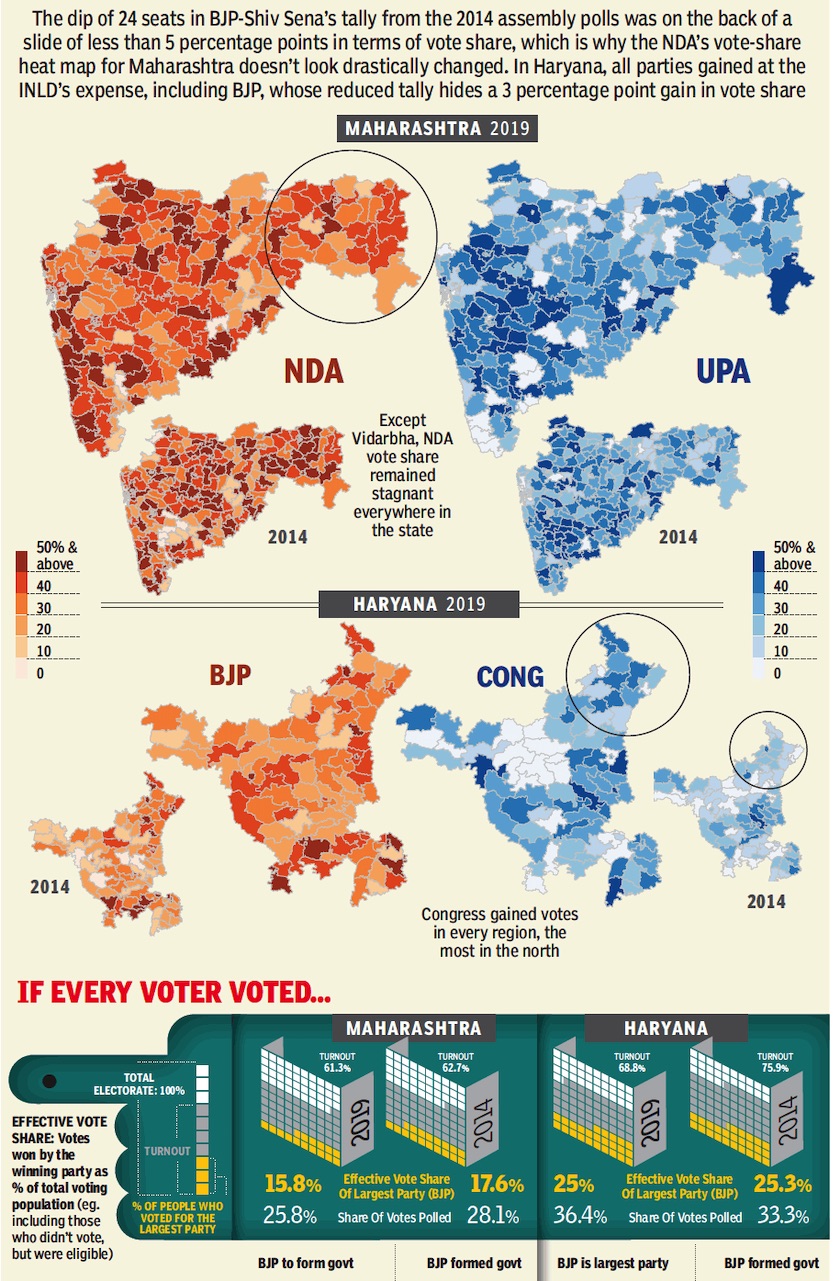
From: Oct 25, 2019: The Times of India
See graphic:
Haryana, Maharashtra assembly elections; by elections, 2019- BJP dips in Vidarbha (Maha), Cong rises in Haryana
Parties in office in states

From: March 11, 2019: The Times of India
See graphic
The map shows parties in office in the states, as in March 2019
Pre-election doles
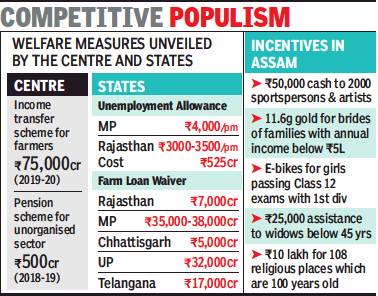
From: Suchandana Gupta & Prabin Kalita , Sops shower: Gold for brides in Assam, jobless dole in MP, February 7, 2019: The Times of India
Scramble To Hand Out Goodies Ahead Of Polls
With elections looming, the political class seems to have its priorities sorted out: It’s politics over economics and voter over the exchequer. The Centre and states have been doling out sops — from farm loan waivers and income support for agriculturalists to unemployment doles and even gold.
In BJP-ruled Assam, finance minister Himanta Biswa Sarma raised the bar by offering gold, estimated to cost Rs 38,000, for brides from families with annual income of less than Rs 5 lakh. He also promised “e-bikes” for all girls who secure first division in higher secondary examination and a one-time subsidy of Rs 50,000 on all education loans sanctioned during the current financial year.
MP is expected to announce a monthly unemployment allowance of Rs 4,000, going one step ahead of Rajasthan which promised Rs 3,000-3,500 a month.
MP govt to double pension for elderly
The Kamal Nath government in MP will also roll out a scheme guaranteeing 100 days of work for urban youth. Sources said the Congress regime will also double social security pension for elderly from Rs 300 to Rs 600. All three decisions were cleared by CM and finance department.
When it’s poll season, taxes are something that no finance minister wants to raise. Last Friday, the Centre offered 100% tax rebate for those earning up to Rs 5 lakh while offering concessions also to senior citizens and the middle class.
On Wednesday, Leftruled Kerala deferred its plan to levy a “flood cess” on GST. It had argued for the cess on the ground that the money thus mopped up would be used for repairing the damage caused by the calamity. There is no clarity whether the state would go ahead with its budget proposal until Lok Sabha elections are over.
The pre-poll gifts come ahead of the general elections, which are expected to be keenly contested, prompting politicians to woo voters with freebies that economists have frowned upon on the ground that they could adversely impact the already-strained exchequer.
Assembly elections, by-elections/ May
May 24, 2019: The Times of India
Jagan takes Andhra by storm, Naveen gets record 5th term
Jaganmohan Reddy's YSRCP sweeps Andhra, Naveen Patnaik’s BJD wins Odisha for a fifth time, and five-time Sikkim CM Pawan Kumar Chamling loses a cliffhanger.
Odisha: BJD beats anti-incumbency to win 28 seats and lead in 84 out of 146 seats, though BJP makes big gains in assembly (likely to win 23) and Lok Sabha polls. Naveen Patnaik lives to fight another day, becoming the third chief minister to get a 5th straight term, after West Bengal former CM Jyoti Basu and Sikkim’s Pawan Chamling.
Andhra Pradesh: Jaganmohan Reddy will replace Chandrababu Naidu as CM after winning 129 and leading in 21 out of 175 seats. Naidu’s TDP is virtually wiped out, and his national plans are in ruins. The way back will not be easy Arunachal Pradesh: BJP well on its way to retain office with a win in 60-seat assembly. Likely to form a government again under CM Pema Khandu.
TamilNadu:AIADMKsettowin nine out of 22 seats in which bypolls have been held, ensuring the Palaniswami government (123 out of 234 seats) can last its full term. Goa: BJP loses Parrikar’s Panjim constituency after 25 years to Atanasio Monserrate (Cong), wins 3 other bypolls West Bengal: In keeping with its gains in LS seats in the state, BJP is on its way to win 4 out of 8 bypoll seats, ahead of TMC (3) and Congress (1).
Sikkim: In a huge upset, CM Pawan Chamling’s SDF (part of NDA) loses. SKM leader Prem Tamang likely to be the new chief minister.
October elections: Five trends
May 23, 2021: The Times of India
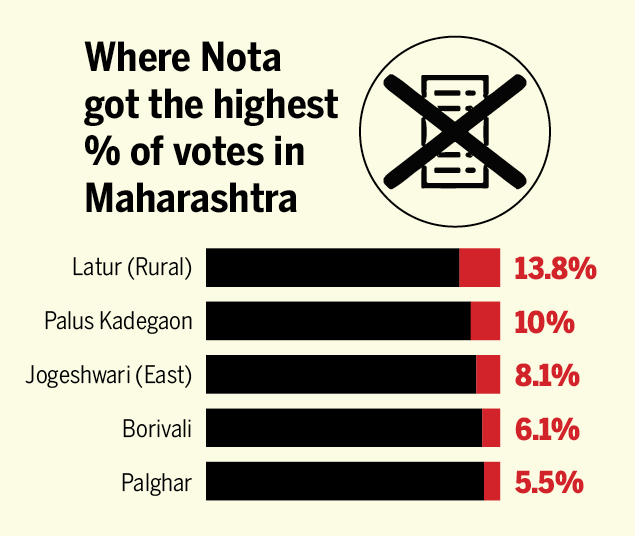
From: May 23, 2021: The Times of India
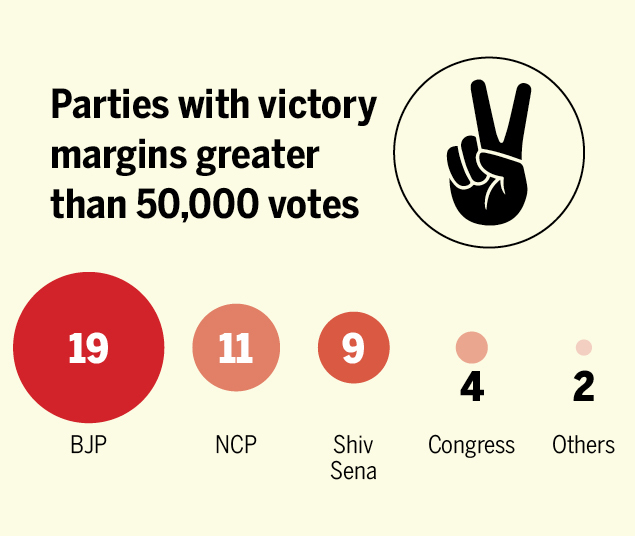
From: May 23, 2021: The Times of India
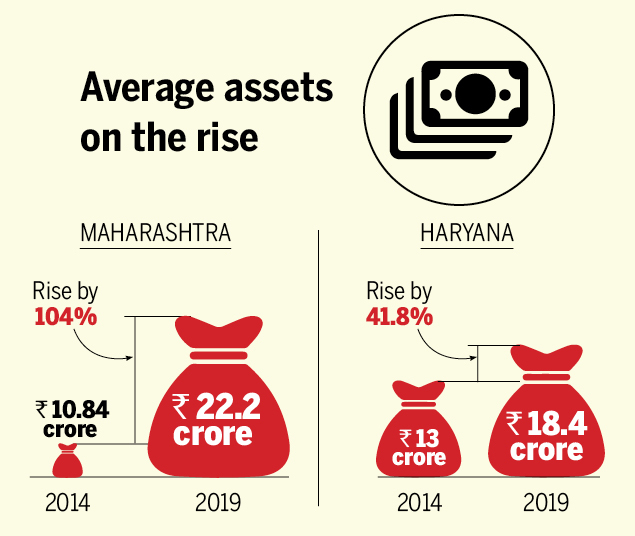
From: May 23, 2021: The Times of India
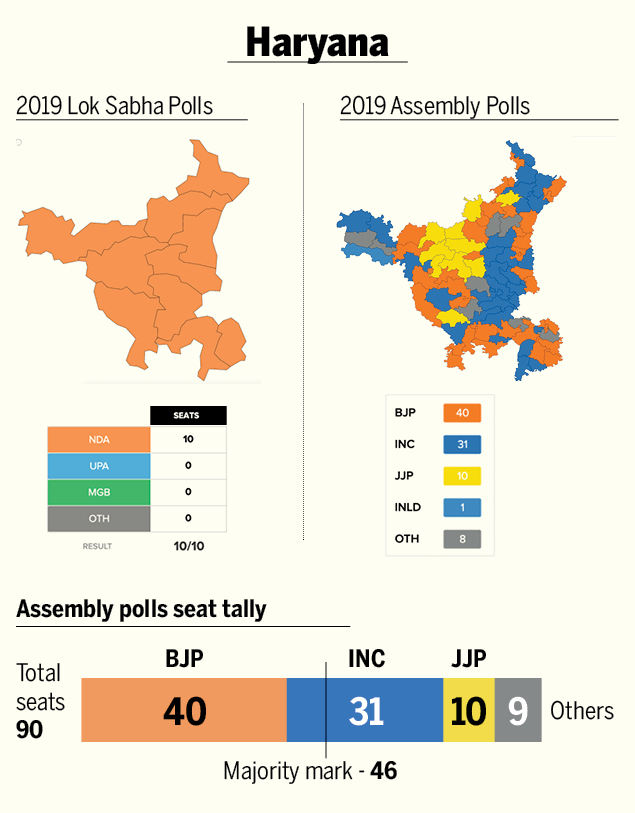
From: May 23, 2021: The Times of India
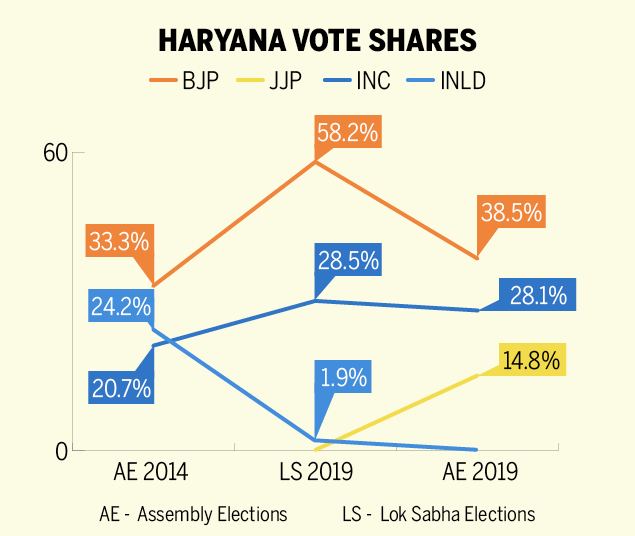
From: May 23, 2021: The Times of India
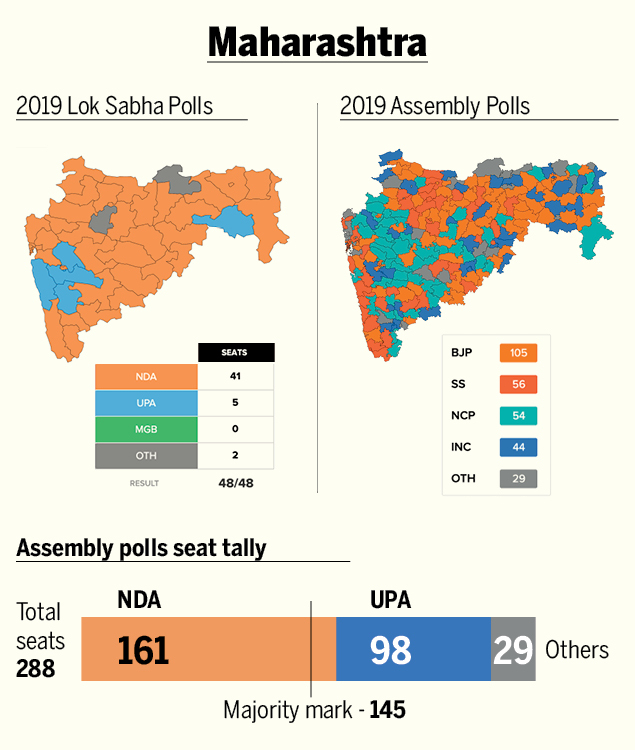
From: May 23, 2021: The Times of India
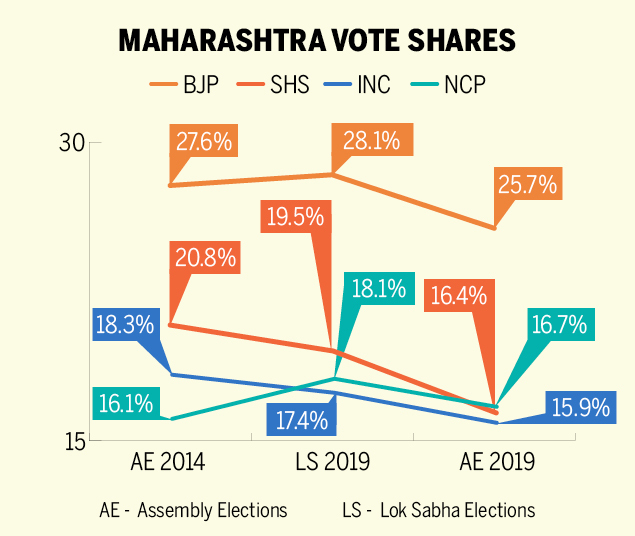
From: May 23, 2021: The Times of India
A record-breaking winner, votes for nobody, millionaire MLAs and other things you may not have known about this week's elections
While the election results in Maharashtra and Haryana have dominated the headlines, poll data from the two states along with byelections held in 51 seats across 18 states have thrown up some interesting trends. Here are some unique ones you should know about.
1. A new political star in Odisha?
Naveen Patnaik-led Biju Janata Dal (BJD) candidate, Rita Sahu, created electoral history by winning the Bijepur bypoll with a record margin of 97,990 votes— the highest-ever for an assembly segment in the state. Rita’s rival Sanat Gartia of BJP got only 37,967 votes.
The scale of Rita’s victory can be gauged from the fact that she polled more votes (1,35,957 ) than Naveen did in the April assembly polls (1,10,166). The chief minister’s victory margin was 57,000, a little over half of Rita’s. Patnaik vacated Bijepur for Hinjili, his traditional seat — after he won both seats in April — which necessitated the byelection.
Before this, the highest assembly seat victory margin in Odisha was 94,555, achieved by current Andhra Pradesh governor and BJP leader Biswa Bhusan Harichandan against the then Congress rival Jagannath Mohapatra in Bhubaneswar in 2000.
Forty-six-year-old Rita entered politics last year after the death of her husband, Subal Sahu, the then Congress MLA of Bijepur.
2. A record number of Indians voted for nobody
The None of the Above (Nota) option appears to be gaining traction with voters. Nota got over 5% votes in five constituencies in Maharashtra. It was runner-up in Latur (Rural) and Palus Kadegaon assembly constituencies where Congress candidates Dhiraj Deshmukh and Vishwajeet Kadam emerged winners. In both the seats, Nota fetched 13.8% (27,449) and 10% (20,572) votes, respectively. The Shiv Sena was relegated to third place. BJP workers in both constituencies say they opted for Nota to protest the party’s move to swap seats with alliance partner Shiv Sena. Nearly 1.45 lakh Mumbaikars also expressed their frustration with the government. In Mumbai’s Borivali, Jogeshwari (East) and Palghar (ST) where Nota got 6.1%, 8.1% and 5.5% of the votes, respectively. Experts attribute this to anger over issues like the tree felling for a Metro car shed in Aarey Colony and the collapse of the Punjab & Maharashtra Cooperative Bank.
In both states, NOTA got more votes than what the Aam Aadmi Party could manage. In Haryana Nota’s vote share was 0.53% as compared to AAP’s 0.48% and in Maharashtra, Nota's 1.37% vote share beat AAP’s 0.11%.
3. Big victories got bigger in Maharashtra
In 45 seats, the margin of victory was over 50,000 votes. Of these, the BJP won 19, the Shiv Sena 9, NCP 11, Congress 4 and others 2. Former Maharashtra deputy chief minister and NCP leader Ajit Pawar won the Baramati assembly constituency by over 1.65 lakh votes — the highest victory margin recorded by a candidate this election.
4. New MLAs are 50% to 100% richer
In Maharashtra, the average assets of the House rose to Rs 22.2 crore in 2019 compared with Rs 10.84 crore in 2014 — a 104% increase. The average assets of MLAs in Haryana stood at Rs 18.4 crore which was 41.8% more than the average of the House elected in 2014. The richest elected MLA in Maharashtra is Parag Shah from the BJP with total assets worth over Rs 500 crore.
5. From national to local in 4 months
A closer look at how people voted in the 2019 Lok Sabha elections and the assembly polls clearly shows that people vote differently on national and local issues. While they may prefer a strong national leader like Prime Minister Narendra Modi, at the state level, local issues and personalities take precedence.
In Lok Sabha polls, the saffron dominance was complete in Haryana, with the BJP winning all 10 seats. In comparison, the assembly election results were a mixed bag for the party.
BJP saw a drastic decline in its vote share in Haryana — from 58% in the Lok Sabha polls, the party’s vote share declined by 22% in the recently concluded state elections.
In Maharashtra, the NDA won 41 of the 48 Lok Sabha seats while the Congress managed just 5. Cut to assembly polls — the BJP-Shiv Sena combine won 161 seats, 24 less than 2014. Both NCP and Congress have made a comeback.
The party’s vote share was 27.59% in the Lok Sabha polls, which fell to 25.7% in the current assembly elections. The Shiv Sena which saw a rise in vote share in the Lok Sabha polls also witnessed a drop in the current polls.
There has clearly been a shift in how voters saw differentiated both parties in the national and the state election.
2019-21: electoral verdicts
Areeba Falak, May 31, 2021: The Times of India
NEW DELHI: On May 30, 2019, Narendra Modi took oath as India’s Prime Minister to serve a second consecutive term in office. The 2019 Lok Sabha elections saw the BJP-led National Democratic Alliance decimate the opposition in several parts of the country.
The BJP not only bettered its 2014 performance but also created a record by winning a majority on its own.
The first two years of the Modi 2.0 government has seen the BJP successfully divide the opposition to get the support of important regional parties for key legislation in Parliament.
While Congress continues to struggle to get its act together and make any meaningful impact, it is the regional leaders who are now leading the fight against the BJP.
Here’s a look at the status of opposition parties in the last two years.
Congress
Congress is the largest constituent party of the United Progressive Alliance (UPA). However, it has lost every state election since 2019 barring the ones where it contested as a minority partner by forging regional alliances.
The only states where Congress could make a comeback in assembly polls are Maharashtra and Jharkhand. But in both these states, it is the junior partner of regional allies.
In Maharashtra, Congress joined hands with its ideological opponent the Shiv Sena and the Nationalist Congress Party (NCP) to form the government.
In Jharkhand, Congress allied with the Jharkhand Mukti Morcha (JMM) to form a coalition government.
In Tamil Nadu, the Congress managed to piggyback on the Dravida Munnetra Kazhagam (DMK), which scripted an impressive win to return to power.
In West Bengal, the Congress, which aligned with the Left, drew a blank and was completely uprooted in a high-pitched battle between the TMC and the BJP.
In Kerala, the Congress-led United Democratic Front (UDF), failed to defeat the ruling Left Democratic Front (LDF) despite the state's history of alternating between the two fronts.
In Assam, the Congress-led an alliance of eight parties called ‘Mahajot’ but failed to unseat the BJP-led NDA government, which won a second consecutive term in the state.
In Puducherry, the Congress-led UPA government lost twice since 2019. First, the Congress-DMK government lost the trust vote in 2020 and then in 2021 elections, conceded the state to NDA.
Dravida Munnetra Kazhagam (DMK)
In the 2019 general elections, DMK was the only party in the UPA alliance that single-handedly reduced the footprint of NDA’s partners in the Lok Sabha elections.
The DMK won 24 of 39 Lok Sabha seats in Tamil Nadu, a massive jump from zero seats it won in 2014.
In the 2021 assembly election, DMK registered a landslide victory after spending a decade as the largest opposition party in the state assembly.
In addition to Tamil Nadu, the DMK also increased its tally in 2021 Puducherry assembly election from two to six.
Samajwadi Party and Bahujan Samaj Party
The SP and BSP, who were long-term rivals in Uttar Pradesh, came together to form a ‘Maha’-gathbandhan ahead of the 2019 Lok Sabha elections to take on the BJP. However, a dismal performance in the general election and failure to dent the BJP in UP put an end to the short-lived alliance.
Since then, both parties have failed to make much of a mark. Outside UP, the SP won two seats in the 2019 Maharashtra assembly election. It joined the Maha Vikas Aghadi (MVA) government led by the Shiv Sena.
Other than Maharashtra, the UP-based SP has not managed any victory in any other assembly election since 2019.
However, ahead of assembly elections next year in UP, the Akhilesh Yadav-led party has performed very well in the three-tiered panchayat polls held in May 2020.
The panchayat polls are not fought on party symbols, however, SP-backed candidates won on more than 1,000 seats compared to the BJP which could register wins in only 800 seats.
Since 2019, the BSP contested in Maharashtra, Jharkhand, Haryana and Delhi assembly elections. However, it didn’t win a single seat in any of these states.
In the 2020 Bihar assembly elections, the BSP contested on 80 seats and won one seat with a 1.5 per cent vote share. In the UP panchayat elections, the BSP won only a little over 300 seats.
Trinamool Congress (TMC)
The Mamata Banerjee-led TMC scripted history in Bengal as she defeated a very determined and aggressive BJP in the just-concluded assembly elections. The BJP used its full might to unseat Mamata, but failed. While the BJP has made huge inroads in the state winning over 70 seats, Mamata has emerged as one of the strongest regional leaders.
Mamta’s latest victory in her home state has perhaps further added to her credentials to lead an anti-BJP front in the 2024 general elections.
Aam Aadmi Party (AAP)
Arvind Kejriwal-led AAP is the undefeated champion of Delhi, having convincingly defeated the BJP.
The AAP won 62 of 70 seats in the 2020 assembly elections with a vote share of 53. 5 per cent.
This makes AAP one of the few regional bigwigs who have been able to hold onto their home turf against the BJP.
However, its performance in the Lok Sabha elections has been disappointing.
Left Front
While the presence of the Left parties in the country is on the decline, the CPM, one of the leading constituents of the Left Front, led by Pinarayi Vijayan in Kerala scripted history by defeating the Congress-led UDF to retain power.
The CPM not just defeated the Congress, but also countered an aggressive BJP challenge in Kerala.
The only other state where Left parties are part of the government is Tamil Nadu where several Centre-Left leaning parties formed the Secular Progressive Alliance (SPA) under DMK’s leadership.
In West Bengal, the Left Front suffered one of its worst defeats in the 2021 assembly elections after failing to win even a single seat.
Telangana Rashtra Samithi (TRS)
In the 2019 general election, TRS had contested all 17 Lok Sabha seats and could win only nine, two seats less than its 2014 tally.
Whereas, the BJP, which did not form any alliance in the state, won four seats on its own. The BJP’s gain in the 2019 LS election was a setback for the TRS as BJP was not even in opposition to TRS in the 2018 assembly elections.
However, in urban local body polls concluded in April 2021, the pink party swept all municipal corporations with Congress coming second and BJP stood a distant third.
The TRS won 181 of the 248 divisions and wards in two municipal corporations and five municipalities.
Yuvajana Sramika Rythu Congress Party (YSRCP)
The Andhra Pradesh-based party has been on a winning spree for the past two years.
The YSR Congress swept the 2019 general election in Andhra, the 2019 Andhra Pradesh assembly election and the 2021 Andhra Pradesh urban local body elections.
The 10-year-old party was founded by YS Jaganmohan Reddy after he broke away from the Congress party.
Strengthening its hold on the state, the YSR Congress also swept the urban local bodies in 2021 by winning in all 12 municipal corporations and 54/55 municipal councils.
Biju Janata Dal (BJD)
The Odisha-based BJD is a regional party that does not subscribe to any political ideology and has cited the development of Odisha as its primary goal.
In the 2019 Lok Sabha polls, the Naveen Patnaik-led party saw a significant reduction in its seat share. It managed to win just 12 out of the 21 seats in 2019. In 2014, it had won 20.
The party, however, managed to hold on to power in the assembly elections that were held simultaneously.
Moreover, its vote share remained consistent in both general and assembly elections
Now, both the BJP and BJD have their eyes set on the panchayat polls scheduled in 2022. The BJP is planning to build on its 2019 successes while the BJD is planning to use its development poll plank.
Astrology and politics
Examining rival candidates' horoscopes
Vinod Khanal, Only in India? Netas study rivals' stars, Feb 6, 2017: The Times of India
Not just their own horoscope, some candidates in UP are checking how deep the competition is for them by getting astrologers to examine their rivals' fortunes as well.
Two prominent astrologers of the city said most of their clients are assuming BJP candidates as their immediate rival. Noted astrologer Fanindra Nath Tripathi said “every candidate wants to know the weak `grah' (planet) of their rivals“. Saying “minor problems can be set right with the help of `havan' and `grah shanti' rituals“, another astrologer is convinced that it is impossible for a candidate to win if the opponent's tars are stronger.“ Netas are known to seek astrologers' help to identify auspicious imes to flag off campaigns, to heck lucky colours, even for heir vehicles and also clothes hat help them impact voters.
But now matters have moved a step further. the trend was also noted by Narendra Giri, mahant, Baghambari Mutt and president, Akhil Bharatiya Akhara Parishad: Many astrologers are exam ning janma kundalis (natal hart) for information of a ontestant's rivals.“ He denies he is advising any candidate.
Forecast of poll results illegal: Election Commission
Mar 31, 2017: The Times of India
HIGHLIGHTS
This amounts to violation of Section 126A of Representation of the People Act, the Commission said
The Act bans dissemination of exit poll results between the start of polling and the end of polling for the last phase
All media are advised to refrain from telecasting/publishing similar programmes in future elections, it added
NEW DELHI: The Election Commission on Thursday held that dissemination of forecast of poll results in any manner, including by political analysts, astrologers or tarot card readers, during the period of exit poll ban was prohibited and amounted to violation of Section 126A of Representation of the People Act.
Pointing to some TV channels that broadcast programmes projecting the numbers of seats likely to be won by political parties during recent polls, EC said this was despite the provisions of Section 126A of the Representation of the People's Act that ban dissemination of exit poll results between the start of polling and the end of polling for the last phase. In its order issued on Thursday, EC made it clear that prediction of results of elections in any form, that is, by astrologers, tarot card readers or political analysts during the prohibited period was a violation of the spirit of Section 126A "which aims to prevent the electors of constituencies still going to polls from being influenced in their voting by such predictions about the prospects of various political parties".
"All media (electronic and print) are advised to refrain from telecasting/publishing similar programmes in future elections during the prohibited period under Section 126A to ensure free, fair and transparent election," ruled EC. "...Such attempts... to score brownie points against the competitors for merely commercial reasons do not behove well," it added.
Congress Breakaways
1947-2014

From: May 11, 2019: The Times of India
See graphic, ' Congress Breakaways, 1947-2014 '
By-elections, 2014 onwards
2014- 2018, May
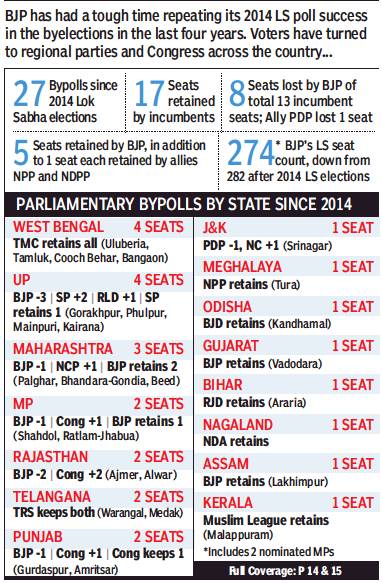
From: June 1, 2018: The Times of India
See graphic:
2014- 2018, May: The results of parliamentary by-elections in India
2018, May: The new MLAs, MPs
See graphic:
2018, May- The newly elected MLAs, MPs;
Vote shares
2020
Nov: Assembly by-elections BJP wins
November 11, 2020: The Times of India
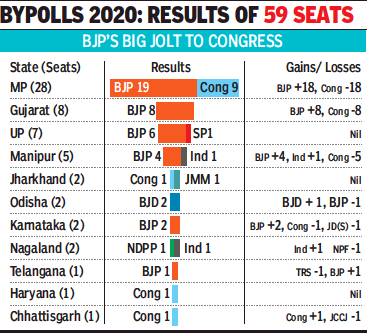
From: November 11, 2020: The Times of India
A BJP sweep in bypolls, crucial gains in MP secure its govt
NEW DELHI: The BJP on Tuesday swept the assembly by-elections held last week winning and leading in 40 of 59 seats across 11 states, including Madhya Pradesh where it cemented its rule by bagging 17 seats and was poised to add two more.
Overall, the Congress, which had sitting MLAs in more than 40 seats, won 11 seats and was leading in one, while two seats were won by the BJD. One seat each was won by the Samajwadi Party, the JMM and the NDPP, and two by Independents, according to the Election Commission data at around midnight.
The BJP bagged 38 seats and was leading in two. India's ruling party wrested all the eight seats from the Congress in Gujarat, four seats in Manipur and also retained its six constituencies in Uttar Pradesh that went to the polls in the first pan-India electoral exercise in the pandemic.
It won two seats in Karnataka and one in Telangana.
The BJP's win in bypolls coincided with its impressive show in the Bihar Assembly elections.
Prime Minister Narendra Modi hailed the BJP victory in the bypolls in MP, UP, Gujarat and Manipur and thanked the voters.
He expressed his gratitude to the electorate in Dubbak seat in Telangana, where the TRS was defeated, calling it a "historic win".
Modi said BJP's victory in Karnataka's Rajarajeshwarinagar and Sira is special and the results reaffirm people's faith in the reform agenda of central and state governments.
BJP chief J P Nadda and other party leaders too thanked the voters and party workers in these states.
Votes were counted for by-elections in Madhya Pradesh (28 seats), UP (seven), Gujarat (eight) Manipur (five seats), Haryana (one), Chhattisgarh (one), Jharkhand (two), Karnataka (two), Nagaland (two), Odisha (two) and Telangana (one).
If the by-elections spelt a big win for the BJP, it seemed dismal for the Congress, particularly in Madhya Pradesh where it earlier had sittings MLAs in 27 seats out of 28. The party won eight seats and was leading in one seat in the state.
However, it did have a few scattered wins, including in BJP-ruled Haryana where it retained its Baroda seat with its candidate Indu Raj Narwal defeating BJP nominee and Olympian wrestler Yogeshwar Dutt. It won one seat each in Jharkhand and Chhattisgarh.
The JD(U) was leading in Valmiki Nagar Lok Sabha by-election in Bihar.
MADHYA PRADESH
The BJP government, which needed eight MLAs for a simple majority, won 17 seats and was leading in two out the 28 Assembly seats in MP where bypolls were held.
A buoyed Chief Minister Shivraj Singh Chouhan said the outcome proves that voters supported the decision taken by the Congress MLAs to pull down the previous Kamal Nath dispensation.
The BJP came to power in March after the collapse of the Congres-led government following a revolt by a section of Congress MLAs led by Jyotiraditya Scindia. The Congress has secured victory on one seat and was leading in eight constituencies.
In the 230-member house, the BJP tally has increased to 124 with the win, providing stability to the government.
Powered by the "progressive agenda" of the government under Chief Minister Shivraj Chouhan and the hardwork of its workers, the BJP has emerged as the "unparalleled choice" of people in Madhya Pradesh, PM Modi said, adding that the people's affection for the party is "invaluable".
MP Congress president Kamal Nath accepted the defeat and said the party made efforts to reach out to people.
"We accept the mandate. We made every effort to reach out to voters. I also thank all voters who participated in the by-elections," Nath said in a tweet.
Despite the BJP's gains, state minister Imarti Devi lost the bypolls from the Dabra assembly seat.
Imarti Devi was among thee Congress MLAs who had switched from the Congress.
Kamal Nath's 'item' jibe at her during campaigning had stoked a controversy.
GUJARAT
The ruling BJP won all the eight assembly seats in Gujarat where by-elections were held, dealing a blow to the opposition Congress which had bagged these constituencies in 2017.
Prime Minister Modi said the bond between the people of Gujarat and the BJP is unbreakable and this affection is again seen in the bypolls victory.
The BJP's tally in the 182-member Assembly has now reached 111.
Eight Congress MLAs had resigned before the Rajya Sabha elections in Gujarat, and five of them, who were given tickets by the BJP, won on Tuesday.
They are Pradhyumansinh Jadeja (who won from Abdasa seat), Brjesh Merja (Morbi), Akshay Patel (Karjan), Jitu Chaudhari (Kaprada) and J V Kakadiya (Dhari).
On the Limbdi seat in Surendranagar district, former minister Kiritsinh Rana of the BJP, who lost in 2017, defeated Congress' Chetan Khachar.
On the Scheduled Tribe-reserved Dangs seat, BJP candidate Vijay Patel was declared the winner by the EC.
The BJP's Dalit leader and former minister Atmaram Parmar, who had lost in the last election, defeated Mohan Solanki of the Congress on the Gadhada (SC) seat in Botad district.
As party workers broke into celebrations and burst firecrackers at its headquarters in Gandhinagar, Chief Minister Vijay Rupani told reporters his party's performance was a “trailer” for the upcoming elections to local bodies and the 2022 assembly polls.
UTTAR PRADESH
The BJP, which already has a comfortable majority in the UP Assembly, retained six seats and the SP hung on to its Malhani constituency in the bypolls for seven assembly seats, the 6:1 outcome indicating that the ruling party continued its hold over the populous state.
BJP candidate Sangeeta Chauhan won in Naugawan Sadat, Usha Sirohi in Bulandshahr, Prem Pal Dhangar in Tundla, Shrikant Katiyar in Bangarmau, Satya Prakash Mani Tripathi in Deoria and Upendra Nath Paswan in Ghatampur, according to the Election Commission.
Samajwadi Party's Lucky Yadav won Malhani, the seat which was represented by his father Parasnath Yadav, whose death necessitated the by-election. He defeated independent candidate Dhananjay Singh by 4,632 votes.
A tough see-saw battle was fought for the Naugawan Sadat seat held earlier by Chetan Chauhan, the former cricketer who was a minister in Yogi Adityanath's BJP government.
MANIPUR
According to Election Commission, the BJP had won four seats and one was bagged by an Independent. The by-elections were necessitated as Congress MLAs quit the party to join the BJP.
In Singhat assembly constituency, BJP candidate Ginsuanhau was elected unopposed in October this year.
KARNATAKA
The ruling BJP won both the seats for which by-elections were held, wresting Sira from the JD(S) and Rajarajeshwari Nagar from the Congress. It created history by recording its first-ever victory in the Sira assembly segment Dr C M Rajesh Gowda winning with a margin of over 12,000 votes.
In R R Nagar, N Munirathana emerged winner with a margin of over 58,000 votes against his nearest Congress rival Kusuma.
JHARKHAND
The JMM-led ruling coalition of Jharkhand retained Dumka and Bermo assembly seats, albeit with reduced margins from the 2019 state polls.
JMM candidate Basant Soren, who is the younger brother of Chief Minister Hemant Soren, defeated his nearest BJP rival Lois Marandi, a former minister, by 6,842 votes, in Dumka seat.
The winning margin of the Jharkhand Mukti Morcha reduced almost by half compared to what it was in last year's assembly election.
In Bermo constituency, Kumar Jayamangal alias Anup Singh of the Congress defeated Yogeshwar Mahto "Batul", his nearest BJP rival, by a margin of 14,225 votes.
ODISHA
The state's ruling Biju Janata Dal won both the Balasore, which was held by the BJP, and Tirtol seats for which by-elections were held.
HARYANA
In a big win for the Congress, its candidate Indu Raj Narwal defeated the BJP's candidate, Olympian wrestler Yogeshwar Dutt, in the Baroda assembly seat in BJP-ruled Haryana.
The Congress retained the seat with Narwal winning by over 10,000 votes, said officials.
“The victory of Indu Raj Narwal is a win of farmers and labourers. I assure residents of Baroda that the Congress will live up to their expectations,” tweeted Congress leader Kumari Selja.
CHHATTISGARH
The ruling Congress won the Marwahi Assembly bypoll, necessitated by the death of Janata Congress Chhattisgarh (J) founder Ajit Jogi.
Congress candidate Dr K K Dhruw won by 38,197 votes.
TELANGANA
The BJP wrested the Dubbak Assembly constituency from the ruling TRS in Telangana.
BJP candidate M Raghunandan Rao defeated his nearest rival Solipeta Sujatha of the ruling TRS by 1,079 votes.
Sujata was the wife of sitting TRS MLA Solipeta Ramalinga Reddy whose death in August this year led to the bypolls.
NAGALAND
The National Democratic Progressive Party bagged the Southern Angami-I seat in Kohima while an Independent candidate won in the Pungro-Kiphire assembly segment in Kiphire district.
The votes for the November 3 and 7 by-elections were counted along with the ballots for the Bihar polls and progressed in accordance with Election Commission guidelines restricting the number of people in counting halls, officials said.
15 of 22 Scindia loyalists win in MP
November 11, 2020: The Times of India
Fifteen of 22 loyalists who followed Jyotiraditya Scindia from Congress to BJP won the bypolls. “The results have proven Kamal Nath and Digvijaya Singh are the traitors,” Scindia said, returning the invective used against him.
BJP snatches all 8 Cong seats in Guj
November 11, 2020: The Times of India
BJP won all eight seats in Gujarat bypolls, taking its tally to 111 in the 182-member assembly. Congress, which had won these eight seats in the 2017 polls, has 65 seats. “This is a trailer before the ’22 state polls,” CM Vijay Rupani said.
Political parties’ changing fortunes
1961-2019
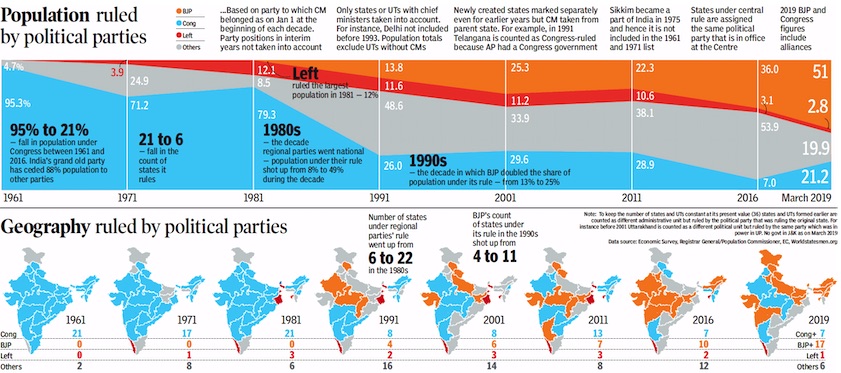
From: March 12, 2019: The Times of India
See graphic:
The Political parties’ changing fortunes in the states, and India as a whole: 1961-2019
Election slogans
1947-2019
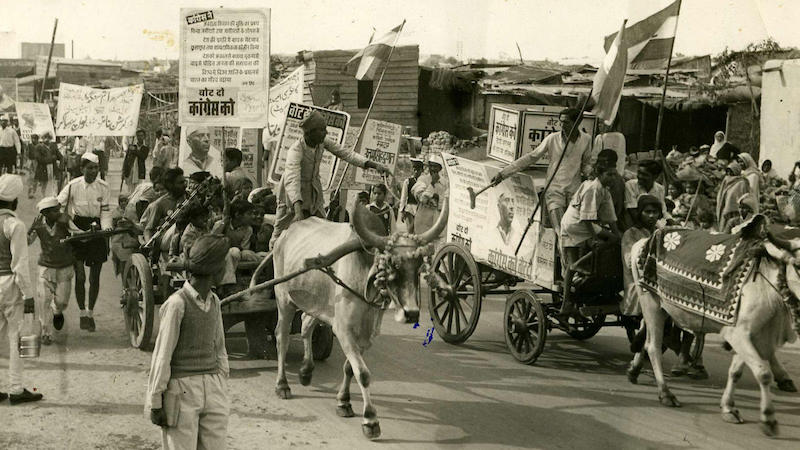
From: Avijit Ghosh, From ‘Garibi Hatao’ to 'Achche din'… poll slogans shape election campaigns, March 20, 2019: The Times of India
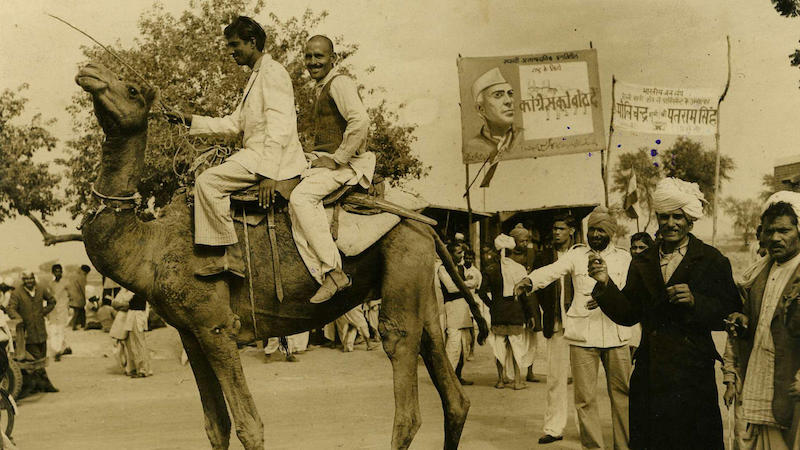
From: Avijit Ghosh, From ‘Garibi Hatao’ to 'Achche din'… poll slogans shape election campaigns, March 20, 2019: The Times of India
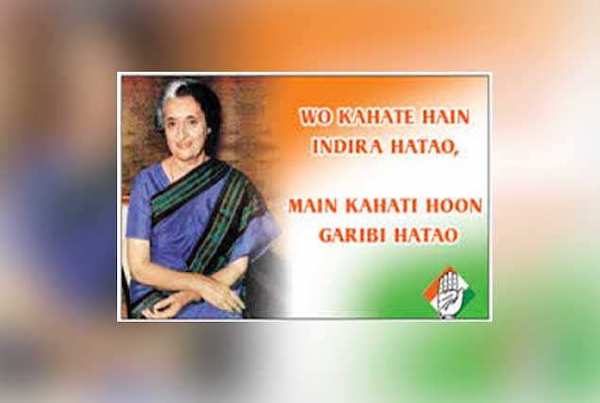
From: Avijit Ghosh, From ‘Garibi Hatao’ to 'Achche din'… poll slogans shape election campaigns, March 20, 2019: The Times of India
During the third Lok Sabha elections, a Poona-based newspaper reported that one of the Hindi slogans shouted in a Jana Sangh procession was “Death to Pandit Nehru ( Nehru ki maut)”. Members of Jana Sangh, the previous avatar of BJP, emphatically denied this, pointing out that the slogan was “ Wah re Nehru teri mauj / gharme hamla bahar fauj”, which “pointed out the paradox of Nehru's policy of sending the Indian army abroad when Indian frontiers were threatened”.
The 1962 incident mentioned in VM Sirsikar’s book, Political Behaviour in India (1965), shows how a poll slogan or its alleged misinterpretation could create a stir even in early 1960s India. After all, slogans encapsulate the distilled vision of a political party. They crisply communicate a party's core stance. For instance, a photograph of the 1951-52 elections published in ECI’s book, Unfolding Indian Elections, shows a Congress poster with the face of Nehru and the phrase “ Sthayi, asampradiyik pragatisheel rashtra ke liye (For a stable, secular and progressive nation)”, underlining what the party stood for.
India enjoys a rich history of fruitful political watchwords. The best among them are pithy, crisp and prompted high recall: Congress’s “ Garibi Hatao” (1971) and BJP’s “ Ab Ki Baar, Modi Sarkar” (2014), to name just two. In recent times, the job of coining slogans is often outsourced to overpaid media planners and smart speech writers. This wasn’t the case in the early post-Independence years, says political scientist C P Bhambri.
A college student in 1951, Bhambri attended an election meeting addressed by Nehru in Kanpur’s Phool Bagh. “In his speech, he said, ‘ Naya bharat banayenge (We will build a new India)’, and ‘ Sampradayikta ko jadh se ukhadh phekna hai (We have to uproot communalism)’. The next day the Congress workers were shouting these lines in their political processions. In those days, slogans emerged organically from the extempore speeches of leaders who knew how to communicate,” says Bhambri, who taught at JNU.
In the 1950s, India’s literacy was 18%. Hence, the spoken word was more important than the printed word. In 1957, as a lecturer at a Meerut college, Bhambri again heard the Prime Minister during the 2nd Lok Sabha polls. “Nehru said, ‘ Humein chhalang marni hai (We must take a leap)’. We must end poverty and backwardness,” he said, echoing the need to accelerate development.
Poverty figures stayed high, nonetheless. As per RBI’s Handbook of Statistics on the Indian economy, 55% Indians were still below the poverty line in 1973-74. Unsurprisingly, the “ Garibi Hatao” slogan had the maximum resonance among 36 slogans used by Congress in Delhi in the 1971 polls. The full slogan, translated from the Hindi, goes: “They say Indira hatao, Indira says, Garibi Hatao.” Twenty-four out of 81 prospective voters recalled this slogan in a poll carried out by Prayag Mehta for his book, Election Campaign (1975). Another 22 recalled the catchline “Vote for Socialism, Vote Congress”. “A large majority of those who recalled these two posters belonged to the low socio-economic group,” wrote Mehta.
Slogans are also tweaked to capture the mood of the times. When the public turned against Indira Gandhi post-Emergency, the Opposition reworked Indira’s 1971 slogan and produced the hugely popular exhortation “ Indira Hatao, Desh Bachao ( Remove Indira, Save the country". When the Janata government imploded after infighting, Congress came up with the 1980 slogan, Sarkar woh chune jo chal sakey (Elect a government that functions). The early 1990s saw the arrival of the coalition era. After National Front’s coalition government, which lasted from Dec 1989 to Nov 1990, political parties felt that the people would like to vote for a stable regime. Consequently, there was an emphasis on stability in the campaign slogans.
Popular Political Slogans Over The Years
1. "Jai Jawanm Jai Kisan
2. Garibi Hatao
3. Indira Hatao, Desh Bachao
4. Sabko dekha baari baari, is baar Atal Bihari
5. Haathi nahin, Ganesh hai, Brahma, Vishnu, Mahesh hai
6. India Shining
7. Congress ka haath, aam aadmi ke saath
8. Achche din aane waale hain
9. Kattar soch nahi, yuva josh
10. Modi hai toh mumkin hai
Meenu Roy’s book, Battle of the Ballot, which examined the 1991 campaign, lists a bunch of slogans that Rajiv Gandhi’s Congress came out with. One, “Vote stability, Vote Congress”; and two, “ Na jaat par, na paat par, sthirta ki baat par, mohar lagegi haat par (Don’t vote for caste or community but for the Hand that brings stability).” The word sthirta, meaning stability, was introduced to rework an old slogan bearing Indira’s name. The expression, na jaat par, emphasising Congress’s attempt to arrest the exit of those voters who were moving towards caste identity based platforms.
The job of coining slogans is often outsourced to overpaid media planners and smart speechwriters. This wasn’t the case in the early post-Independence years
For the same campaign, BJP had the line “ Subko parkha, Humko parkho (You tried everyone, now try us)”. Another catchline went, “ Ram, roti aur sthirta”, which underlined the party’s involvement with the Ramjanambhoomi movement. In 1998, “ Abki baari, Atal Bihari (This time Atal Bihari)” became BJP’s catchphrase.
Now, as the 2019 LS polls loom, parties are again emerging with fresh slogans. BJP already has two: “ Modi hai to mumkin hai” and “Phir ek baar, Modi Sarkar” – the slogans stressing that the party’s campaign will focus on the Prime Minister. Reports say Rahul Gandhi’s Congress is crowdsourcing its catchlines from its party workers and has already received about 15 lakh slogans. Whose “ achche din” they will usher in remains to be seen.
Funny slogans
The 5 wackiest slogans of Indian elections | IndiaTimes/ The Times of India
The 5 wackiest slogans of Indian elections
Elections in India seem to stir up the creative faculties of the copywriters of political parties — never mind that slogans on their own have rarely won the elections, though they have made the campaigns fun. Here’re some of the wackiest campaign slogans:
Health awareness: Hindutva politics may split India between the pro and anti camps, but in 1967 Lok Sabha polls, the Hindutva brigade was concerned about the health of Indians — coining the slogan Jan Sangh ko vote do, beedi peena chhod do; beedi mein tambaku hai, Congress wala daku hai (Vote for Jana Sangh, Stop smoking bidi. Bidi has tobacco, Congressmen are dacoits). Did it work? Yes and no — the Jana Sangh more than doubled its tally to 35, from 14 in 1962 but was nowhere close to forming a government while the Congress lost 78 seats.
The rebound: In 1978, Indira Gandhi, still licking the wounds of her electoral loss from Rae Bareli in 1977 in the Janata Party wave, contested from Chikmagalur in Karnataka, with the election slogan Ek Sherni, Sau Langur; Chikmagalur, Chikmagalur (one tigress versus hundreds of chimpanzees) which was a jibe at the infighting that had become public between the various constituent parties of the Janata Party government. Did it work? Apparently yes, as Gandhi returned to Parliament and then engineered the government’s break-up, forcing a midterm election in 1980.
Big guns: The 1989 Lok Sabha elections, which saw former ministers in the Rajiv Gandhi government — V P Singh, Arun Nehru and Arif Mohammad Khan — turn against him on allegations of corruption regarding the purchase of Bofors artillery guns for the army, had Singh’s camp coining slogans against Gandhi and his family like Galon mein jo lali hai, Topon ki dalali hai (the secret of Gandhi family’s prosperity is the kickbacks from the Bofors gun deal). Did it work? The Congress’ defeat was more due to charges of corruption rather than due to campaign slogans. In any case, Singh’s government didn’t even last a year.
Imitation game: Remember the 2014 BJP slogan Ab ki Baar, Modi Sarkaar (This time vote for a Modi government) which was even fancied by Donald Trump for his 2016 presidential campaign (Ab Ki Baar, Trump Sarkaar)? Well, the inspiration for that came from the campaign of another BJP stalwart and former PM Atal Bihari Vajpayee when the party, in 1996, contested on the slogan Bari Bari Sabki Bari, Abki Bari Atal Bihari (Everybody got their chance. Now, it's Atal Bihari’s turn). Did it work? Not really, considering that Vajpayee’s minority government fell after just 13 days in power, unable to prove majority.
Snack time: The rustic maverick politician from Bihar, Lalu Prasad Yadav, with over four decades of experience of contesting elections — he first contested and won in 1977 — was probably in need of reinvigorating his campaign in the 1990s to offset voter fatigue, which explains the slogan he coined: Jab tak rahega samose mein aaloo, tab tak rahega Bihar mein lalu (As long as there’s potato in the samosa, there’ll be Lalu in Bihar). Did it work? Off and on, though it’s mostly off for the last few elections as Lalu struggles to remain relevant in state and national politics.
1990s-2019
Ruchir Sharma, April 28, 2019: The Times of India
Can a witty one-liner win an election?
Campaign slogans have a colourful history in India, in part because Hindi lends itself to rhyming and word play, and for centuries has been generating catchy phrases and one-liners on just about everything. In politics slogans aren’t enough to secure victory, but our memories of landmark elections are often encapsulated in the catchiest slogan, usually from the winning side. So with Narendra Modi asking for ‘Phir Ek Baar, Modi Sarkar’, and the Congress promising yet more welfare benefits, which side will coin the defining slogan of 2019?
Today’s slogans have a pedigree that dates back to long before I started following Indian campaigns in the late 1990s. People were still talking about how Indira Gandhi won her crushing 1971 victory under the slogan, ‘Garibi hatao, Indira lao, Desh bachao’. When she was assassinated in 1984, her son Rajiv capitalised on the surge of sympathy, winning the election that year under the slogan, ‘Jab tak sooraj chand rahega, Indira tera naam rahega’. Throughout my campaign travels, Congress slogans have been playing up these two themes: the glory of the Gandhis, and their commitment to helping the poor.
Watching from the backbenches, the BJP wrote slogans that tried to tap popular frustration with decades of Congress rule. Atal Bihari Vajpayee captured the frustration in the slogan that swept him to power briefly in 1996: ‘Sabko dekha baari baari, Abki baari Atal Bihari’. Nearly two decades later the BJP was still milking the same impatience, in a 2014 slogan that went viral: ‘Ab ki baar, Modi sarkar!’ Some of the sharpest attacks on Congress came from the street, most memorably a 2002 ditty my companions and I heard in Dehradun, linking Narayan Dutt Tiwari to the Gandhis by scurrilous reference to rumours about his personal leanings: Na Nar Na Nari, Indira Ke Pujari, Sanjay Ki Savari, Narayan Dutt Tiwari. As the BJP rose, Congress leaders continued to drink from the Gandhi glamour pool in slogan after slogan. No Gandhi has featured more prominently in Congress one-liners than Indira, still a martyr to millions. In the 2009 election, party slogan writers found her reincarnation in Sonia: ‘Sonia nahi yeh aandhi hai, doosri Indira Gandhi hai’. And three years later they saw her in Priyanka: ‘Priyanka nahin aandhi hain, doosri Indira Gandhi hai’.
By then the BJP was starting to build the personality cult around Modi, and establish him as the rising star that could block the Gandhi sun. When he arrived at 2012 rallies in Gujarat the crowds would chant, ‘Dekho dekho kaun aaya . . . Gujarat ka sher aaya’. By 2014, BJP sloganeers were implying that Modi, the challenger, had already won: ‘Har Har Modi, Ghar Ghar Modi!’ Meanwhile the regional parties were rising as a third force, building up their leaders’ personas through combative punchlines. None were more revealing than those coined to promote Mayawati in UP: her evolution from angry Dalit champion to friend of Brahmins and back again is documented in the shifting tenor of her slogans — from ‘Tilak, tarazu aur talwar, inko maro joote chaar’ to ‘Sarvajana sukhaya, sarvajana hitaya’ and then ‘Satta ki chaabi hum aise jaane nahin denge’. When she tied up with the BJP in 2002, they tried to sell the deal with slogans like ‘Haathi Nahin Ganesh Hai, Brahma Vishnu Mahesh Hai’. This time, Mayawati is teaming up with Akhilesh Yadav to stop Modi in UP. They haven’t put it in writing yet, but their message evokes a slogan Akhilesh’s father Mulayam used after the destruction of the Babri Masjid: ‘Mile Mulayam-Kanshiram, hawa ho gaye Jai Shree Ram’. Family dynasties are an integral part of Indian politics and that’s reflected in the slogans. Our election trip group saw that phenomenon play out in its full element during the UP state election in 2017. When we met Akhilesh in his chief ministerial bungalow in Lucknow, he avoided talking about his uncle Shivpal but spoke reverentially of his father. One of his campaign slogans was: ‘Akhilesh ka jalwa kayam hai, uska baap Mulayam hai.’ In addition to establishing powerful personalities and marking caste lines, slogans have often summed up in three words the economic aspirations of the day. The slogan of the 1990s was ‘Roti, Kapda, Makaan’. During our 2002 trip we saw that recast as ‘Bijli, Sadak, Pani’, which was superseded in the next decade by ‘Shiksha, Vigyan, Vikas’. By 2015 Modi had pushed that forward to ‘Padhai, Kamai, Davai’ when we saw him speak at a rally in Muzaffarnagar during Bihar’s state elections. As we travelled back, we wondered whether voters would respond to increasingly ambitious promises when many still struggled to put food on the table, and indeed they did not. The 2015 Bihar election ended in defeat for Modi and the BJP.
This was not the first time BJP slogans had gotten too far ahead of voters. Back in 2004 when pundits around the world were hailing the rise of India, international praise went to the heads of BJP mandarins under PM Vajpayee. The BJP’s boastful English slogan ‘India Shining’ was rejected, particularly by rural voters whose lives were still far from shining. By 2014, the BJP was promising a very different future under the slogan ‘Achhe Din Aane Wale Hain’, and won handily.
Five years later, Congress continues to invoke the poverty-fighting spirit of Indira, and the BJP is still running as the outsider. In its 2019 slogan ‘Ab hoga Nyay’, Congress is making a double play on “justice” and the acronym for its new basic income guarantee. The BJP responds with ‘Phir ek bar, Modi sarkar’, as if the scales of power won’t be balanced until it has ruled for as many terms as Congress did. That seems risky in a country where voters have been turning against powerful incumbents since the late ’70s. But then Modi has proven to be a master sloganeer like few others in a country obsessed with witty one-liners.
Sharma is the author of ‘Democracy on the Road: a 25-Year Journey Through India’
Election symbols
Janata Party's symbols
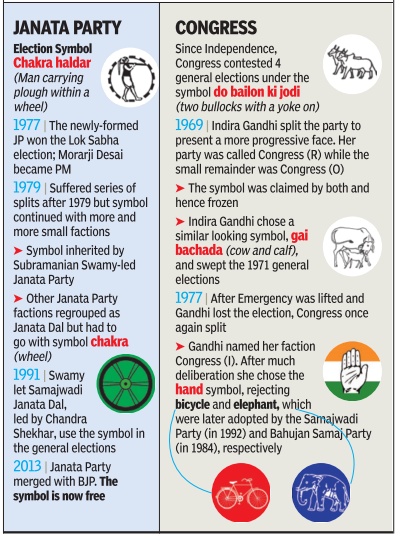
See graphic:
How the election symbols of the Congress and the Janata Party changed over time
BJP, Congress’ symbols, 1951-2014
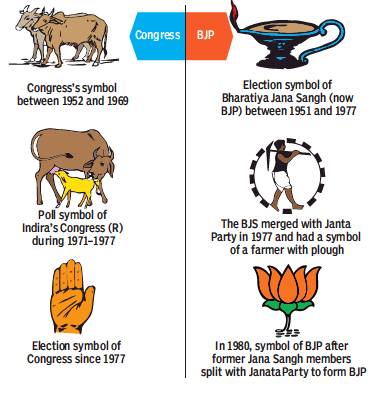
From: April 5, 2019: The Times of India
See graphic:
How the election symbols of the Congress and the Bharatiya Janata Party changed, 1951-2014
The (bi)cycle
Many have ridden the cycle to victory, Jan 17, 2017: The Times of India
Few elections symbols have been as bitterly fought over as the modest cycle.Much before the father-son duo of Mulayam Singh Yadav and Akhilesh Yadav began their fight-to-the-finish in UP, the cycle was a subject of electoral dispute in Andhra Pradesh and Tamil Nadu too.
The 1996 Lok Sabha election campaign in Andhra Pradesh was marked by acrimony between rival Telugu Desam Party (TDP) factions led by the late N T Rama Rao's son-in-law N Chandrababu Naidu and his wife Lakshmi Parvathi. The EC had given the `cycle' symbol to Naidu. At public meetings, Parvati would often tell the crowd that they must vote for the `lion' because “the cycle has been stolen by thieves“.
Naidu had dethroned the superstar-CM in August 1995; the `coup' being planned in a defunct movie theatre, Basant Talkies, located in a small lane at Narayanaguda crossroads in Hyderabad. NTR's family stood by Naidu, along with a majority of MLAs, giving him the edge in the battle for the symbol. Naidu showed off more than 200 out of the state's 294 legislators which clinched the case in his favour.
In Tamil Nadu, Tamil Maanila Congress (TMC), led by G K Moopanar, was allotted the `cycle' symbol after he quit Congress on the eve of the Lok Sabha and assembly elections in 1996. TMC, in DMK's company , romped home with a massive majority in the assembly and bagged all the Lok Sabha seats too.
After Moopanar's death in 2001, his son, former Union minister G K Vasan, merged the party with Congress. In 2014, he walked out of the party like his dad, and tried to revive TMC. Despite desperate efforts, Vasan could not get the `cycle' symbol. “The EC denied us the symbol citing its use in two other states,“ said Vasan. He had to settle for `coconut farm' as TMC's symbol in the 2016 elections, in which he drew a blank. TN chief electoral officer Rajesh Lakhoni said, “The `cycle' symbol was not allotted to TMC as it was allotted to SP, which was also contesting the assembly election in Tamil Nadu.“
In the early decades after Independence, the cycle was a totem of upward mobility in both the hinterland and urban India. Transistor, watch and cycle were three essentials in any wedding shopping list in north India. Even in recent years, it is a preferred gift for political parties. Ask Nitish Kumar, Mamata Banerjee, or, even Akhilesh.
It remains a desired election symbol too. Currently , the cycle is SP's symbol in UP and other states like Bihar and Uttarakhand, where the party enjoys a degree of influence.TDP in Andhra Pradesh and Telangana, Jammu & Kashmir Panthers' Party in J&K, Kerala Congress in Kerala and Manipur People's Party in Manipur also use the symbol.
“While it is reserved for SP in UP , in other states it can be allotted to other parties as SP is not a national party like BJP and Congress, whose symbols cannot be given to any other party in any other state,“ said former CEC N Gopalaswami.
Political scientist Imtiaz Ahmed says that election symbols encapsulate a party's history. “Whoever gets the symbol after an intra-party warfare inherits all that the party has done in the past. Symbols give you legacy ,“ he said. In a country where over 25% are still illiterate, a symbol also becomes part of a voter's hardwired memory . “Many people still put their stamp on the ballot paper without looking at the party's name,“ he said.
In recent years, social media platforms such as WhatsApp are being used to communicate with the voter in remote areas. Yet symbols remain vital even today , says former JNU professor Dipankar Gupta. “Even if 20% of potential voters don't know about a new symbol, it becomes a matter of concern for the party ,“ he said.
Farmers’ agitations
2020: the issues
NAJEEB JUNG, HARDEEP SINGH, December 6, 2020: The Times of India Jung is the former Lt Governor of Delhi. Hardeep Singh has served as chairman of the Monitoring Committee on MSP, Planning Commission and chairman of Cargill South Asia
Centre should have built consensus on farm bills, carried states along
Over the past few years, there have been multiple agitations across the country. Protesters have included students who had ideological differences with university administrations as well those against CAA/NRC. Now, farmers from Punjab, Haryana and western UP have hit the road, braving batons, tear gas, water cannons and the heavy hand of the state. Students and citizenry from as far away as New York and Canada are coming out in their support. As for the government, it initially displayed a failure to grasp the gravity of the situation by giving a date as late as December 3 to meet with the agitators, and is now doing some ministerial scrambling to try and steady the ship.
The question being asked by many in India is whether the farmers have a legitimate grievance? The new laws they are incensed by are not widely understood, so bear explaining.
The first of the three new laws is the essential commodities act, an outdated legislation which applies largely to traders, and has already been correctly watered down over the years. It has now been further diluted. Farmers should not be much bothered with it. They may actually be beneficiaries as it deters selective misinterpretation of the act. The second law primarily enables contract farming. Here again farmers should have no reason to be upset. Broad acre farming (rice/ wheat/ corn/ sugarcane etc) is not an area corporates will easily venture into. Pepsi and Unilever have already burnt their fingers with contracted tomato growing. Plantations (tea/coffee/ rubber etc) are a different proposition. Corporates already operate in those domains, with mixed success. We do not see many lining up for distressed plantation assets!
It is the third law — the FPTC Act (Farmers Produce Trade and Commerce Act) where the farmers see a hidden agenda. It permits sale and purchase of agricultural produce outside regulated markets (mandis covered under the APMC act). Prima facie, farmers should welcome this legislation since it weeds out middlemen but instead they see it as paving the way for the government to back away from its decades-old legacy obligation to purchase produce at minimum support prices (MSP). MSP is declared nationally by the Centre before each crop season, but government purchases are predominantly in areas of large marketable surplus such as Punjab, Haryana and west UP. This encourages production of key crops to feed the deficit in other states, and gives farmers a guaranteed income.
The government is saying it has no intention to avoid MSP obligation (even though there is no legal obligation to purchase at MSP). Farmers ask: why then the new legislation, if not to prepare ground to resile from the MSP obligation? Therefore, this third law is what farmers see as opaque, and inimical to their livelihood.
It would have been much better for the central government to introduce changes transparently and gradually reduce declared MSP season-on-season to align markets with changed priorities. However, the political leadership thought they could get away with pushing through legislation to whittle down MSP purchases without debate. This may now backfire and farmers may insist on making MSP a legal right, which it has not been thus far. Government would still have the right to reduce/ tinker with declared MSP amounts, but farmer leaders can now be expected to be vigilant. They will now probably ask for transparent and debated mechanisms on setting MSPs. In a way this charade may well turn out to be a self-goal for the government. Importantly, federalism has been given a go-by. Agriculture is a state subject, but there is a grey area when it comes to regulating interstate trade. It would have been sensible to build some consensus and carry the states along. In the case of these angry farmers, it will now be difficult to bridge the trust deficit between a largely urban national leadership and farmers.
What we see at the borders of Delhi are the brave frontrunners. Behind them, applauding and supporting their courage is the vast majority back in villages who have organised themselves to manage the farms and cattle of the farmers at our gate. The sincerity of the protestors, who call themselves ‘nai azaadi ke paravane’, is resonating with many people while attempts to brand them by terrorist intent or political affiliation have failed. The ruling dispensation have been well advised not to send out their anti-protest storm troopers as they are dealing with a tough lot who are not deterred by cold water cannons or dug up roads. This may well turn out to be the winter of discontent for the government.
Historical wounds
Somnath to Ayodhya: 1951-2019
Amulya Gopalakrishnan, Nov 10, 2019: The Times of India
Before Ayodhya, there was Somnath. For many, Mahmud of Ghazni’s destruction of the Shiva temple in Saurashtra, Gujarat, in the 11th century is the foundational crime that still reverberates—the Islamic invasion that can’t be forgiven or forgotten.
The temple was reconstructed in newly independent India, on Sardar Patel’s initiative, and inaugurated by President Rajendra Prasad despite Prime Minister Jawaharlal Nehru’s ‘secular’ misgivings about the event. For the Hindu Right, this is a deeply moving story of trauma and belated justice. During the Ram Janmabhoomi movement of the 1990s, L K Advani’s rath yatra was from Somnath to Ayodhya.
But historical memories are not first-hand descriptions, they are a skein of stories from various sources. Historian Romila Thapar has detailed the narratives around this event with context in her book Somanatha: The Many Voices of a History. Turco-Afghan chronicles embellish Mahmud’s valour and destruction, and local accounts are more subdued. Did the trauma to Hindu hearts across India silently endure for 800 years, or was it fanned by events in the 19th century? The Hindutva camp sees Hindus and Muslims as monolithic communities that have always clashed. Today’s Muslims are identified with medieval raiders and rulers, and today’s Hindus are called to avenge past humiliations. Professional historians disagree. Thapar’s counterview is that in the past, Hindus and Muslims were not all-encompassing categories. Places of worship were targeted for their wealth, and as power-play. Islam was not one entity—Mahmud fought Shias and Ismailis, and Hindu identity was not unified either. While there were clashes, cultures also seeped into each other.
Communalised historywriting began with the British, and was informed by Western stereotypes of Islam. Their division of the complex past into Hindu and Muslim periods to legitimise their own “impartial” administration, deepened the rifts between Hindu and Muslim nationalists.
Somnath became a flashpoint after1842 when Governor General Lord Ellenborough ordered a set of sandalwood gates from Ghazni to be brought back to India, saying “the insult of 800 years is at last avenged”. It caused a furore in the British House of Commons for its communal intentions, and the gates were later found to be fake.
While Thapar is reviled by Hindutva historians, they have not made an alternative case. But as with the Babri Masjid, cold facts don’t seem to matter, because the Somnath Temple acquired huge emotional significance for Hindutva politics in the last century and a half. In 1927, the traditionalist Congress leader from Gujarat, K M Munshi wrote a historical romance called Jaya Somanatha.
Once this story was set in stone, rebuilding the temple was only a matter of time. In 1947, when Junagadh was integrated with India, Patel moved for the reconstruction of Somnath. The newborn Indian state opening old wounds, equating itself with Hindus and casting Muslims as antagonists was a sensitive issue.
There was also a strong sentiment for renovation, for righting an old wrong. Mahatma Gandhi supported the temple reconstruction, but with private funds rather than at state expense — a position that acknowledged the deep feelings around Somnath, but did not associate the Government of India with it. After Patel’s death, with the support of K M Munshi and N V Gadgil, who were ministers in Nehru’s cabinet, a grand new Somnath Temple rose again.
Nehru clarified in a letter to chief ministers that the government had nothing to do with it: “We must not do anything that comes in the way of our state being secular. This is the basis of the Constitution and governments, therefore, should refrain from associating themselves with anything that tends to affect the secular character of our State.”
Munshi countered with a letter to Nehru that he quoted in his book Pilgrimage to Freedom: “Yesterday you referred to Hindu revivalism. You pointedly referred to me in the Cabinet as connected with Somnath… I can assure you that the ‘Collective Subconscious’ of India today is happier with the scheme of reconstruction of Somnath… than with many other things that we have done and are doing.” This confrontation of ideas carried on. Later, Advani approvingly quoted Munshi, blaming Nehru. Advani described the rebuilding of Somnath as the first step in a journey to preserve “the old symbols of unity, communal amity, and cultural oneness”.
Today, with the Ayodhya judgment, the essence of Indian nationhood is being redefined. After all, the destruction of the Babri Masjid by kar sewaks in 1992 is not lost in the mists of time, or a matter of differing accounts — it was recorded by TV cameras. If Somnath was a matter of faith and redress to a religious community, then what of Babri Masjid’s destruction in the modern republic of India?
Clearly, from medieval to contemporary India, power alone seems to be the name of the game.
Ideological changes
1984-2019: From Congress to BJP

From: May 24, 2019: The Times of India

From: May 24, 2019: The Times of India
'See graphics:
1984-1998: Ideological changes in India- From the Congress to the BJP
1999- 2019- Ideological changes in India- From the Congress to the BJP
The largest political parties
1952-2019
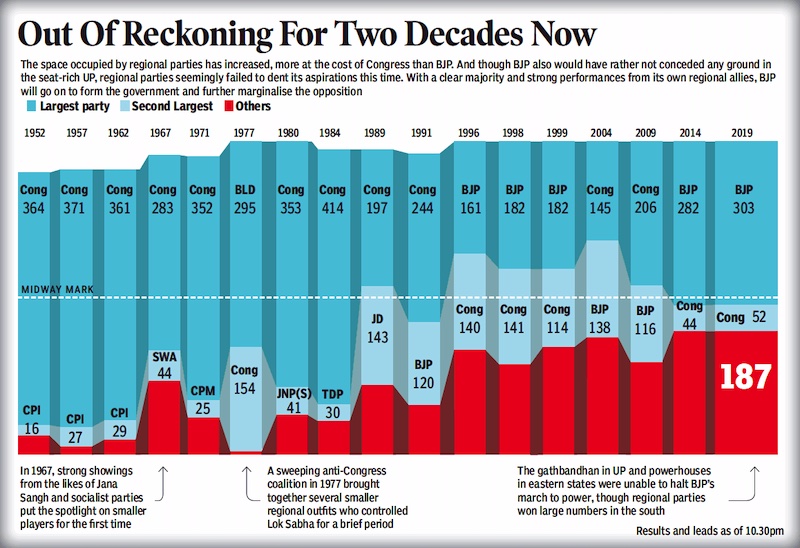
From: May 24, 2019: The Times of India
See graphic :
The biggest, 2nd biggest and other (including state) parties in the Lok Sabha, 1952-2019
Lok Sabha elections
Number of seats contested: 2014, 19
April 24, 2019: The Times of India
A first: BJP to contest more seats than Cong
New Delhi:
In what may be a watershed in Indian politics, BJP would for the first time be contesting more seats than Congress in the Lok Sabha elections.
The reversal of roles as the senior party comes after BJP in 2014 shot to a historic high in the LS tally while Congress slumped to an unprecedented low with mere 44 seats.
While for BJP, its highest list of candidates is a sign of its national growth, for Congress, its low tally is sign of pragmatism resulting in wide alliance-making.
This year, BJP has announced 437 candidates in LS polls. In contrast, Congress has named 423 only while there are a couple of more seats to be announced in Uttar Pradesh. It is unlikely that Congress tally can now surpass that of its arch rival.
To observers, these figures are historic since Congress was always a national party, its roots going back to pre-Independence, while BJP, mutating from its forerunner Bharatiya Jana Sangh, was for a long time with minimal national footprint.
Though BJP also came to power at the Centre in 1998 and 1999 under Atal Bihari Vajpayee, the 2014 contest marked an inflection point when Modi propelled it to a majority of its own with 282 seats. In contrast, Congress plummeted to 44 MPs.
It marked the point when BJP became a truly national party with pan-India presence while Congress came face to face with an existential crisis.
However, Congress contesting fewer seats than BJP is reflective of the grand old party learning from its crisis and stitching wide alliances to make up for its lost political muscle.
Says Praveen Chakravarty, who heads the AICC’s data analytics department, “BJP contesting more seats than Congress shows how contrary to perception, Congress has been far more successful in striking new alliances this time and the BJP has lost alliance partners since 2014.”
However, BJP spokesman GVL Narsimha Rao said BJP is many times bigger than Congress in terms of membership, electoral base and states under its rule. He said Congress was still contesting a disproportionately higher number of seats than its political strength which was reflective of its failure to stitch good alliances.
Congress’ Chakravarty argued that there is an inverse relationship between the number of seats national parties contest and their strike rate in elections. “BJP contested its least number of seats, 339, in 1999 elections and it won 182. Congress contested its highest tally since 1996, in 2014, and what was the result (44 MPs),” he said.
In 2014, BJP contested 428 seats to Congress’ 464; in 2009, BJP contested 433 to 440; in 2004, BJP contested 364 to Congress’ 414.
Lok Sabha results
1951-2014
March 11, 2019: The Times of India
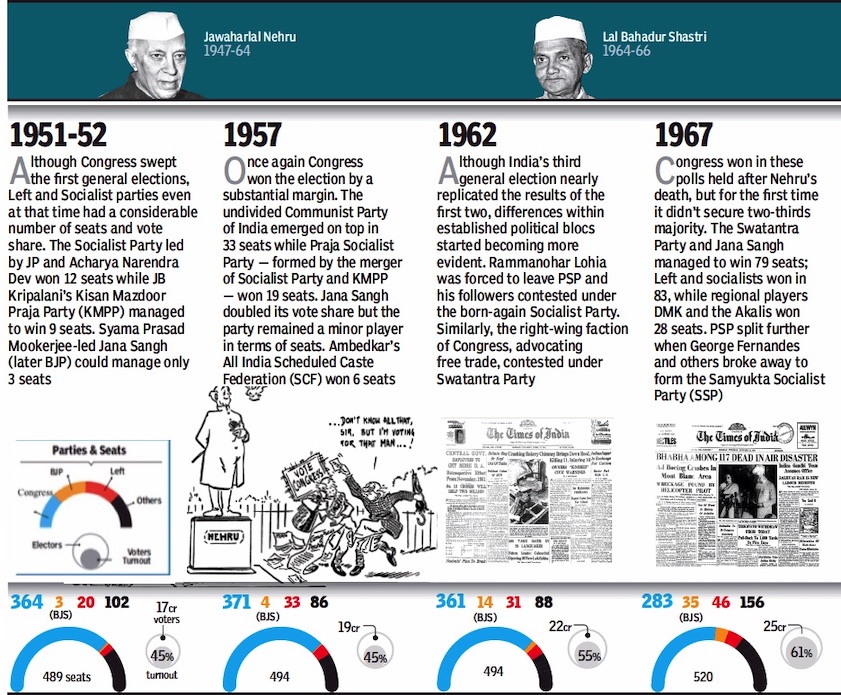
From: Mach 11, 2019: The Times of India
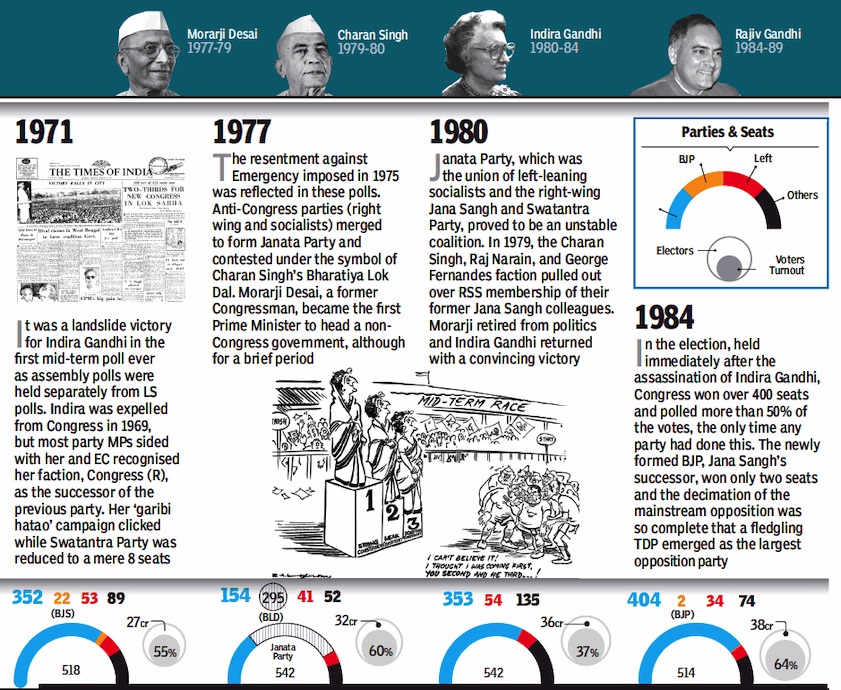
From: Mach 11, 2019: The Times of India
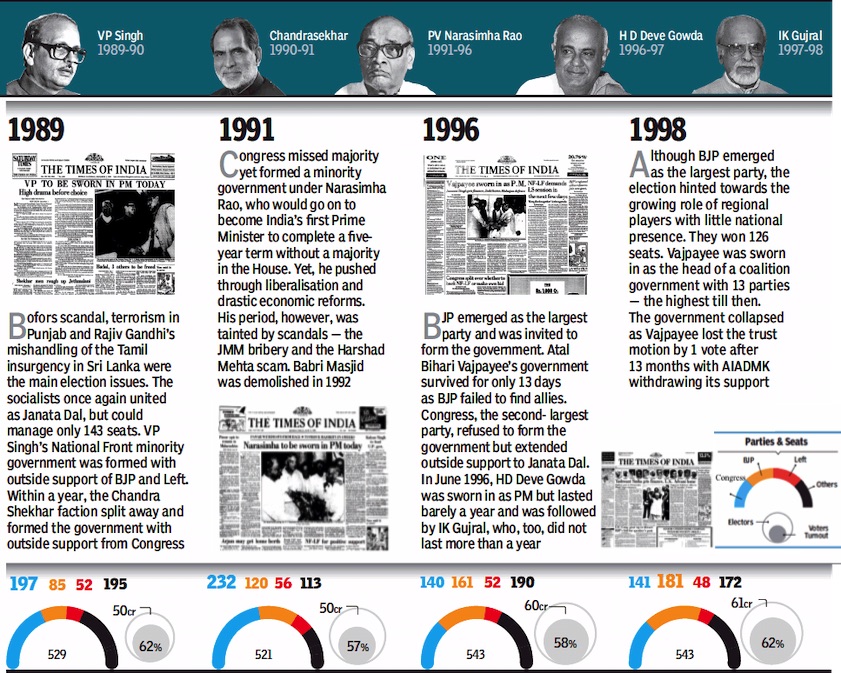
From: Mach 11, 2019: The Times of India
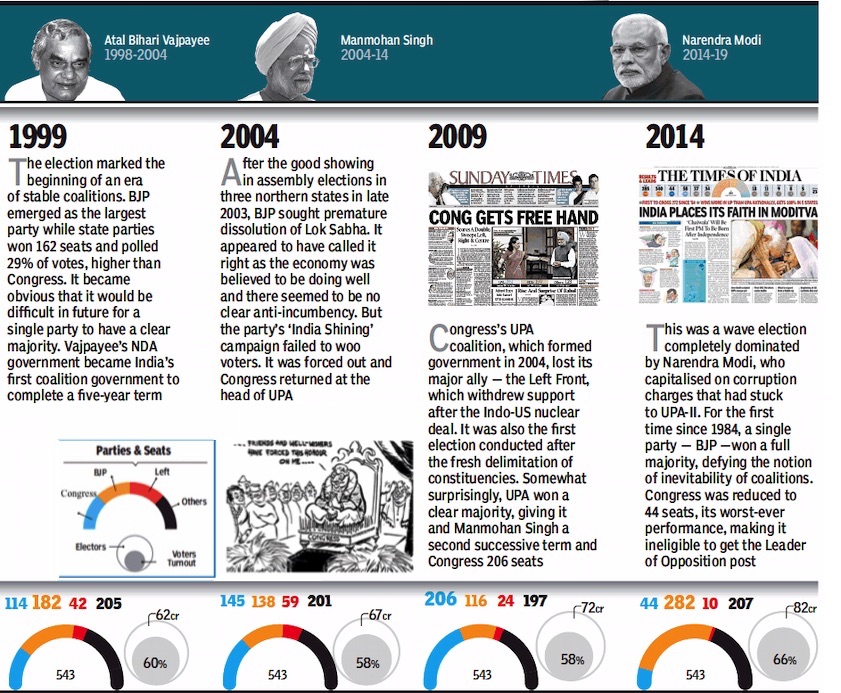
From: Mach 11, 2019: The Times of India
See graphics:
Seats won and voters turnout by different political parties in 1951-67
Seats won and voters turnout by different political parties in 1971-84
Seats won and voters turnout by different political parties in 1989-98
Seats won and voters turnout by different political parties in 1999-2014
From the era of Congress dominance in the first two decades after Independence, to the first non-Congress government in New Delhi post-Emergency, to the Rajiv Gandhi years with his party’s brute majority in Parliament, and finally to the era of coalition governments that has now lasted close to two decades, TOI takes you through Indian democracy’s roller coaster ride over the years...
1951-52

From: March 11, 2019: The Times of India
Although Congress swept the first general elections, Left and Socialist parties even at that time had a considerable number of seats and vote share. The Socialist Party led by JP and Acharya Narendra Dev won 12 seats while JB Kripalani’s Kisan Mazdoor Praja Party (KMPP) managed to win 9 seats. Syama Prasad Mookerjee-led Jana Sangh (later BJP) could manage only 3 seats.
1957
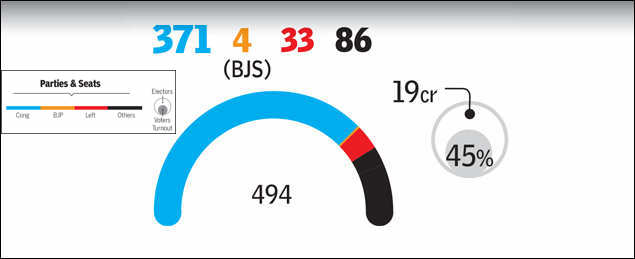
From: March 11, 2019: The Times of India
Once again Congress won the election by a substantial margin. The undivided Communist Party of India emerged on top in 33 seats while Praja Socialist Party — formed by the merger of Socialist Party and KMPP — won 19 seats. Jana Sangh doubled its vote share but the party remained a minor player in terms of seats. Ambedkar’s All India Scheduled Caste Federation (SCF) won 6 seats.
1962
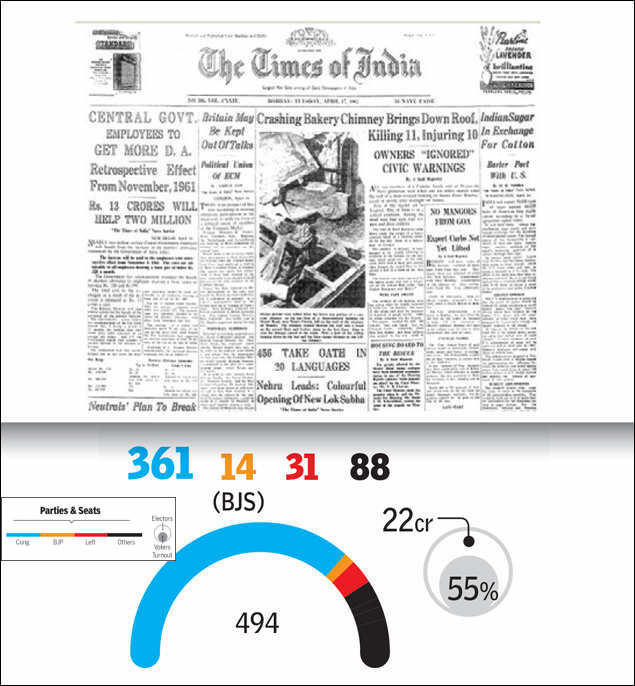
From: March 11, 2019: The Times of India
Although India’s third general election nearly replicated the results of the first two, differences within established political blocs started becoming more evident. Rammanohar Lohia was forced to leave PSP and his followers contested under the born-again Socialist Party. Similarly, the right-wing faction of Congress, advocating free trade, contested under Swatantra Party.
1967
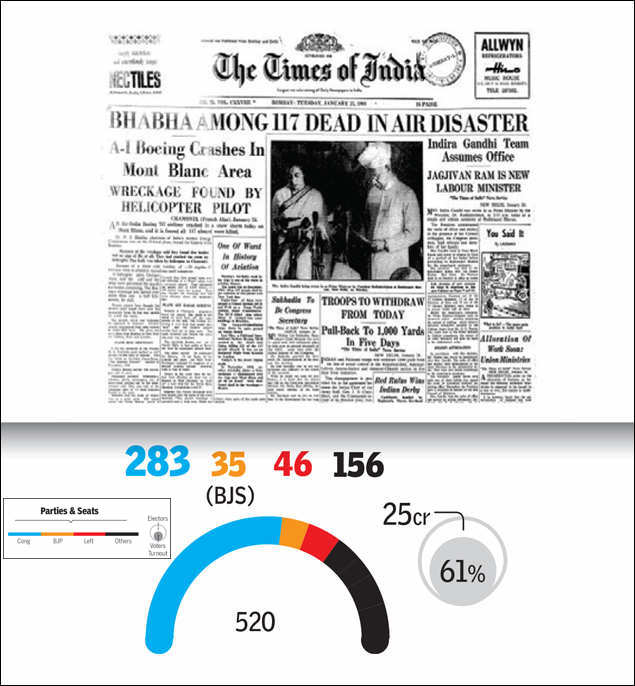
From: March 11, 2019: The Times of India
Congress won in these polls held after Nehru’s death, but for the first time it didn’t secure two-thirds majority. The Swatantra Party and Jana Sangh managed to win 79 seats; Left and socialists won in 83, while regional players DMK and the Akalis won 28 seats. PSP split further when George Fernandes and others broke away to form the Samyukta Socialist Party (SSP).
1971

From: March 11, 2019: The Times of India
It was a landslide victory for Indira Gandhi in the first mid-term poll ever as assembly polls were held separately from LS polls. Indira was expelled from Congress in 1969, but most party MPs sided with her and EC recognised her faction, Congress (R), as the successor of the previous party. Her ‘garibi hatao’ campaign clicked while Swatantra Party was reduced to a mere 8 seats.
1977
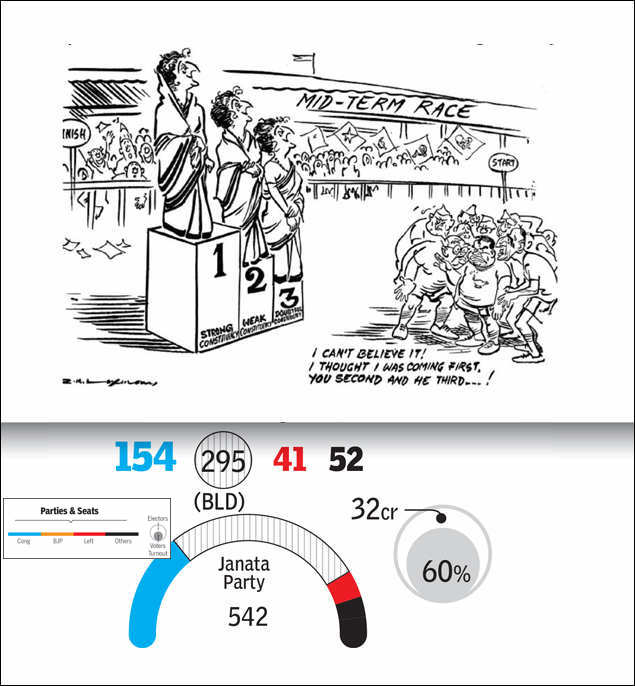
From: March 11, 2019: The Times of India
The resentment against Emergency imposed in 1975 was reflected in these polls. Anti-Congress parties (right wing and socialists) merged to form Janata Party and contested under the symbol of Charan Singh’s Bharatiya Lok Dal. Morarji Desai, a former Congressman, became the first prime minister to head a nonCongress government, although for a brief period.
1980

From: March 11, 2019: The Times of India
Janata Party, which was the union of left leaning socialists and the right-wing Jana Sangh and Swatantra Party, proved to be an unstable coalition. In 1979, the Charan Singh, Raj Narain, and George Fernandes faction pulled out over R S S membership of their former Jana Sangh colleagues. Morarji retired from politics and Indira Gandhi returned with a convincing victory.
1984
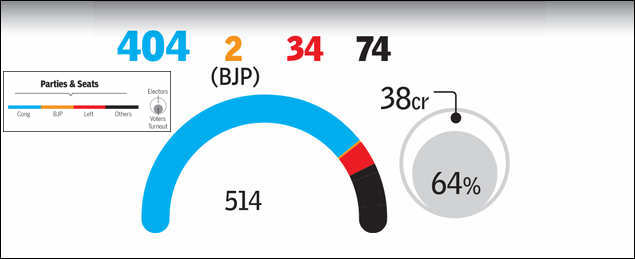
From: March 11, 2019: The Times of India
In the election, held immediately after the assassination of Indira Gandhi, Congress won over 400 seats and polled more than 50% of the votes, the only time any party had done this. The newly formed BJP, Jana Sangh’s successor, won only two seats and the decimation of the mainstream opposition was so complete that a fl edgling TDP emerged as the largest opposition party.
1989
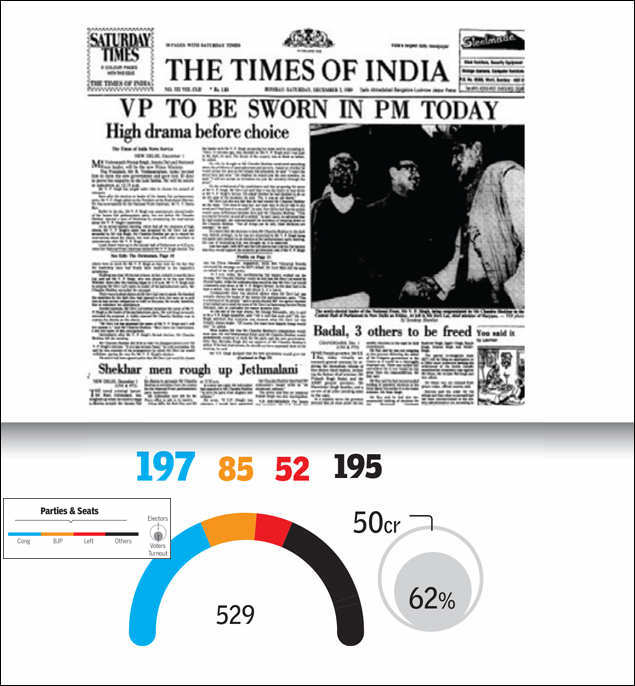
From: March 11, 2019: The Times of India
Bofors scandal, terrorism in Punjab and Rajiv Gandhi’s mishandling of the Tamil insurgency in Sri Lanka were the main election issues. The socialists once again united as Janata Dal, but could manage only 143 seats. VP Singh’s National Front minority government was formed with outside support of BJP and Left. Within a year, the Chandra Shekhar faction split away and formed government with outside support from Cong.
1991
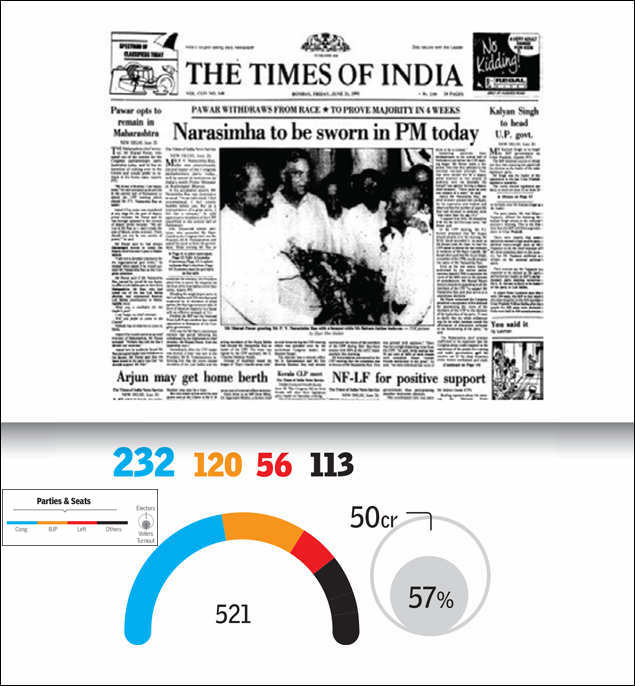
From: March 11, 2019: The Times of India
Congress missed majority and formed a minority government under Narasimha Rao, who would go on to become India’s first prime minister to complete a five-year term without a majority in the House. Yet, he pushed through liberalisation and drastic economic reforms. His period, however, was tainted by scandals — the JMM bribery and the Harshad Mehta scam. Babri Masjid was demolished in 1992.
1996
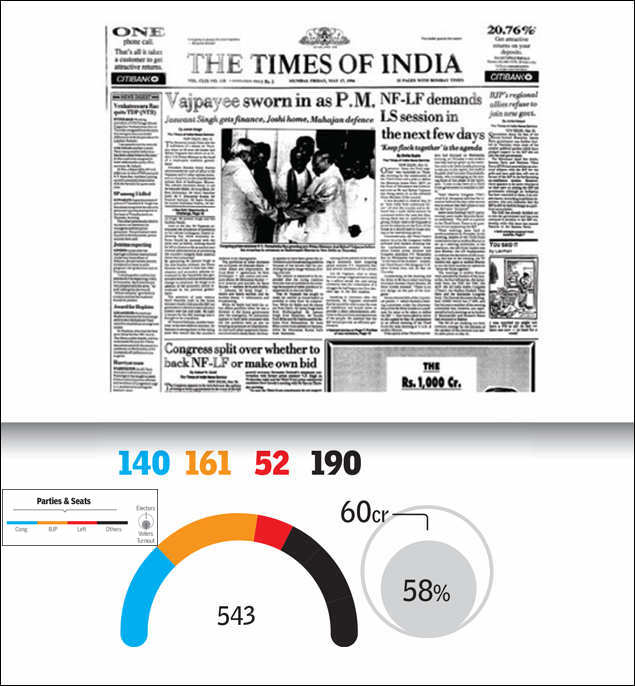
From: March 11, 2019: The Times of India
BJP emerged as the largest party and was invited to form the government. Atal Bihari Vajpayee’s government survived for only 13 days as BJP failed to find allies. Congress, the second- largest party, refused to form the government but extended outside support to Janata Dal. In June 1996, HD Deve Gowda was sworn in as PM but lasted barely a year and was followed by IK Gujral, who, too, did not last more than a year.
1998

From: March 11, 2019: The Times of India
Although BJP emerged as the largest party, the election hinted towards the growing role of regional players with little national presence. They won 126 seats. Vajpayee was sworn in as the head of a coalition government with 13 parties — the highest till then. The government collapsed as Vajpayee lost the trust motion by 1 vote after 13 months with AIADMK withdrawing its support.
1999
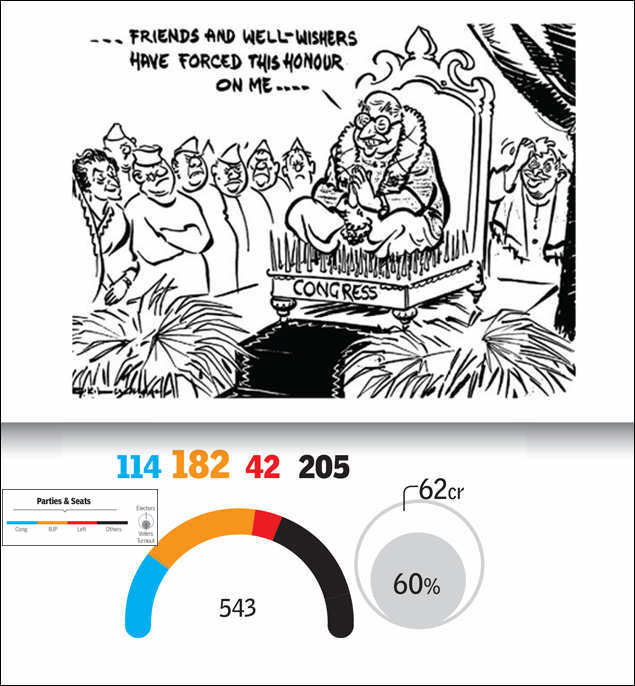
From: March 11, 2019: The Times of India
The election marked the beginning of an era of stable coalitions. BJP emerged as the largest party while state parties won 162 seats and polled 29% of votes, higher than Congress. It became obvious that it would be difficult, in future for a single party to have a clear majority. Vajpayee’s NDA government became India’s first coalition government to complete a five-year term.
2004
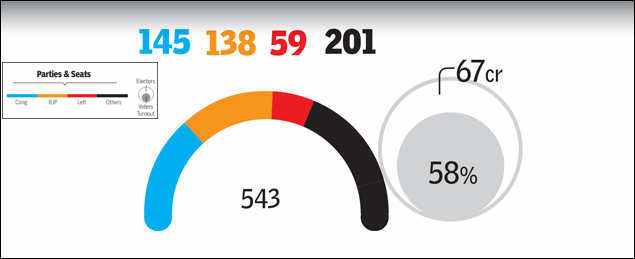
From: March 11, 2019: The Times of India
After the good showing in assembly elections in three northern states in late 2003, BJP sought premature dissolution of Lok Sabha. It appeared to have called it right as the economy was believed to be doing well and there seemed to be no clear anti-incumbency. But the party’s ‘India Shining’ campaign failed to woo voters. It was forced out and Congress returned at the head of UPA.
2009
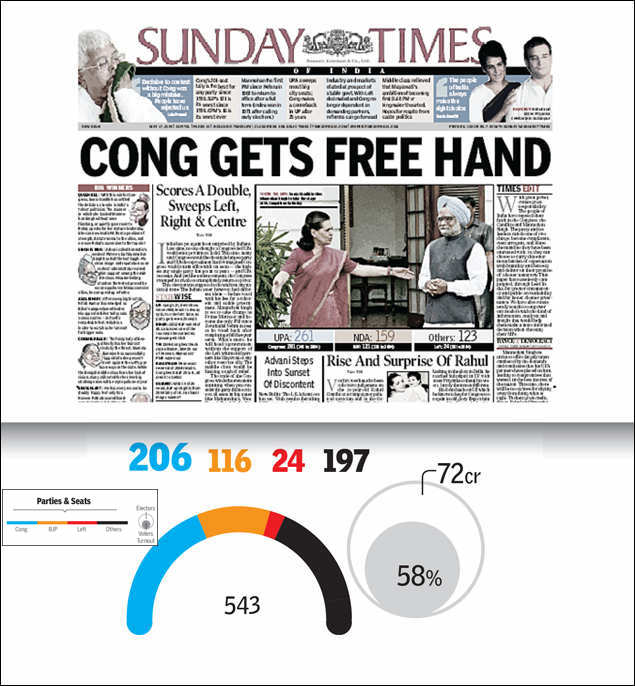
From: March 11, 2019: The Times of India
Congress’s UPA coalition, which formed government in 2004, lost it’s major ally — the Left Front, which withdrew support after the Indo-US nuclear deal. It was also the first election conducted after the fresh delimitation of constituencies. Somewhat surprisingly, UPA won a clear majority, giving it and Manmohan Singh a second successive term and Congress 206 seats.
2014

From: March 11, 2019: The Times of India
This was a wave election completely dominated by Narendra Modi, who capitalised on corruption charges that had stuck to UPA-II. For the first time since 1984, a single party — BJP —won a full majority, defying the notion of inevitability of coalitions. Congress was reduced to 44 seats, its worst-ever performance, making it ineligible to get the Leader of Opposition post.
2014
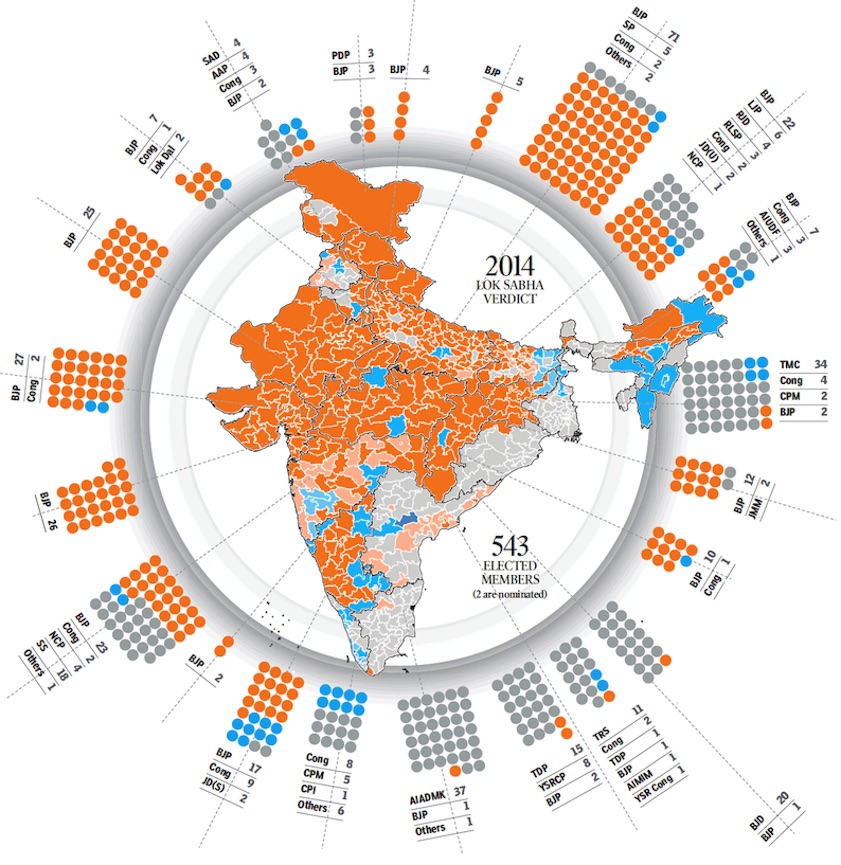
From: March 11, 2019: The Times of India
See graphic
The results of the Lok Sabha elections, 2014.
Muslims
1952-2014
AFROZ ALAM, Political sidelining of Muslims holds ominous signs, May 24, 2019: The Times of India
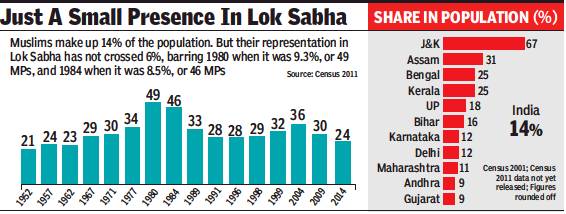
From: AFROZ ALAM, Political sidelining of Muslims holds ominous signs, May 24, 2019: The Times of India
Are Indian Muslims confronting the void? Political parties are no longer engaging with Muslims like they used to. This process of withdrawal and fracturing began with the 2014 Lok Sabha elections and carries on in 2019.
Globally, the pathologisation of Muslims began after 9/11, which entrenched Islamophobia, and moved the discourse around minorities entirely towards terror, the ‘enemy within’, and ghettoisation. The growing majoritarian impulse in Indian democracy has both facilitated this process, and been a symptom of it: sidelining the political and economic interests of the community. Can India afford to cut off its largest minority from the wider political society? Can it achieve sustainable growth this way? Absolutely not.
At a little over 14%, India has the third-largest Muslim population in the world. There are 85 Lok Sabha seats and 720 assembly seats where Muslims constitute more than 20%. Muslim electorates are well positioned to change fortunes in many constituencies, with a slight swing in their voting preference. Muslim voting patterns are not monolithic, uniform or communal. But by and large, they vote for parties and candidates that do not treat them as the ‘other’, that stand with them, and do not doubt their qualifications for citizenship. And yet, Muslims have lost considerable political space since 2014 (see graphic). State legislative assemblies are no different.For example, in assembly elections held between 2013-2015, Muslim representation declined from 35% to 20%. In 2018, only 1 Muslim candidate won in Chhattisgarh, 2 in Madhya Pradesh, 8 in Rajasthan and 8 in Telangana.
This under-representation of Muslims stems from the growing reluctance of mainstream parties to give them tickets. For instance, in 2009, one Muslim candidate won out of the four fielded by the BJP. In 2014, the BJP fielded 7 Muslim candidates but none won. This year, it had a mere 7 Muslim candidates out of 437. In 2009, Congress fielded 29 Muslim candidates of whom only 10 won. In 2014, only 7 of the 31Congress Muslim candidates won. In 2019, there were 32 Muslim candidates among its 464 candidates . Interestingly, regional parties who bank on minority votes exhibit a similar pattern of denial. For instance, there were only 10 Muslims among the 78 candidates declared by the gathbandhan in UP: BSP six and SP four. This is unlike previous elections —BSP had 14 and 19 Muslim candidates in 2009 and 2014, while SP gave tickets to 11 and 14 Muslims. In Bihar, RJD fielded four, JDU and LJP one each this time. Meanwhile, TRS, TDP and YSR Congress, JDS, and BJD did not field a single Muslim candidate in Telangana, AP, Karnataka and Odisha.
This denial of candidacy is a denial of equal opportunity, of the right to take part in policy, law and decisionmaking bodies as citizens. This disenfranchisement will deepen the disillusionment among Muslims and also threaten the fair working of our constitutional and democratic institutions.
There is no doubt that this indifference towards Muslims has been caused by the triumph of Hindu right-wing populism. The so-called minority-friendly parties have reoriented themselves, sidelining potential Muslim candidates in the name of ‘winnability’, given the compulsions of ‘polarisation’. But were polarisation and winnability not factors before 2014? There are several reasons for this slide. First, the civil-society wing of secular parties weakened over the years, which gradually reduced the possibility of inter-community dialogue and harmony, while that of right-wing parties became hyperactive. Second, parties are failing to recruit Muslims and train them as consensus secular leaders. Third, these parties, and Muslim elites, are more focused on acquiring power through the threat to ‘Muslim identity’ rather than on economic opportunity and equity. Fourth, the community has failed to produce consensus leaders from civic movements.
No matter what form the new government takes, Muslims will remain stuck in the vicious cycle of institutionalised ‘othering’, under-representation and under-development unless they start rejecting the tactical symbolism of their chosen parties, and participate in civil society movements as confident citizens.
If the politics of Muslims does not express itself within the framework of citizenship, rather than the state of being a minority, then their circumstances will be shaped by momentary emotions and physical violence—irrespective of the number of their MPs and MLAs.
The writer teaches political science at Maulana Azad National Urdu University
Muslim- Scheduled Caste joint fronts
Maharashtra: 1984, 2012
Efforts by Congress and NCP to bring together disparate outfits in Maharashtra under the banner of a united opposition have been undermined primarily by one man: Prakash Ambedkar. Reaching out to Asaduddin Owaisi’s Majlise-Ittahadul Muslimeen early on and renewing the Dalit-Muslim axis, he has set the stage for a three-cornered contest in the state.
The Dalit-Muslim bonhomie in Maharashtra goes back over three decades. In the aftermath of the 1984 Bhiwandi riots, smuggling kingpin Haji Mastan Mirza and Dalit leader Jogendra Kawade made ripples by forming the Dalit Muslim Minority Suraksha Mahasangh. An ageing Mastan was looking to step out of the shadow of the Bombay underworld, which was overrun by the Pathans and mill-land Maharashtrian gangs.
“It was a novel experience in the country’s political history. I was known for launching a march to rename Marathwada university in Aurangabad after Babasaheb Ambedkar while Mirza had given up smuggling, performed Haj and wanted an image makeover,” recalled Kawade, 75, who is now president of People’s Republican Party of India. “I became founder president while he was co-founder of the Mahasangh.”
Disenchanted with Congress and wary of Shiv Sena’s increasingly communal rhetoric, some Muslims saw Mastan as a reformed don who could offer insurance against Bal Thackeray’s majoritarian threats. “Some of us wanted to project him as a Muslim Thackeray. We thought he could respond to Shiv Sena in their language,” said senior journalist Sarfraz Arzoo, who was among those who persuaded him to float the Mahasangh. “It was galvanising Muslims and Dalits and seemed an alternative to Congress.”
The Mahasangh aimed for a vote bank of Muslims and Dalits concentrated in pockets of Mumbai and its suburbs, to start with. Both communities had substantial numbers in Dongri, Nagpada, Byculla, Dharavi and Sion with no legislative representation. Dalits make up 7% of the state’s population and Muslims account for 11%, much of it in urban areas. Neither had a strong voice in the Marathadominated Congress or in the Left,
which anyway shunned all talk of caste or community.
But the Mahasangh faltered when the Congress-versus-Sena debate took a divisive turn and the minorities chose to consolidate behind the ruling party. Kawade said the Dalit-Muslim experiment collapsed after Mastan’s death in 1994. Arzoo said Mastan himself capitulated to pressure from a Congress politician when his properties went into litigation. “The Mahasangh died as we couldn’t find a Muslim leader like Haji Mastan,” said Kawade.
The project saw a brief resurrection when former cop Shamsher Khan Pathan along with Dalit leader Baban Kamble launched the Awami Vikash Party on May 1, 2012. “I launched it because I wanted to empower Muslims. But now I feel the community has no political awareness and is destined to remain slaves of parties which use them as vote banks,” said a bitter Pathan. He is now being approached to be a spokesperson for the Indian Democratic Alliance and Rashtriya Bahujan Aghadi, another alliance of Muslims and Dalits. Electorally though, the best shot may lie with Ambedkar’s Vanchit Bahujan Aghadi. With Owaisi backing him, he could upset equations for the two mainstream alliances in some seats.
“The Marathas got 10% reservation while the BJP government denied reservation to Muslims. Dalits and Muslims don’t find much space in Congress-NCP,” Owaisi told TOI. After the Koregaon Bhima incident, Ambedkar has emerged a credible Dalit voice while I have never shirked from championing the Muslim cause. We had to come together,” said Owaisi. “The arrogance of Congress and NCP will backfire and Sena-BJP will certainly benefit from any split in secular votes.”
Petrol pumps
2017: they enter politics
March 13, 2019: The Times of India
Posters of politics: Photographs of Prime Minister Narendra Modi on hoardings at petrol pumps have been creating controversy before elections in the last couple of years. In January 2017, when the model code of conduct was in place before elections to five states, Congress had petitioned the Election Commission for the removal of PM Modi’s posters at petrol pumps. “This is not permissible under Model Code of Conduct and Election Commission instructions," the commission had then said and asked the cabinet secretary to ensure compliance.
New election, more pumps: This year too, many petrol pumps display huge billboards advertising government schemes in violation of the model code of conduct that came into effect on Sunday. State-run oil companies operate around 57,000 fuel pumps across the country. Late last year, the Centre allowed the expansion of their retail operations by opening close to 56,000 more pumps. The allotments have already begun.
Pumps and ads: In 2018, oil and gas PSUs started 'aggressive campaigns' to publicise the government's flagship schemes. Indian Oil, India's largest petroleum retailer, had issued a Rs 293 crore tender for outdoor publicity for Pradhan Mantri Ujjwala Yojana.
Ads and politics: A consortium representing dealers operating petrol pumps had alleged last year that dealers had received 'verbal advisory' from oil companies to put up posters of PM Modi at their retail outlets ahead of 2019 elections. The president of the consortium was quoted as saying, “those who refuse are threatened with blocking of supplies”.
Meanwhile, several government websites, including that of the Prime Minister's Office, have taken down pictures of the prime minister and other union ministers following the imposition of the model code of conduct. Some ministries, however, are yet to comply. The code states that the party in power should not use its official position for campaigning.
Raths (chariots)
1982-2016
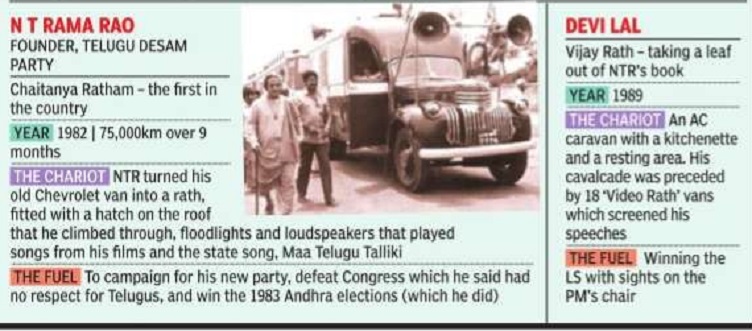
The Times of India

The Times of India
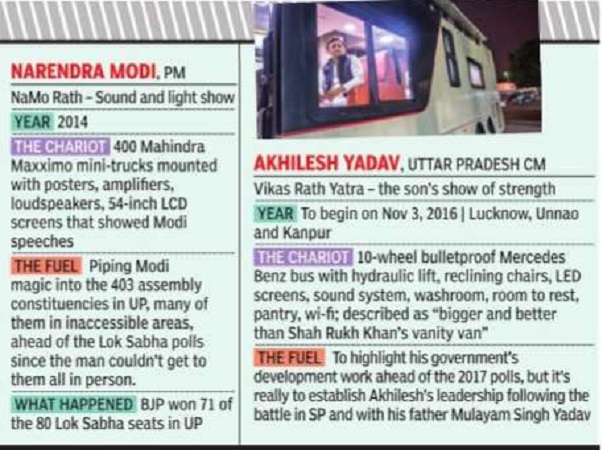
The Times of India
See graphics on this page and on the page Samajwadi Party
Reserved seats
1989-2014: BJP defeated Congress across the country
Chethan Kumar, April 6, 2020: The Times of India
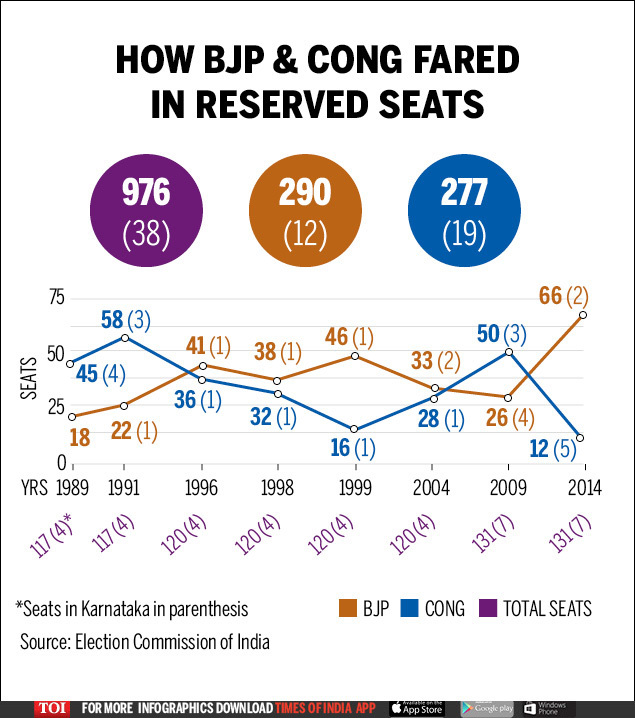
From: Chethan Kumar, April 6, 2020: The Times of India
Lok Sabha elections: In reserved seats, BJP beats Congress across the country BENGALURU: An analysis of data from the Election Commission reveals that the BJP has won more reserved seats — for scheduled castes and scheduled tribes in eight elections from 1989 — than the Congress which has been traditionally been associated with these communities.
The Election Commission data shows that of the 976 MPs elected from reserved constituencies across the country between 1989 and 2014, 30% are from the BJP compared to 28% of the Congress. Analysts and psephologists TOI spoke with attribute this to a reduction in upper caste votes for the Congress, which are said to play a major role in reserved constituencies.
"If you look at the constitution of such segments, you will find that the SC and ST population is not more than 40% to 45% on average," said political analyst S Mahadevaprakash. "So other votes do matter here and is just as crucial as the consolidation of minority votes in general segments."
It is widely accepted that Congress' popularity began to slide from 1989, a year which is seen as key to the BJP's performance. It is from this year when the grand old party steadily began losing its hold on upper caste votes.
Ashis Nandy, political psychologist, told TOI: "The SC and ST community, unlike upper caste voters, are not united and there is a lot of fragmentation. Typically in a reserved constituency, there are many SC or ST candidates. This means the votes are split and the party that is able to consolidate other votes wins the seat."
Of the eight elections, the BJP won more reserved seats in five — 1996, 1998, 1999, 2004 and 2014. The last election saw the saffron party bag the highest number of reserved seats — 66 — by a single party.
However, Karnataka bucks the trend. The Congress has won 50% of the 38 seats, compared to BJP's 31.6%. Barring 2004 and 2009 when the Congress-led UPA for med the gover nment at the Centre, the BJP either secured fewer reserved seats than Congress or the same number of seats.
Notwithstanding BJP's growing stature in the state, Congress has managed to keep most of the reserved seats, thanks to its legacy and consecutive governments' pro-SC/ST stand.
Political analyst Harish Ramaswamy explains: "Karnataka has traditionally been good to the SC and ST population. Successive governments have implemented some good programmes. Since the Congress has been at the helm in most of these years, the party's candidates have managed to retain popularity in such constituencies. And, given the fact that the BJP is yet to completely establish itself, it means that the Congress still manages to attract some Lingayat and Brahmin votes.”
South India
2019: the new UP of Indian politics
January 28, 2019: The Times of India
PM Narendra Modi's visit to the southern states of Tamil Nadu + and Kerala on Sunday to address public gatherings and launch new projects could possibly be the BJP's alternative route to sitting on the treasury benches in the 17th Lok Sabha after May 26 - and there are reasons why the party is feeling bullish rather than bluish over its electoral prospects down south.
It used to be said in Indian parliamentary politics that the party which captures a majority of the 80 Lok Sabha seats in Uttar Pradesh (UP) gets to rule at the Centre - the southern states might just provide that extra heft for the BJP which has faced a drubbing in the recent assembly polls in the Hindi heartland states of Madhya Pradesh and Rajasthan, along with losing Chhattisgarh.
What's on offer: In total, the five states and one UT (Puducherry) in South India - Andhra Pradesh, Karnataka, Kerala, Tamil Nadu and Telangana - offer 130 seats and except for Karnataka, where the BJP has 17 Lok Sabha seats out of 28, it's a non-entity or thereabouts in all other states. It has just two seats - in alliance - in Tamil Nadu, in Kerala, where it was his second visit in less than 2 weeks and just 1 seat in Telangana, a leftover after its alliance partner TDP walked out of the NDA and 2 seats in Andhra Pradesh.
Options open: PM Modi, even while addressing a rally in Madurai where he laid the foundation stone for an AIIMS, refrained from criticising any of the regional parties - reserving his ire only for the Congress and the Communists with indications that the saffron party is considering an alliance with the ruling AIADMK, which won 37 of the 39 Lok Sabha seats in 2014. In fact, earlier this year, Modi himself didn't rule out the possibility of allying with the AIADMK. Then of course there's the X-factor, in the form of Rajnikanth, the Tamil superstar whose admiration of Modi is no secret.
The Hindutva factor: The Supreme Court verdict on Sabrimala + - allowing women in the 10-50 age group entry to the Lord Ayyappa Temple - has come as a blessing for the BJP and its core constituency as the decision consolidated the staunch Hindus against the Kerala government of the communists who insisted of implementing the SC order, angering a majority of the Hindus. In fact, at his rally in Thrissur, Kerala, Modi pounced upon the opportunity to accuse the state government of being insensitive to the people's cultural beliefs - a hint at the Sabarimala controversy. He also accused the UDF government of framing former ISRO scientist Nambi Narayanan for spying - the scientist, who was acquitted of all charges by the SC, was conferred the Padma Bhushan this year.
State parties, state leaders
1951-2019

From: May 24, 2019: The Times of India
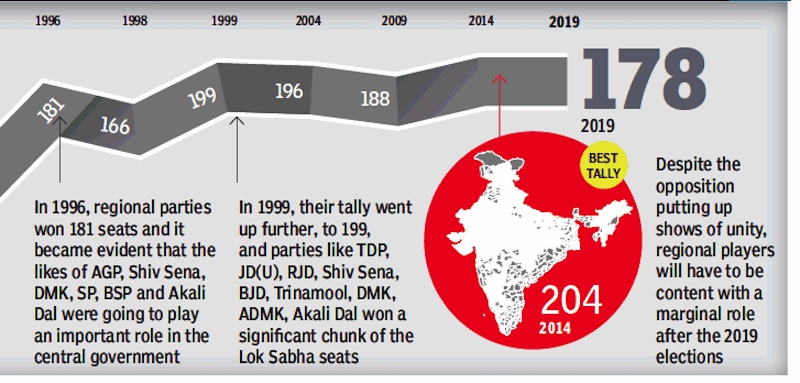
From: May 24, 2019: The Times of India
See graphics:
The state/ regional parties’ electoral performance in the Lok Sabha, 1951-1991
The state/ regional parties’ electoral performance in the Lok Sabha, 1996-2019
1999-2019
Mohua Chatterjee, May 24, 2019: The Times of India
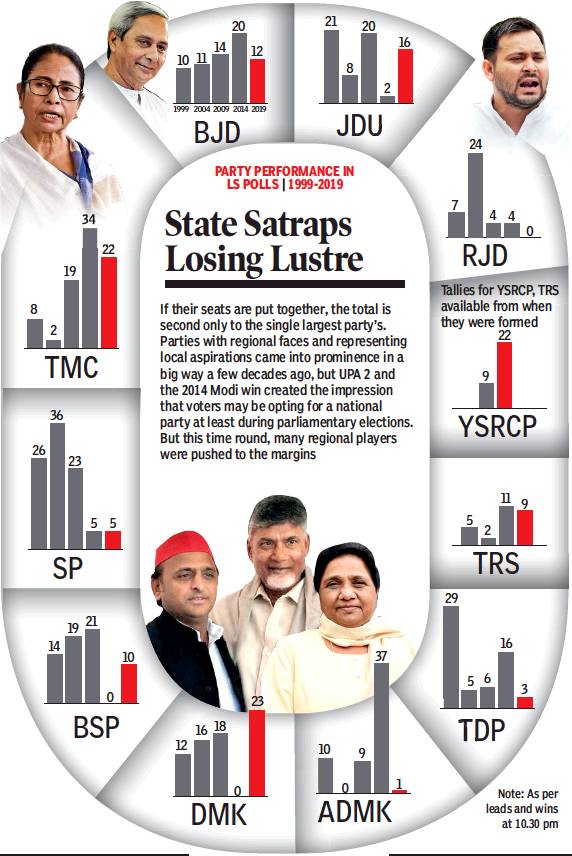
From: Mohua Chatterjee, May 24, 2019: The Times of India
If Congress faced the brunt of the Modi wave in 2014, regional parties Trinamool Congress and Telugu Desam Party faced the storm in 2019, uprooting their plans to be the fulcrum of a coalition at the Centre that could replace the BJP-led NDA.
TDP chief N Chandrababu Naidu, who undertook a tour of state capitals to sew up cooperation among regional parties and Congress, suffered a serious meltdown on home turf, with the rival Jagan Mohan Reddy-led YSR Congress wiping the slate in parliamentary and assembly elections. The shock defeat, after exit polls had offered conflicting projections, was a jolt that pulled the rug from under Naidu’s plans.
Trinamool leader Mamata Banerjee, another seasoned player, also seems to have misread the reality in her state where the Modi phenomenon worked on the ground, posing the most serious political challenge since she took charge as West Bengal chief minister in 2011.
The BJP threat could grow more potent in the run-up to the assembly elections in 2021, what with NDA now firmly ensconced in Delhi.
Other regional parties like DMK in Tamil Nadu, BJD in Odisha and TRS in Telangana held their ground despite NDA being a challenger, though with varying intensity. In Andhra, TDP was replaced by another regional player, YSR Congress, and BJP could not make a mark. These parties, however, made no attempt to align with any bloc and stuck to defending or — in the case of YSR Congress — gaining state turfs.
Both Banerjee and Naidu were calculating on BJP falling short of a majority and the possibility of a regional bloc calling the shots. The Trinamool leader, not keen on Congress leading a coalition, was looking to use a regional front to stall the national party. The political strategising was simply swamped by the saffron surge.
A reason for their efforts not bearing fruit was the calls for opposition unity not translating into effective alliances. Congress and the Left failed to tie up in West Bengal, Congress and Aam Aadmi Party fought separately in Delhi and Congress was on its own in Uttar Pradesh. Yet, with BJP’s vote-share crossing 50% in Delhi, being a shade under that in UP and crossing 40% in West Bengal, the party’s challenge took on new dimensions.
While Naidu faced anti-incumbency in Andhra Pradesh, there was no BJP to deal with. But in West Bengal, where Banerjee faced anti-incumbency, the Trinamool chief was seen as pushing the Left and Congress to a corner as a result of which supporters of both parties seem to have helped BJP gain ground.
2014>19: political handles
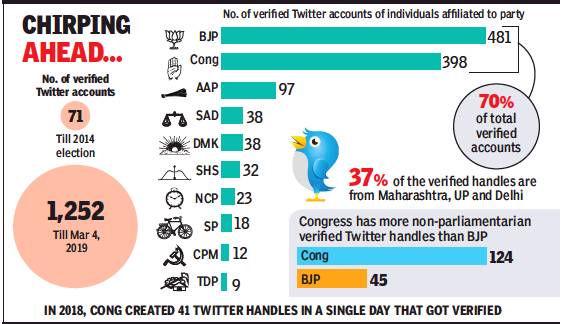
From: Mohammad Ibrar, Battleground Twitter: Verified political handles up 1,663% in 5 yrs, March 9, 2019: The Times of India
Social media is going to be an important weapon in the electoral battleground in 2019. This is clear from the rise in the number of verified political handles from 71 to 1,252 between 2014 and March this year, with 78% of these handles belonging to members of BJP, Congress and Aam Aadmi Party.
Research conducted by students and scholars at the Indraprastha Institute of Information Technology (IIIT), Delhi, and the International Institute of Information Technology, Hyderabad, also found that 37% of the verified handles originated in Maharashtra, Uttar Pradesh and Delhi, making them the hub of online realpolitik.
The research was initiated in IIIT-D in September 2018 by eight students and a principal researcher to assess the impact of social media on the 2019 general elections. “We analysed over 21 million posts by roughly a million handles since the 2014 Lok Sabha polls,” said Ponnurangam Kumaraguru, associate professor in both the institutions.
He added that he and his team then covered the data related to 2,585 Twitter handles that were affiliated to an Indian political party. “This list was manually curated and we have been collecting data for these handles from late 2018 through the Twitter Application Programming Interface,” Kumaraguru said.
He said that of the chosen handles, 1,252 political handles were found to be verified. “It is interesting to see such a large number of verified accounts for this year’s election,” the professor said. “In comparison, when we analysed the Twitter data for the 2014 elections, we found only 71 verified Indian political handles. This shows how big a jump there has been in the number of such handles.”
Kumaraguru said that the team also examined the handles for their state representation, party affiliation and Lok Sabha /Rajya Sabha affiliations. “We found that more than 70% of the verified accounts of BJP and Congress accounts put together. If AAP is included, the figure goes up to 78%,” he explained. “This indicates social media is important for the national parties. We are keen to analyse the data to study interesting patterns like diversity of topics and the manner in which the campaigns are carried out.”
Congress, which has lagged BJP on social media, picked up its game last year when its leaders created 35 new Twitter handles in a single day and which were later verified.
Women
Please see: Women in politics: India
YEAR-WISE TRENDS
1980: Zia, Deng made US believe Indira would be pro-Soviet
December 22, 2018: The Times of India
The US acceded to Pakistan’s demand to overlook its secretive nuclear weapons programme following the Soviet invasion of Afghanistan in the late 70s after Chinese leader Deng Xiaoping convinced Washington to support Islamabad for the “stability” in South Asia, according to latest declassified State Department documents.
The documents reveal that the then Pakistani dictator General Zia-ul Haq and Chinese Vice Premier Deng Xiaoping were successful in extracting this price from the US in lieu of Islamabad’s support to America against the Soviet invasion of Afghanistan.
In addition to the US turning a blind eye to Pakistan’s nuclear weapons programme, Deng also convinced the US to start giving more military and financial aid to Pakistan, according to the US Foreign Relations 1977-1980 volume on Afghanistan.
The voluminous document indicates that both Zia and Deng successfully convinced the then Jimmy Carter administration that India under Prime Minister Indira Gandhi would be pro-Soviet.
“There are limits on our ability to aid Pakistan because of their nuclear explosive programme. Although we still object to their doing so, we will now set that aside for the time being, to facilitate strengthening Pakistan against potential Soviet action,” the then US Defence Secretary Harold Brown said in a January 8, 1980 meeting with Deng.
“...India is not a stabilising factor. Perhaps you already know the general election results,” Deng said. He was referring to the then just-concluded parliamentary elections in which Indira Gandhi came back to power with a majority. Observing that Gandhi had got 70% of the vote, Deng said it was very difficult to judge that time how India will go.
1997
`Cong pulled down Gujral govt as Kesri wanted to be PM'
`Cong pulled down Gujral govt as Kesri wanted to be PM', Oct 15 2017: The Times of India
Sitaram Tried To Exploit Anti-BJP Sentiment, Writes Pranab
The Congress under the late Sitaram Kesri pulled down I K Gujral's United Front government in 1997 for his refusal to drop the DMK from his cabinet because of Kesri's personal ambition to become Prime Minister, former President Pranab Mukherjee suggests in his latest book.
“So why did the Congress withdraw support? What did Kesri mean by his oft repeated comment `Mere paas waqt nahi hai' (I have no time)? Many Congress leaders interpreted as his ambition to become Prime Minister. “He tried to exploit the rarching anti-BJP senti overarching anti-BJP sentiment while simultaneously undermining the United Front Government with the aim of thrusting himself as the head of a non-BJP government,“ Mukherjee says in his latest of the trilogy `The Coalition Years: 1996-2012'. The first two volumes of his autobiography dealt with the Indira Gandhi era and the turbulent decade post-Indira.
The demand for withdrawal of sup port to the I K Gujral government under the United Front came after the pre liminary report of the Jain Commission -set up to investigate Rajiv Gandhi's assassination in Sriperumbudur in May 1991by the LTTE -gave its report in August 1997. The interim report of the Commission suggested that the DMK and its leadership had been involved in encouraging LTTE leader V . Prabhakaran and his followers. While the report did not refer to any particular leader or involvement of any political party, it was a problematic situation for the UF government in which the DMK was a constituent.The Congress was supporting the government from outside.
Mukherjee recalls that the Winter Session of Parliament in 1997 witnessed hectic parleys in an attempt to de fuse the crisis. Congress leaders including Kesri, Jitendra Prasada, Arjun Singh, Sharad Pawar and Mukherjee were invited by Gujral for dinner at his official residence. The Prime Minister said there was no direct evidence of the involvement of any particular leader of the DMK, let alone any minister.
Gujral went on to say that in such a situation, it would send a wrong message if he were to take action against the DMK.The government would be seen as succumbing to the pressure of a supporting party and its capacity to govern would become extremely limited.
“Gujral was firm in his view that the credibility of the government could not be undermined. We told him we would like to take the issue and his point of view to the Congress Working Committee which would finally take a decision,“ Mukherjee writes.
2014
BJP did not expect to win, so it made tall (false) promises: Gadkari
Gadkari reveals why Modi vowed to put ₹15 lakh in your a/c, October 10, 2018: The Times of India
Senior BJP member and Union minister for road and surface transport Nitin Gadkari’s comments on a television show aired recently may cause the ruling party much embarrassment, giving ammunition to the opposition to target it for having made “tall promises”.
“We were very confident that we would never come to power, so we were advised to make tall promises,” said Gadkari during the show. “Now that we are in power, the public reminds us of those promises made by us. However, these days, we just laugh and move on.”
The interview was aired on a Marathi channel a few days ago.
Gadkari appears to say on the show that BJP won the polls on the basis of unrealistic promises.
2016: Highlights of the year
The Times of India, January 1, 2017
1. India-China relationship: Relations between India and China in 2016 continued to be complicated. China's protection for Pakistan-based Jaish-e-Muhammad chief Masood Azhar, its opposition to India's membership of the Nuclear Suppliers Group, its plans to construct dams on upper reaches of the Brahmaputra, and territorial disputes at the Line of Actual Control are among the contentious issues that strain the China-India relationship.
Former Tata Group chairman Cyrus Mistry's (right) ouster, and the ongoing feud between Mistry and interim Tata chairman Ratan Tata, are two other major events that occurred in 2016.
2. Demonetisation: Demonetisation, note ban, currency ban - whatever you wish to call it, this was easily the most significant event of 2016 in India. Prime Minister Narendra Modi told the nation on November 8 that the old Rs 500 and Rs 1,000 notes (picture) would be removed from circulation. The move created a cash crunch, which the government made efforts to ease - by releasing new Rs 500 and Rs 2,000 notes, and creating incentives for digital transactions. A 50-day window during which citizens could deposit old notes at banks ended on December 30.
3. Cashless economy: Ever since demonetisation was announced, the government has taken steps to promote digital transactions and a cashless economy. For example, it launched lucky draws with prizes for both consumers and businessmen who use cashless transactions, and doubled the balance limit of Prepaid Payment Instruments. The Finance Ministry announced eleven mesures to promote digital payments, including discounts on purchases of petrol and diesel. And finally, Prime Minister Modi launched a digital payments app, Bharat Interface for Money or BHIM, on December 30.
4. GST: In August, the Parliament passed the landmark Goods and Services Tax (GST) Bill, which aims to create a unified market by doing away with inter-state tax barriers. However, there's been an impasse in the GST Council (picture) over the division of authority between assessing authorities of centre and states, and the issue will be taken up together at the council's meeting on January 3-4, 2017.
5. Fast end by Iron Sharmila: In August, Manipuri human rights activist Irom Sharmila ended a 16 year fast that she'd begun to protest against the Armed Forces Special Powers Act. She later created her own political party - the People's Resurgence and Justice Alliance.
6. Death of J. Jayalalitha: Former Tamil Nadu Chief Minister and All India Anna Dravida Munntra Kazhagam supremo J Jayalalithaa, an icon of Dravidian politics, breathed her last on December 5. She was buried next to her mentor, former Tamil Nadu Chief Minister M G Ramachandran, who also starred in several films with her during her glittering Kollywood career. After Jayalalithaa's demise, her close friend and confidante Sasikala Natarajan (left) took over as general secretary of the AIADMK on December 31.
7. Terror in Kashmir valley: The Kashmir valley witnessed several months of unrest after Hizbul Mujahideen terrorist Burhan Wani was killed in an encounter with security forces on July 8. The unrest affected normal life, and resulted in shutdown of schools and death of 86 people. The government had also to grapple with the NIT unrest, mysterious school burning incidents and blinding due to pellet gun firing issues.
8. Legion: Legion, a group of hackers, was in the news for compromising e-mail and Twitter accounts of Congress vice-president Rahul Gandhi (picture), liquor baron Vijay Mallya, and two prominent senior journalists. A member of the group shared with TOI a list of what he claimed are email addresses and passwords of nearly 74,000 chartered accountants in the country. He said he had compromised the accounts of former Indian Premier League chairman Lalit Modi, and the sansad.nic.in domain, though the data is yet to be dumped.
9. PM Narendra Modi: It's been an eventful year for Prime Minister Narendra Modi, who was declared Person of the Year by the readers of TIME magazine. His government implemented demonetisation, and the Army conducted surgical strikes across the Line of Control after the Uri attack. He made several state visits, made a historic speech in the US Congress in 2016.
10. Olympics: It was a special year for India at the Olympic Games and at the Paralympic Games in Rio. PV Sindhu clinched the silver medal in the womens' singles badminton final, and Sakshi Malik won the bronze medal in the women's wrestling event. Dipa Karmakar became the first Indian gymnast to reach an Olympic final. Four Indian Paralympians - Mariyappan Thangavelu (gold, men's T42 high jump), Devendra Jhajharia (gold, men's F46 javelin throw), Deepa Malik (silver, women's F53 shot put) and Varun Singh Bhati (bronze, men's T42 high jump) - also made the nation proud at the Rio Paralympics.
11. India-Pakistan relationship:Pakistan's relationship with India has deteriorated significantly in 2016, after Pakistan-sponsored terrorist attacks in Pathankot (Punjab) and Uri (Jammu and Kashmir), the unrest in the Kashmir valley after the death of terrorist Burhan Wani (whom Pakistan Prime Minister Nawaz Sharif called a 'martyr), India's surgical strikes in Pakistan-occupied Kashmir, and diplomatic efforts made by India to isolate its neighbour on the world stage.
In September, the US and China - the world's top two emitters of greenhouse gases - ratified the Paris Climate agreement - which was approved by 195 countries, including India, in December last year.
12. RBI: Raghuram Rajan, the former governor of the Reserve Bank of India, made way for currenct RBI chief Urijit Patel on September 4. Rajan's resignation came earlier in the year after BJP leader Subramanian Swamy wrote to Prime Minister Narendra Modi to accuse Rajan of "harming the nation's economy." Former Finance Minister P Chidambaram said he was "profoundly saddened" by Rajan's decision, and blamed the BJP-led government for his exit.
The RBI was often in the news in November and December, as it announced frequent rule changes after Prime Minister Modi announced demonetisation.
13. Surgical strike: Just days after the September 19 terrorist attack in Uri, Jammu and Kashmir, India's Director General of Military Operations Lt Gen Ranbir Singh announced that the Army had conducted surgical strikes' on terrorist launch pads across the Line of Control. Surgical strikes are military operations undertaken by forces across the world to move on the offensive, hit enemy targets and installations, and return to primary positions - all with lightening speed and with the added precaution of suffering limited casualty.
14. Uri attack: On September 19, terrorists crossed the Line of Control and attacked an army camp in Uri, Jammu and Kashmir, killing 19 jawans. The attack sparked outrage across the nation, and just days later, the Indian Army responded by conducting surgical strikes on terror launch pads across the LoC. The Uri attack was just one of several events in 2016 that have led to a marked deterioration in the India-Pakistan relationship.
15. Vijay Mallya: Beleaguered liquor baron Vijay Mallya owes over Rs 9,000 crore to a consortium of banks. The United Breweries boss left India in March this year, and has received several summons from the Enforcement Directorate in connection with its money laundering probe. However, he has avoided personal appearance so far.
16. India beat Belgium 2-1 to win the 2016 Hockey Junior World Cup at Major Dhyan Chand Stadium in Lucknow. The last time the Indian junior team had won the title was in 2001.
17. Sawajwadi Party: A feud within the Yadav clan headed by Samajwadi Party supremo Mulayam Singh Yadav reached boiling point on December 30, when Mulayam expelled his son, Uttar Pradesh Chief Minister Akhilesh Yadav, from the party for six years. However, Akhilesh was reinstated the very next day.
2017
BJP: The new Congress
Prime Minister Narendra Modi gave a ringing speech earlier this week in the wake of BJP's spectacular victory in Uttar Pradesh. He almost singlehandedly obtained for BJP, after all, the sort of majority in UP that no other party has come close to achieving in over three decades.
One of the key elements of Modi's victory speech was the idea that the election result laid the foundation of a `new' India where development is the key mantra. There was also an appropriation of the pro-poor rhetoric that has always been a staple of Congress, with a subtle twist.
This was driven home by BJP president Amit Shah, the other architect of the UP victory , who claimed that the Modi government has been one for the poor, Dalits, tribals and farmers. Indeed, there is more than a hint in the `new' India of the sort of rhetoric and style of politics that defined Indira Gandhi, the only figure comparable to Modi in India's political history.
But more than the comparison to an older style practised by Indira, there are several elements in BJP's brand of politics drawn from the Congress playbook. This has been more than apparent in the BJP's eagerness to take on board individuals of various stripes from other parties with the sole aim of winning elections, something that Congress used to practise under Indira.
In the 2014 general elections and most of the state elections that have followed BJP has been boosted by defectors, many of them from Congress. Some like Himanta Biswa Sarma in Assam have proved critical to BJP's electoral success while others have had a marginal impact.
In the just-concluded elections there were several such defectors who were given tickets by BJP, from BSP's Swami Prasad Maurya in UP to Congress's N Biren Singh, who is the new chief minister of Manipur. This has not only diluted any ideological coherence that BJP might have had but also given lie to the claim that it is a party with a difference.
The way BJP rushed in to form governments in Goa and Manipur, despite being well short of a majority , too was reminiscent of the Congress of yore. In Manipur BJP has, at least, taken on board three smaller parties which are allies along with other individual MLAs. In Goa, however, BJP has tied up with opponents such as the Goa Forward Party (GFP) to form the government.
During the recent election campaign in Goa GFP and its leader Vijai Sardesai campaigned on a plank of ousting BJP from the state. But as soon as results were announced BJP did not hesitate a moment to tie up with GFP which had won three seats. All three GFP MLAs have been rewarded with ministerial berths in the Manohar Parrikarled government, which was sworn in Tuesday and won a vote of confidence subsequently .
Significantly, GFP's president resigned in protest soon after its newly-elected MLAs decided to support BJP. Indeed, the way the government was formed in Goa exemplifies the no-holdsbarred approach of the BJP under Modi and Shah. It has also taken much of the sheen off what was supposed to be the triumphant homecoming of Parrikar after resigning as defence minister.
BJP's efforts have been aided by pliant governors, yet another legacy of Congress days. The institution of state governors had been systematically subverted by Congress to appoint party loyalists and has-beens, who were often partial to Congress interests.
This was especially so during sensitive moments like formation of government and imposition of President's Rule.BJP has continued this policy of treating the governor's post as a sinecure for loyalists or R S S veterans. It might be added that BJP , like Congress, has not been averse to using Article 356.
One of the professed goals of BJP is to have an India mukt (free) of Congress. In the brave new world of the prime minister Congress has become virtually extinct, but many pernicious elements of the Congress system are still very much alive.
The writer is senior research fellow, National University of Singapore
High-command culture
Subhash Mishra | High-command culture grips BJP | Mar 19 2017 : The Times of India
The `high-command syndrome', once Congress's disease, now seems to have afflicted BJP as well. And it is tormenting BJP legislators who feel that despite having won 312 seats out of 403, they didn't have much say in the selection of the new CM.
None of the three -the CM and two Deputy CMs -are legislators. While CM-designate Yogi Adityanath and one deputy CM Keshav Maurya are MPs, the other deputy Dinesh Sharma is Lucknow mayor.
“What's the difference in BJP and Congress as both are ruled by the invisible high command ,“ said an MLC, asking, “Despite so many experienced leaders among MLAs, why are none of them being elevated as the CM?“ It is not only the CM's name that was finalised by the high command, most ministers would also be picked up in Delhi.“It was for this reason majority MLAs had been camping in Delhi since March 11,“ he said.
“It was the Congress cul ture that the high command would make or mar the fortunes of regional leaders. The same is gripping BJP as well,“ says another UP leader.
2018
May by-elections: opposition wins 11/14 seats, BJP-allies win 3
May 31, 2018: The Times of India
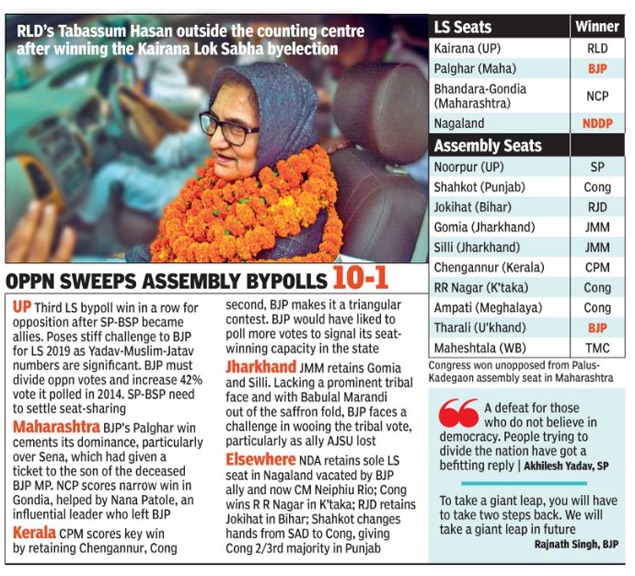
From: Sandeep Rai and Pankaj Shah, May 31, 2018: The Times of India
HIGHLIGHTS
The results appeared more slanted against the BJP after taking into account the parties that had won these seats before bypolls were necessitated.
In a big setback to the ruling BJP, opposition parties on Thursday won 11 bypolls, limiting the saffron party and its allies to just three. The opposition made impressive gains in the bypolls to four Lok Sabha and 10 Assembly seats spread across 11 states -- riding high on strengthening non-BJP unity in run-up to the 2019 general elections.
With prestige at stake in every single bypoll, the BJP lost the high-profile Kairana Lok Sabha seat in politically important Uttar Pradesh to a united Opposition after a communally-charged election campaign. The party also lost the Bhandara-Gondiya Lok Sabha seat in Maharashtra.
However, the BJP retained another Lok Sabha seat from Maharashtra, Palghar, where it had faced a challenge from its own ally Shiv Sena. BJP's Rajendra Gavit won the seat defeating Shiv Sena's Shrinivas Wanaga by 29574 votes. In Palghar, the opposition could not pose a united fight.
The fourth Lok Sabha seat, Nagaland, for which bypoll was held earlier this week went in favour of the Nationalist Democratic Progressive Party (NDPP), a BJP allly in the northeastern state.
While the Lok Sabha bypoll results appeared equally divided at 2-2 between the BJP-plus-allies and the opposition parties, figures for the 10 assembly bypolls came as a big setback for the ruling party which could manage just one (in Uttarakhand), while Congress bagged three (in Meghalaya, Karnataka and Punjab's Shahkot) and others got six -- JMM got two in Jharkhand, while CPM, SP, RJD and Trinamool one each in Kerala, UP, Bihar and West Bengal, respectively.
The results appeared more slanted against the BJP after taking into account the parties that had won these seats before bypolls were necessitated. While the BJP alliance retained two Lok Sabha seats -- one in Maharashtra and another in Nagaland -- it failed to retain two others -- UP's Kairana and Maharashtra's Bhandara-Gondiya.
Similarly in 10 assembly seats, the BJP and its allies failed to retain seats like Noorpur in UP and Shahkot in Punjab, while the opposition parties such as Congress, CPM, Jharkhand Mukti Morcha and Trinamool retained their respective seats.
The BJP retained Tharali assembly seat in Uttarakhand, but Samajwadi Party snatched Noorpur in neighbouring UP from the saffron party. SP's Naeemul Hasan cruised ahead of his nearest BJP rival Avni Singh to win this seat.
In Bihar, opposition RJD won Jokihat assembly seat by defeating BJP's ally JD(U) by a huge margin. The result was being seen as a big jolt to Chief Minister Nitish Kumar who dumped the RJD and Congress last year to join hands with the BJP to form a new coalition government in Bihar.
Rashtriya Lok Dal's Tabassum Hasan, supported by the Congress, Samajwadi Party and the Bahujan Samaj Party, established an early lead over Mriganka Singh right from the beginning to establish an almost invincible lead by noon. In Maharashtra, the BJP retained Palghar but was staring at defeat in the Bhandara-Gondiya Lok Sabha constituency, which the BJP had won in the 2014 elections. The NCP's Madhukar Kukade was leading over the BJP's Hemant Patle, as per latest trends.
The Congress has won one assembly seat in Maharashtra without any contest after all other parties withdrew their candidates.
Punjab's ruling Congress candidate Hardev Singh Ladi wrested the Shahkot assembly seat from the Shiromani Akali Dal, defeating the party's nominee Naib Singh Kohar with a margin of 38,801 votes, an election office spokesperson said. Chief Minister Amarinder Singh hailed the Congress victory as a "vindication" of the government's people-centric policies, a rejection of the "negative" politics of SAD and "decimation" of AAP.
Trinamool's Dulal Das won Maheshtala assembly bypoll in West Bengal, defeating BJP's Sujit Kumar Ghosh by 62,827 votes.
Kerala's ruling CPI(M)-led LDF's Saji Cheriyan also won the Chengannur Assembly bypoll by a huge margin of 20,956 votes over his nearest Congress rival D Vijaykumar, while the BJP candidate came third.
JMM retained both Silli and Gomia assembly seats in Jharkhand. In Gomia, JMM's Babita Devi defeated AJSU nominee Lambodar Mahto by 13,00 votes while BJP's nominee Madhavlal Singh stood third on the seat.
In Silli, JMM's Seema Mahto defeated AJSU chief and former state Deputy Chief Minister Sudesh Mahto by 13,000 votes.
June 1, 2018: The Times of India

From: June 1, 2018: The Times of India
Worrying as the 3-12 scoreline in Thursday’s bypoll results would be for BJP, what may cause the party even greater concern is that these results are not merely a reflection of opposition unity but of an erosion in its vote share as well.
The result in Kairana best illustrates this fact. In 2014, BJP had polled 50.6% of the votes. Had it been able to repeat that, no amount of coming together by the rest could have defeated the party. But as in Gorakhpur and Phulpur earlier this year, the arithmetic of opposition unity combined with a drop in BJP votes — to 46.5% — to deliver an adverse verdict.
What’s happened to vote shares is more difficult to work out in the other three Lok Sabha bypolls. In the two Maharashtra constituencies, Palghar and Bhandara-Gondiya, BJP’s vote share dropped by about nine percentage points and nearly 23 percentage points respectively. But then, its votes in 2014 included Sena’s support base since the two parties had contested as allies. So exactly how much of an erosion there is in the BJP vote is difficult to say. What is certain, however, is an increase in the Congress-NCP combine’s vote share in Bhandara-Gondiya by more than eight percentage points since 2014. In Palghar, in contrast, this alliance was reduced to also ran status as the contest became between the BJP, Sena and BVA.
In the remaining Lok Sabha bypoll, in Nagaland, it was a repeat of a contest between two NDA constituents with NPF and NDPP facing off. As in the assembly polls, BJP backing NDPP seems to have tilted the balance.
Analysing vote shares in the 10 assembly contests shows that in most cases BJP’s vote share has declined. However, it has risen in Maheshtala in West Bengal to the extent that the party has taken second spot ahead of CPM, furthering a trend noticed in the recent local body polls. BJP’s vote share has risen significantly in Noorpur in Uttar Pradesh, from 39% in last year’s assembly polls to 47.2% now. But that was simply not enough to match the united strength of the opposition.
Beyond the big states of UP and Maharashtra, what would cause BJP some concern is the decline in its vote share in Chengannur in Kerala from 29.3% in the 2016 assembly polls to 23.2% now. Seen as a stronghold of the Nair community, BJP would have hoped for a better showing in this seat if it is to make serious inroads in a state that has proved a hard nut to crack for the party.
With the result in RR Nagar in Bengaluru showing an uptick in Congress vote share and in the combined Congress-JD(S) share from the 2013 assembly polls, it would appear that BJP’s hopes that the voters of the state will be disgusted with an ‘unprincipled’ alliance have been dashed.
Akhilesh’s absence, Maya’s silence helped
Neha Lalchandani, June 1, 2018: The Times of India
HIGHLIGHTS
Party sources said Akhilesh did not campaign in Kairana as that could have brought back memories of the 2013 riots
Likewise, Mayawati’s complete silence after directing party cadres to work in tandem with SP-RLD counterparts was deliberate, claimed sources
SP chief Akhilesh Yadav’s strategic decision to not campaign in Kairana and Noorpur and the studied silence of BSP supremo Mayawati after directing her party cadres to support SP-RLD candidates paid off for the opposition. In 2014, BJP had pulled off a massive victory in Kairana by consolidating Hindu votes in the aftermath of the 2013 Muzaffarnagar riots.
“The riots took place when SP was in power with Jats pitching against Muslims. This time, SP took a conscious decision that Akhilesh would not campaign there so that BJP doesn’t get a chance to polarise,” said party insiders, adding that both the opposition candidates were Muslims.
Party sources further said Akhilesh did not campaign in Kairana as that could have brought back memories of the 2013 riots.
Likewise, Mayawati’s complete silence after directing party cadres to work in tandem with SP-RLD counterparts was deliberate, claimed BSP sources. They said Mayawati did not openly support SP-RLD to prevent BJP from consolidating Dalit votes — who comprise 15% of the total electorate — along with Jats and Gujjars.
“Mayawati didn’t need to say anything since she had already clarified that BSP-SP alliance had reached the point of finalising seat-sharing,” said a BSP member.
At a presser on Thursday, Akhilesh brushed aside a question on why he didn’t go for canvassing in Kairana with a humorous quip, “I didn’t go to campaign because I got scared of Yogiji’s speeches.” He added, “BJP has been defeated in its own lab and the result is the victory of the people who believe in communal amity and peace.”
States ruled by the NDA
Kaushik Deka , Restless bedfellows “India Today” 19/2/2018
See graphic
2020
The Top politicians of the year
December 27, 2020: The Times of India
Top politicians of the year 2020
Even in a normal, mask-free year, politicians and their politics have a central role in our lives. Then came 2020 which upended not only many of our plans but also our lives. In this moment of crisis, the world looked up to its leaders.
TOI takes a look at the top politicians of the year 2020
1 Narendra Modi
Narendra Modi, into the second year of his second term, continues to stand tall among all the leaders in the country. His command over the masses has shown no significant signs of dilution.
Even in a year ravaged by the coronavirus pandemic coupled with the economic downslide, his personal reputation seems rather enhanced since the pandemic. Many national surveys have pointed to his unmatched popularity. His party continues to make headway in previously uncharted territories like Telangana, and Jammu and Kashmir.
The PM made sure BJP emerged as the largest party in Bihar despite an anti-incumbency sentiment. The PM would look to continue his party's ascendance well into 2021, with polls in Tamil Nadu, Bengal and Assam of particular significance.
2 Rahul Gandhi
All said and done, Rahul Gandhi remains an important political figure in India. The year 2020 hasn't been very kind to either Rahul or the Congress. His party failed to win a single seat in Delhi and in Bihar, its dismal performance snatched defeat from the jaws of victory for the Grand Alliance.
His Hathras visit with Priyanka was lauded by many and showed the potential the party has if only its leadership puts in the effort. If an anti-BJP alliance has to be stitched nationally by the likes of Pawar, Mamata, Akhilesh and others, it cannot be without Congress. And for that to happen, Rahul Gandhi needs to get his act together. One way or the other, he has to clearly decide whether he wants to call the shots from behind or lead from the front.
A Congress freed of its leadership question can then move on to challenge the BJP.
3 Tejashwi Yadav
For months leading up to the Bihar polls, the RJD leader was considered no match for his seasoned opponent Nitish Kumar. He was brushed aside by all, with a BJP-JD(U) return all but certain. Tejashwi proved all those predictions wrong as he ran an electric campaign on jobs for the youth, consciously moving away from his party's Muslim-Yadav identity.
His rallies gathered immense support from the public and if not for the abysmal performance by Congress, he could well have been the youngest CM of India.
As things stand, Tejashwi has had a wonderful 2020 but the challenge would now be to keep up his momentum for the next opportunity.
4 Asaduddin Owaisi
The 2020 Bihar elections confirmed the rise of Owaisi as a growing national leader. His party AIMIM has been working hard over the years to shed it's image of being only a Hyderabad-based party; the Bihar elections put it on the national stage.
Winning five seats from the Muslim majority region of Seemanchal, Owaisi's party upset the calculations of RJD-led Grand Alliance. Buoyed by his party's performance in Bihar, Owaisi has already declared his plans to foray into West Bengal and Uttar Pradesh in the next Assembly elections. His party's performance in the next two-three years could shape national politics significantly.
5 Arvind Kejriwal
By winning the Delhi assembly election, Kejriwal and his party have shown the opposition that BJP is fallible and can be defeated.
In the run up to the polls he did not take BJP’s nationalism bait. Instead he focussed his campaign on development. He has shown some political nous; unlike many opposition leaders he hasn’t taken pot shots at Narendra Modi.
The coronavirus crisis however fizzled out the euphoric atmosphere around him as Delhi became one of the epicenter of the disease. His handling of the pandemic came under criticism, as did his decision to hold a Puja at Akshardham temple in the middle of a pandemic.
AAP's decision to contest the UP and Uttarakhand assembly elections once again reaffirmed Kejriwal's ambition to be more than Delhi CM. It would be interesting to see if he has learnt his lessons from the drubbing in 2014 Lok Sabha polls.
6 Uddhav Thackeray
Not many people gave the Maha Vikas Aghadi more than six months in the government but the alliance between Shiv Sena, NCP and Congress seems secure for now. He has tactfully manoeuvered the alliance without any major hiccups. His handling of the coronavirus crisis, his calm demeanour and frequent addresses to the state have been commended by many.
He has worked extensively with Sharad Pawar to keep his government afloat. Uddhav has tried to remodel his party on governance, administration and has kept its Hindutva plank on the back burner.
His alliance too is an example for the opposition to consider if it wants to keep BJP out of the government.
7 Yogi Adityanath
From recovering damages from CAA protesters to the love-jihad ordinance, Yogi has become the innovator in BJP circles. His handling of the coronavirus crisis has been lauded as well, particularly his decision to send buses for migrant workers returning home during the lockdown.
Party leaders from other states have been following his cue and he continues to be in demand wherever the party contests elections.
His clout in the party has been growing since he became the CM and his presence alongside PM Modi at the Ayodhya temple event was another example of that.
2021
Assembly elections
Highlights
May 3, 2021: The Times of India
In the 1990s, regional parties chipped away at Congress’s hold on power, with the United Front government marking the high point of the process, vastly enhancing the clout they first wielded during the V P Singh-led coalition, propped up from outside by BJP and Left Front. They were part of the power equation when Congress-led UPA held office and have proved resilient even after PM Modi won back-to-back Lok Sabha majorities.
States along the east coast present an unbroken line of non-BJP, non-Congress parties who have successfully held office, repeatedly winning elections. The success of Mamata Banerjee and M K Stalin is part of this picture with Pinarayi Vijayan adding to the score in this round of polls. CPM, after its marginalisation in the rest of the country, looks more like a regional formation now.
The most watched contest was Bengal where the scale of TMC’s win has buried BJP’s hopes. In Stalin, DMK has found a new icon and a successor to M Karunanidhi. Vijayan’s dominance over Kerala and his party is sealed with the win as several seniors will no longer pose a challenge to him. Elsewhere, the MVA government in Maharashtra is led by Uddhav Thackeray’s Shiv Sena, a regional entity.
BJP yet to find success formula for south & east
Held together with the aim to keep BJP out of office in Maharashtra, MVA is a serious hurdle for the saffron party. MVA constituent NCP, for all practical purposes, is also a party limited to the state. NDA’s preponderance has denied RJD power in Bihar but neighbouring Jharkhand has a JMMled government.
The scenario changes when it comes to national polls, with Modi proving to be a strong vote aggregator. BJP has made gains in Odisha but BJD has not been swept away.
In 2019 LS polls, DMK dominated Tamil Nadu and Sunday’s result can be seen as a continuation of that trend. YSRCP and TRS have done well in Lok Sabha polls too.
The south and eastin particular present challenges to BJP even though it continues to gain in vote share and legislative strength.
BJP surprised Mamata by winning 18 Lok Sabha seats in 2019, but she has now struck back.
B
May 3, 2021: The Times of India
This round of assembly elections had many firsts, not the least among them being Mamata Banerjee emerging as the first female CM of a major state to win a third successive term in office.
While she did that in part by completely decimating the Left and Congress – a blank slate for them in Bengal being another first – the Left chalked up its own first by winning a second successive term in Kerala and that too with an even bigger win than five years ago, 99 seats compared to 91.
Losers and winners
BJP matched its highest-ever tally in Tamil Nadu of four seats and skyrocketed from just three assembly seats to 77 in West Bengal, but sunk back to no seats in Kerala, a state where it had hoped to emerge as a significant third force.
In a year in which Covid has hogged the headlines, it is telling that health minister K K Shailaja or Shailaja Teacher as she is popularly known, had the highest margin in Kerala of nearly 61,000 votes with CM Pinarayi Vijayan (incidentally the oldest of the CMs in this round) a distant second on this count.
In a contest that was so one-sided in Bengal, it is a measure of BJP’s social engineering efforts that in the 84 reserved seats, the party almost equalled Trinamool Congress’s (TMC’s) tally winning 41 and losing 43 to TMC.
The Bengal poll results also meant that the state has lived up to its reputation of giving a party or front a long rope. Congress governed for the first two decades after Independence, the Left for over three decades and now Mamata Banerjee is guaranteed at least 15 years in office.
By-elections, May 2021
May 3, 2021: The Times of India
Setback for Cong, MVA in bypolls
There were no surprises in the results of the bypolls for the four Lok Sabha seats in Karnataka, Kerala, Tamil Nadu and Andhra Pradesh on Sunday with the parties which had won in the last elections retaining the respective seats.
However, in the assembly bypolls held across 10 states, while most parties succeeded in retaining their respective seats, the MVA coalition in Maharashtra suffered a setback when NCP lost Pandharpur-Mangalwedha to BJP by a narrow margin.
In Karnataka, Congress suffered a setback as it could retain only one of the two seats where bypolls were held. In the LS bypolls, while Congress was poised to retain the Kanyakumari seat in TN with a comfortable margin, IUML held on to Malappuram in Kerala and YSRCP retained Tirupati in Andhra Pradesh. In Karnataka, BJP managed to scrape through in Belagavi with Mangala Angadi, the widow of ex-Union minister Suresh Angadi, defeating Congress candidate Satish Jarkiholi. In Malappuram, IUML’s M P Abdussamad Samadani defeated the CPM nominee by a margin of 1,14,615 votes.
YSRCP retained Tirupati seat by 2.7 lakh votes. In Kanyakumari, Congress’s V Vijayakumar was leading against ex-Union minister and BJP veteran Pon Radhakrishnan by over 1.3 lakh votes after the 31st round of counting.
In the assembly bypolls, NCP failed to retain Pandharpur-Mangalwedha in Maharashtra, losing to BJP. In Karnataka, Congress managed to retain the Maski seat but lost Basavakalyan to BJP. In Telangana, the governing TRS won the Nagarjunasagar bypoll. In Jharkhand, JMM retained the Madhupur seat, defeating BJP. In Rajasthan, Congress retained Sujangarh and Sahara and BJP held on to Rajsamand. In Gujarat, BJP won the Morva Hadaf seat. In MP, Congress retained Damoh. In Uttarakhand, BJP succeeded in retaining the Salt seat. In Mizoram, ZPM leader Lalduhoma won Serchhip.
See also
Assets of legislators (PM, CMs, Ministers, MPs, MLAs...): India
India, A brief history: 1947 onwards
Elections in India: behaviour and trends (historical)
Elections in India: behaviour and trends (2014)
India: A political history, 1947 onwards
